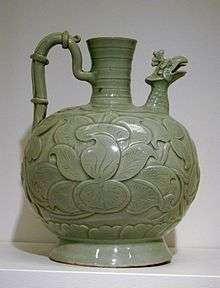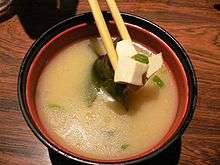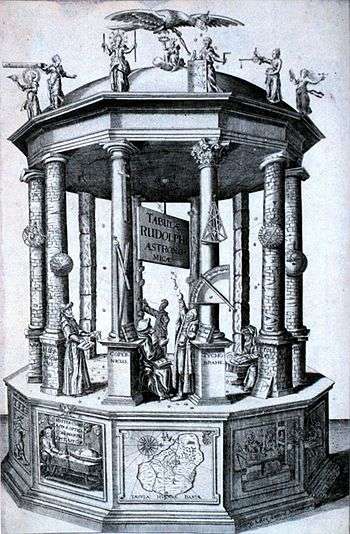List of Chinese inventions
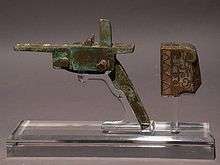

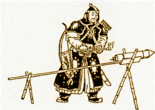 |
| History of science and technology in China |
|---|
| By subject |
| By era |
China has been the source of many innovations, scientific discoveries and inventions.[1] This includes the Four Great Inventions: papermaking, the compass, gunpowder, and printing (both woodblock and movable type). The list below contains these and other inventions in China attested by archaeological or historical evidence.
The historical region now known as China experienced a history involving mechanics, hydraulics and mathematics applied to horology, metallurgy, astronomy, agriculture, engineering, music theory, craftsmanship, naval architecture and warfare. By the Warring States period (403–221 BC), inhabitants of the Warring States had advanced metallurgic technology, including the blast furnace and cupola furnace, while the finery forge and puddling process were known by the Han Dynasty (202 BC–AD 220). A sophisticated economic system in imperial China gave birth to inventions such as paper money during the Song Dynasty (960–1279). The invention of gunpowder during the mid 9th century led to an array of inventions such as the fire lance, land mine, naval mine, hand cannon, exploding cannonballs, multistage rocket and rocket bombs with aerodynamic wings and explosive payloads. With the navigational aid of the 11th century compass and ability to steer at high sea with the 1st century sternpost rudder, premodern Chinese sailors sailed as far as East Africa.[2][3][4] In water-powered clockworks, the premodern Chinese had used the escapement mechanism since the 8th century and the endless power-transmitting chain drive in the 11th century. They also made large mechanical puppet theaters driven by waterwheels and carriage wheels and wine-serving automatons driven by paddle wheel boats.
The contemporaneous Peiligang and Pengtoushan cultures represent the oldest Neolithic cultures of China and were formed around 7000 BC.[5] Some of the first inventions of Neolithic China include semilunar and rectangular stone knives, stone hoes and spades, the cultivation of millet, rice, and the soybean, the refinement of sericulture, the building of rammed earth structures with lime-plastered house floors, the creation of pottery with cord-mat-basket designs, the creation of pottery tripods and pottery steamers and the development of ceremonial vessels and scapulimancy for purposes of divination.[6][7] The British sinologist Francesca Bray argues that the domestication of the ox and buffalo during the Longshan culture (c. 3000–c. 2000 BC) period, the absence of Longshan-era irrigation or high-yield crops, full evidence of Longshan cultivation of dry-land cereal crops which gave high yields "only when the soil was carefully cultivated," suggest that the plough was known at least by the Longshan culture period and explains the high agricultural production yields which allowed the rise of Chinese civilization during the Shang Dynasty (c. 1600–c. 1050 BC).[8] Later inventions such as the multiple-tube seed drill and heavy moldboard iron plough enabled China to sustain a much larger population through greater improvements in agricultural output.
For the purposes of this list, inventions are regarded as technological firsts developed in China, and as such does not include foreign technologies which the Chinese acquired through contact, such as the windmill from the Middle East or the telescope from early modern Europe. It also does not include technologies developed elsewhere and later invented separately by the Chinese, such as the odometer, water wheel, and chain pump. Scientific, mathematical or natural discoveries, changes in minor concepts of design or style and artistic innovations do not appear on the list.
Four Great Inventions
The following is a list of the Four Great Inventions—as designated by Joseph Needham (1900–1995), a British scientist, author and sinologist known for his research on the history of Chinese science and technology.[9]


Paper
- This sub-section is about paper making; for the writing material first used in ancient Egypt, see papyrus.
Although it is recorded that the Han Dynasty (202 BC – AD 220) court eunuch Cai Lun (50 AD – AD 121) invented the pulp papermaking process and established the use of new materials used in making paper, ancient padding and wrapping paper artifacts dating to the 2nd century BC have been found in China, the oldest example of pulp papermaking being a map from Fangmatan, Tianshui;[10] by the 3rd century, paper as a writing medium was in widespread use, replacing traditional but more expensive writing mediums such as strips of bamboo rolled into threaded scrolls, strips of silk, wet clay tablets hardened later in a furnace, and wooden tablets.[11][12][13][14][15] The earliest known piece of paper with writing on it was discovered in the ruins of a Chinese watchtower at Tsakhortei, Alxa League, where Han Dynasty troops had deserted their position in AD 110 following a Xiongnu attack.[16] In the paper making process established by Cai in 105, a boiled mixture of mulberry tree bark, hemp, old linens and fish nets created a pulp that was pounded into paste and stirred with water; a wooden frame sieve with a mat of sewn reeds was then dunked into the mixture, which was then shaken and then dried into sheets of paper that were bleached under the exposure of sunlight; K.S. Tom says this process was gradually improved through leaching, polishing and glazing to produce a smooth, strong paper.[13][14]
Printing
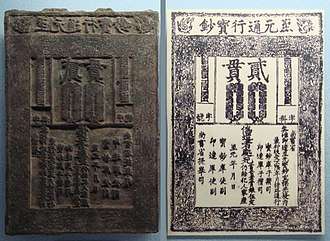
- For the separate invention of movable type printing in medieval Europe, see printing press and Johannes Gutenberg.
Woodblock printing: The earliest specimen of woodblock printing is a single-sheet dharani sutra in Sanskrit that was printed on hemp paper between 650 and 670 AD; it was unearthed in 1974 from a Tang tomb near Xi'an.[17] A Korean miniature dharani Buddhist sutra discovered in 1966, bearing extinct Chinese writing characters used only during the reign of China's only self-ruling empress, Wu Zetian (r.690–705), is dated no earlier than 704 and preserved in a Silla Korean temple stupa built in 751.[18] The first printed periodical, the Kaiyuan Za Bao was made available in AD 713. However, the earliest known book printed at regular size is the Diamond Sutra made during the Tang Dynasty (618–907), a 5.18 m (17 ft) long scroll which bears the date 868 AD.[19] Joseph Needham and Tsien Tsuen-hsuin write that the cutting and printing techniques used for the delicate calligraphy of the Diamond Sutra book are much more advanced and refined than the miniature dharani sutra printed earlier.[19]
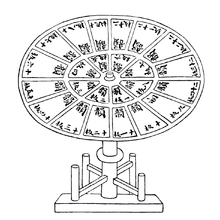
Movable type: The polymath scientist and official Shen Kuo (1031–1095) of the Song Dynasty (960–1279) was the first to describe the process of movable type printing in his Dream Pool Essays of 1088. He attributed the innovation of reusable fired clay characters to a little-known artisan named Bi Sheng (990–1051).[20][21][22][23] Bi had experimented with wooden type characters, but their use was not perfected until 1297 to 1298 with the model of the official Wang Zhen (fl. 1290–1333) of the Yuan Dynasty (1271–1368), who also arranged written characters by rhyme scheme on the surface of round table compartments.[21][24] It was not until 1490 with the printed works of Hua Sui (1439–1513) of the Ming Dynasty (1368–1644) that the Chinese perfected metal movable type characters, namely bronze.[25][26] The Qing Dynasty (1644–1912) scholar Xu Zhiding of Tai'an, Shandong developed vitreous enamel movable type printing in 1718.[27]
Gunpowder
Evidence of gunpowder's first use in China comes from the Tang dynasty (618–907).[28] The earliest known recorded recipes for gunpowder were written by Zeng Gongliang, Ding Du and Yang Weide in the Wujing Zongyao, a military manuscript compiled in 1044 during the Song Dynasty (960–1279). Its gunpowder formulas describe the use of incendiary bombs launched from catapults, thrown down from defensive walls, or lowered down the wall by use of iron chains operated by a swape lever.[29][30][31] Bombs launched from trebuchet catapults mounted on forecastles of naval ships ensured the victory of Song over Jin forces at the Battle of Caishi in 1161, while the Mongol Yuan Dynasty (1271–1368) used gunpowder bombs during their failed invasion of Japan in 1274 and 1281.[30] During the 13th and 14th centuries, gunpowder formulas became more potent (with nitrate levels of up to 91%) and gunpowder weaponry more advanced and deadly, as evidenced in the Ming Dynasty (1368–1644) military manuscript Huolongjing compiled by Jiao Yu (fl. 14th to early 15th century) and Liu Bowen (1311–1375). It was completed in 1412, a long while after Liu's death, with a preface added by the Jiao in its Nanyang publication.[32]
Compass
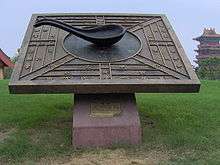
Although an ancient hematite artifact from the Olmec era in Mexico dating to roughly 1000 BC indicates the possible use of the lodestone compass long before it was described in China, the Olmecs did not have iron which the Chinese would discover could be magnetised by contact with lodestone.[34] Descriptions of lodestone attracting iron were made in the Guanzi, Master Lu's Spring and Autumn Annals and Huainanzi.[35][36][37] The Chinese by the Han Dynasty (202 BC – 220 AD) began using north-south oriented lodestone ladle-and-bowl shaped compasses for divination and geomancy and not yet for navigation.[38][39][40] The Lunheng, written by Han dynasty writer, scientist, and philosopher Wang Chong (27 – c. 100 AD) stated in chapter 52: "This instrument resembles a spoon and when it is placed on a plate on the ground, the handle points to the south".[41][42] There are, however, another two references under chapter 47 of the same text to the attractive power of a magnet according to Needham (1986),[43] but Li Shu-hua (1954) considers it to be lodestone, and states that there is no explicit mention of a magnet in Lunheng.[33] The Chinese polymath Shen Kuo (1031–1095) of the Song Dynasty (960–1279) was the first to accurately describe both magnetic declination (in discerning true north) and the magnetic needle compass in his Dream Pool Essays of 1088, while the Song dynasty writer Zhu Yu (fl. 12th century) was the first to mention use of the compass specifically for navigation at sea in his book published in 1119.[22][39][44][45][46][47][48] Even before this, however, the Wujing Zongyao military manuscript compiled by 1044 described a thermoremanence compass of heated iron or steel shaped as a fish and placed in a bowl of water which produced a weak magnetic force via remanence and induction; the Wujing Zongyao recorded that it was used as a pathfinder along with the mechanical south-pointing chariot.[49][50]
Pre-Shang
Inventions which originated in what is now China during the Neolithic age and prehistoric Bronze Age are listed in alphabetical order below.

- Alcoholic beverage and the process of fermentation: The earliest archaeological evidence of fermentation and the consumption of alcoholic beverages was discovered in neolithic China dating from 7000–6600 BC. Examination and analysis of ancient pottery jars from the neolithic village of Jiahu in Henan province in northern China revealed fermented residue left behind by the alcoholic beverages they once contained. According to a study published in the Proceedings of the National Academy of Sciences, chemical analysis of the residue revealed that the fermented drink was made from fruit, rice and honey.[51][52] Elsewhere in the world, fermented beverages have been found dating from 6000 BC in Georgia,[53] 3150 BC in ancient Egypt,[54] 3000 BC in Babylon,[55] 2000 BC in pre-Hispanic Mexico,[55] and 1500 BC in Sudan.[56]
- Bell: Clapper-bells made of pottery have been found in several archaeological sites.[57] The earliest metal bells, with one found in the Taosi site, and four in the Erlitou site, dated to about 2000 BC, may have been derived from the earlier pottery prototype.[58] Early bells not only have an important role in generating metal sound, but arguably played a prominent cultural role. With the emergence of other kinds of bells during the Shang Dynasty (c. 1600 – c. 1050 BC), they were relegated to subservient functions; at Shang and Zhou sites, they are also found as part of the horse-and-chariot gear and as collar-bells of dogs.[59]
- Coffin, wooden: The earliest evidence of wooden coffin remains, dated at 5000 BC, was found in the Tomb 4 at Beishouling, Shaanxi. Clear evidence of a wooden coffin in the form of a rectangular shape was found in Tomb 152 in an early Banpo site. The Banpo coffin belongs to a four-year-old girl, measuring 1.4 m (4.5 ft) by 0.55 m (1.8 ft) and 3–9 cm thick. As many as 10 wooden coffins have been found from the Dawenkou culture (4100–2600 BC) site at Chengzi, Shandong.[60][61] The thickness of the coffin, as determined by the number of timber frames in its composition, also emphasized the level of nobility, as mentioned in the Classic of Rites,[62] Xunzi[63] and Zhuangzi.[64] Examples of this have been found in several Neolithic sites; the double coffin, the earliest of which was found in the Liangzhu culture (3400–2250 BC) site at Puanqiao, Zhejiang, consists of an outer and an inner coffin, while the triple coffin, with its earliest finds from the Longshan culture (3000–2000 BC) sites at Xizhufeng and Yinjiacheng in Shandong, consists of two outer and one inner coffins.[65]
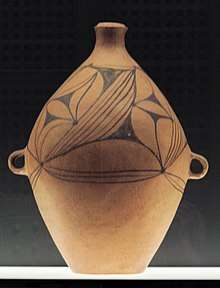
- Cookware and pottery vessel: The earliest pottery, used as vessels, was discovered in 2012, found in Xianrendong Cave located in the Jiangxi province of China.[66] The pottery dates to 20,000 to 19,000 BP.[67][68] The vessels may have been used as cookware, manufactured by hunter-gatherers.[68] The Israeli archaeologist Ofer Bar-Yosef reported that "When you look at the pots, you can see that they were in a fire."[69]

- Dagger-axe: The dagger-axe or ge was developed from agricultural stone implement during the Neolithic, dagger-axe made of stone are found in the Longshan culture (3000–2000 BC) site at Miaodian, Henan. It also appeared as ceremonial and symbolic jade weapon at around the same time, two being dated from about 2500 BC, are found at the Lingjiatan site in Anhui.[70] The first bronze ge appeared at the early Bronze Age Erlitou site,[70] where two were being found among the over 200 bronze artifacts (as of 2002) at the site,[71] three jade ge were also discovered from the same site.[72] Total of 72 bronze ge in Tomb 1004 at Houjiazhuang, Anyang,[73] 39 jade ge in tomb of Fu Hao and over 50 jade ge at Jinsha site were found alone.[70] It was the basic weapon of Shang (c. 1600 – 1050 BC) and Zhou (c.1050–256 BC) infantry, although it was sometimes used by the "striker" of charioteer crews. It consisted of a long wooden shaft with a bronze knife blade attached at a right angle to the end. The weapon could be swung down or inward in order to hook or slash, respectively, at an enemy.[74] By the early Han Dynasty (202 BC – 220 AD), military use of the bronze ge had become limited (mostly ceremonial); they were slowly phased out during the Han Dynasty by iron spears and iron ji halberds.[75]
- Deepwater drilling: Some of the earliest evidence of water wells are located in China. The Chinese discovered and made extensive use of deep drilled groundwater for drinking. The Chinese text The Book of Changes, originally a divination text of the Western Zhou dynasty (1046 -771 BC), contains an entry describing how the ancient Chinese maintained their wells and protected their sources of water.[76] Archaeological evidence and old Chinese documents reveal that the prehistoric and ancient Chinese had the aptitude and skills for digging deep water wells for drinking water as early as 6000 to 7000 years ago. A well excavated at the Hemudu excavation site was believed to have been built during the Neolithic era.[77][78] The well was cased by four rows of logs with a square frame attached to them at the top of the well. 60 additional tile wells southwest of Beijing are also believed to have been built around 600 BC for drinking and irrigation.[77][79]
- Bricks, fired: The oldest fired bricks were found at the Neolithic Chinese site of Chengtoushan, dating back to 4400 BC.[80] They were made of red clay, baked on all sides, and used as flooring for houses. By 3300 BC, fired bricks were being used at Chengtoushan to pave roads and form building foundations, roughly at the same time as the Indus Valley Civilisation. While sun-dried bricks were used much earlier in Mesopotamia, fired bricks are significantly stronger as a building material. Bricks continued to be used during 2nd millennium BC at a site near Xi'an.[81] Fired bricks were found in Western Zhou (1046–771 BC) ruins, where they were produced on a large scale. The carpenter's manual Yingzao Fashi, published in 1103 during the medieval Chinese Song dynasty described the brick making process and glazing techniques then in use.[82][83][84]
- Gnomon: A painted stick dating from 2300 BCE excavated at the astronomical site of Taosi is the oldest gnomon known in China.[85] The gnomon was widely used in ancient China from the second century BC onward in order determine the changes in seasons, orientation, and geographical latitude. The ancient Chinese used shadow measurements for creating calendars that are mentioned in several ancient texts. According to the collection of Zhou Chinese poetic anthologies Classic of Poetry, one of the distant ancestors of King Wen of the Zhou dynasty used to measure gnomon shadow lengths to determine the orientation around the 14th-century BC.[86][87]
- Jadeworking: Chinese jade has played a role in China's science and technological history.[88] During Neolithic times, the key known sources of nephrite jade in China for utilitarian and ceremonial jade items were the now depleted deposits in the Ningshao area in the Yangtze River Delta (Liangzhu culture 3400–2250 BC) and in an area of the Liaoning province and Inner Mongolia (Hongshan culture 4700–2200 BC).[89] Dushan Jade was being mined as early as 6000 BC and the jade stone is the primary hardstone of Chinese sculpture. Jade was prized for its hardness, durability, musical qualities, and beauty.[90] In particular, its subtle, translucent colors and protective qualities[90] caused it to become associated with Chinese conceptions of the soul and immortality.[91] The most prominent early use was the crafting of the Six Ritual Jades found since the 3rd-millennium BC Liangzhu culture.[92]
- Lacquer: Lacquer was used in China since the Neolithic period and came from a substance extracted from the lac tree found in China.[93] A red wooden bowl, which is believed to be the earliest known lacquer container,[94] was unearthed at a Hemudu (c. 5000 BC – c. 4500 BC) site.[95] The British sinologist and historian Michael Loewe says coffins at many early Bronze Age sites seem to have been lacquered, and articles of lacquered wood may also have been common, but the earliest well-preserved examples of lacquer come from Eastern Zhou Dynasty (771 – 256 BC) sites.[96] However, Wang Zhongshu disagrees, stating that the oldest well-preserved lacquerware items come from a Xiajiadian (c.2000 – c.1600 BC) site in Liaoning excavated in 1977, the items being red lacquered vessels in the shape of Shang Dynasty bronze gu vessels.[95] Wang states that many lacquerware items from the Shang Dynasty (c.1600 – c.1050 BC), such as fragments of boxes and basins, were found, and had black designs such as the Chinese dragon and taotie over a red background.[95] Queen Fu Hao (died c. 1200 BC) was buried in a lacquered wooden coffin.[97] There were three imperial workshops during the Han Dynasty (202 BC – 220 AD) established solely for the purpose of crafting lacquerwares; fortunately for the historian, Han lacquerware items were inscribed with the location of the workshop where they were produced and the date they were made, such as a lacquerware beaker found in the Han colony in northwestern Korea with the inscription stating it was made in a workshop near Chengdu, Sichuan and dated precisely to 55 AD.[98]
- Millet cultivation: The discovery in northern China of domesticated varieties of broomcorn and foxtail millet from 8500 BC, or earlier, suggests that millet cultivation might have predated that of rice in parts of Asia.[99] Clear evidence of millet began to cultivate by 6500 BC at sites of Cishan, Peiligang and Jiahu.[100] Archaeological remains from Cishan sum up to over 300 storage pits, 80 with millet remains, with a total millet storage capacity estimated for the site of about 100,000 kg of grain.[101] By 4000 BC, most Yangshao areas were using an intensive form of foxtail millet cultivation, complete with storage pits and finely prepared tools for digging and harvesting the crop. The success of the early Chinese millet farmers is still reflected today in the DNA of many modern East Asian populations, such studies have shown that the ancestors of those farmers probably arrived in the area between 30,000 and 20,000 BP, and their bacterial haplotypes are still found in today populations throughout East Asia.[102]
- Rowing oar: Rowing oars have been used since the early Neothilic period; a canoe-shaped pottery and six wooden oars dating from the 6000 BC have been discovered in a Hemudu culture site at Yuyao, Zhejiang.[103][104] In 1999, an oar measuring 63.4 cm (2 ft) in length, dating from 4000 BC, has also been unearthed at Ishikawa Prefecture, Japan.[105]
- Plastromancy: The earliest use of turtle shells comes from the archaeological site in Jiahu site. The shells, containing small pebbles of various size, colour and quantity, were drilled with small holes, suggesting that each pair of them was tied together originally. Similar finds have also been found in the Dawenkou burial sites of about 4000–3000 BC, as well as in Henan, Sichuan, Jiangsu and Shaanxi.[106] The turtle-shell shakers for the most part are made of the shell of land turtles,[107] identified as Cuora flavomarginata.[108] Archaeologists believe that these shells were used either as rattles in ceremonial dances, shamantic healing tools or ritual paraphernalia for divinational purposes.[109]
- Ploughshare, triangular-shaped: Triangular-shaped stone ploughshares are found at the sites of Majiabang culture dated to 3500 BC around Lake Tai. Ploughshares have also been discovered at the nearby Liangzhu and Maqiao sites roughly dated to the same period. David R. Harris says this indicates that more intensive cultivation in fixed, probably bunded, fields had developed by this time. According to Mu Yongkang and Song Zhaolin's classification and methods of use, the triangular plough assumed many kinds and were the departure from the Hemudu and Luojiajiao spade, with the Songze small plough in mid-process. The post-Liangzhu ploughs used draft animals.[110][111]
- Pottery steamer: Archaeological excavations show that using steam to cook began with the pottery cooking vessels known as yan steamers; a yan composed of two vessel, a zeng with perforated floor surmounted on a pot or caldron with a tripod base and a top cover. The earliest yan steamer dating from about 5000 BC was unearthed in the Banpo site.[112] In the lower Yangzi River, zeng pots first appeared in the Hemudu culture (5000–4500 BC) and Liangzhu culture (3200–2000 BC) and used to steam rice; there are also yan steamers unearthed in several Liangzhu sites, including 3 found at the Chuodun and Luodun sites in southern Jiangsu.[113] In the Longshan culture (3000–2000 BC) site at Tianwang in western Shandong, 3 large yan steamers were discovered.[114]
- Pottery urn: The first evidence of pottery urn dating from about 7000 BC comes from the early Jiahu site, where a total of 32 burial urns are found,[115] another early finds are in Laoguantai, Shaanxi.[65] There are about 700 burial urns unearthed over the Yangshao (5000–3000 BC) areas and consisting more than 50 varieties of form and shape. The burial urns were used mainly for children, but also sporadically for adults, as shown in the finds at Yichuan, Lushan and Zhengzhou in Henan.[60] A secondary burials containing bones from child or adult are found in the urns in Hongshanmiao, Henan.[116] Small hole was drilled in most of the child and adult burial urns, and is believed to enable the spirit to access.[117] It is recorded in the Classic of Rites that the earthenware coffins were used in the time of legendary period,[118] the tradition of burying in pottery urns lasted until the Han Dynasty (202 BC–220 AD) when it gradually disappeared.[65]
.jpg)
- Quern stones: Quern stones were used in China at least 10,000 years ago to grind wheat into flour. The production of flour by rubbing wheat by hand took several hours.[119] Due to their form, dimensions, and the nature of the treatment of the surfaces, they reproduce precisely the most ancient implements used for grinding cereal grain into flour. Saddle querns were known in China during the Neolithic Age but rotary stone mills did not appear until the Warring States Period.[120] A prehistoric quern dating back to 23,000 BCE was found at the Longwangchan archaeological site, in Hukou, Shaanxi in 2007. The site is located in the heartland of the northern Chinese loess plateau near the Yellow River.[121]
- Rammed earth: The archaeological evidence of the use of rammed earth has been discovered in Neolithic archaeological sites of the Yangshao and Longshan cultures along the Chinese Yellow River, dating back to 5000 BC. By 2000 BC, rammed-earth architectural techniques were commonly used for walls and foundations in China.[122]
- Rice cultivation: In 2002, a Chinese and Japanese group reported the discovery in eastern China of fossilised phytoliths of domesticated rice apparently dating back to 11,900 BC or earlier. However, phytolith data are controversial in some quarters due to potential contamination problems.[123] It is likely that demonstrated rice was cultivated in the middle Yangtze Valley by 7000 BC, as shown in finds from the Pengtoushan culture at Bashidang, Changde, Hunan. By 5000 BC, rice had been domesticated at Hemudu culture near the Yangtze Delta and was being cooked in pots.[124] Although millet remained the main crop in northern China throughout history, several sporadic attempts were made by the state to introduce rice around the Bohai Gulf as early as the 1st century.[125]
- Saltern: One of the earliest salterns for the harvesting of salt is argued to have taken place on Lake Yuncheng, Shanxi by 6000 BC.[126] Strong archaeological evidence of salt making dating to 2000 BC is found in the ruins of Zhongba at Chongqing.[127][128]
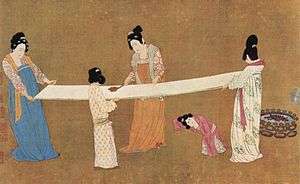
- Sericulture: Sericulture is the production of silk from silkworms. The oldest silk found in China comes from the Chinese Neolithic period and is dated to about 3630 BC, found in Henan province.[129] Silk items excavated from the Liangzhu culture site at Qianshanyang, Wuxing District, Zhejiang date to roughly 2570 BC, and include silk threads, a braided silk belt and a piece of woven silk.[129] A bronze fragment found at the Shang Dynasty (c. 1600 – c. 1050 BC) site at Anyang (or Yinxu) contains the first known written reference to silk.[130]
- Soybean cultivation: The cultivation of soybeans began in the eastern half of northern China by 2000 BC, but is almost certainly much older.[131] Liu et al. (1997) stated that soybean originated in China and was domesticated about 3500 BC.[132] By the 5th century, soybeans were being cultivated in much of East Asia, but the crop did not move beyond this region until well into the 20th century.[133] Written records of the cultivation and use of the soybean in China date back at least as far as the Western Zhou Dynasty.[134]
- Wet field cultivation and paddy field: Wet field cultivation, or the paddy field, was developed in China. The earliest paddy field dates to 6280 BP, based on carbon dating of the grains of rice and soil organic matter found at the Chaodun site in Kushan County.[135] Paddy fields have also been excavated by archaeologists at Caoxieshan, a site of the Neolithic Majiabang culture.[136]
Shang and later
Inventions which made their first appearance in China after the Neolithic age, specifically during and after the Shang Dynasty (c. 1600–1050 BC), are listed in alphabetical order below.
A
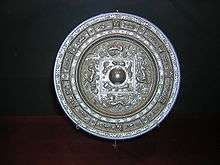
- Acupuncture: Acupuncture, the traditional Chinese medicinal practice of inserting needles into specific points of the body for therapeutic purposes and relieving pain, was first mentioned in the Huangdi Neijing compiled from the 3rd to 2nd centuries BC (Warring States period to Han Dynasty).[137] The oldest known acupuncture sticks made of gold, found in the tomb of Liu Sheng (d. 113 BC), date to the Western Han (203 BC – 9 AD); the oldest known stone-carved depiction of acupuncture was made during the Eastern Han (25–220 AD); the oldest known bronze statue of an acupuncture mannequin dates to 1027 during the Song Dynasty (960–1279).[138]
- Animal zodiac: The earliest and most complete version of the animal zodiac mentions twelve animals which differ slightly from the modern version (for instance, the Dragon is absent, represented by a worm).[139] Each animal matches the Earthly Branches and were written on bamboo slips from Shuihudi, dated to the late 4th century BC,[140] as well as from Fangmatan, dating to the late 3rd century BC.[140] Before these archaeological finds, the Lunheng written by Wang Chong (27 – c. 100 AD) during the 1st century provided the earliest transmitted example of a complete duodenary animal cycle.[141]
- Armillary sphere, hydraulic-powered: Hipparchus (c. 190 – c. 120 BC)[142] credited the Ancient Greek mathematician, geographer, astronomer, and poet Eratosthenes (276–194 BC) as the first to invent the armillary sphere representing the celestial sphere. However, the Chinese astronomer Geng Shouchang of the Han Dynasty (202 BC – 220 AD) invented it separately in China in 52 BC, while the Han dynasty polymath Zhang Heng (78–139 AD) was the first to apply motive power to the rotating armillary sphere by a set of complex gears rotated by a waterwheel which in turn was powered by the constant pressure head of an inflow clepsydra clock, the latter of which he improved with an extra compensating tank between the reservoir and the inflow vessel.[143][144][145][146][147]
- Artillery: Early Chinese artillery had vase-like shapes. This includes the "long range awe inspiring" cannon dated from 1350 and found in the 14th century Ming Dynasty treatise Huolongjing.[148] With the development of better metallurgy techniques, later cannons abandoned the vase shape of early Chinese artillery. This change can be seen in the bronze "thousand ball thunder cannon," an early example of field artillery.[149]
B
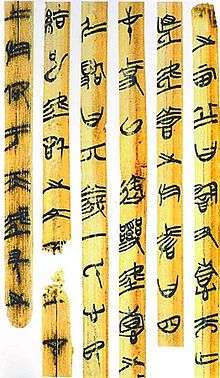


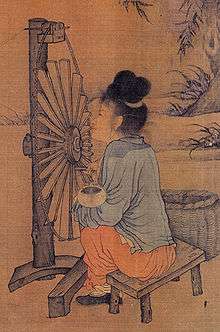
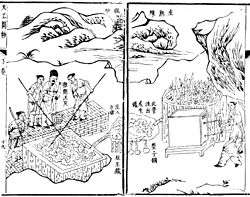
- Bamboo and wooden slips: Bamboo and wooden slips (Chinese: 简牍; pinyin: jiǎndú) were the main medium for documents in China before the widespread introduction of paper by the 2nd century AD. (Silk was occasionally used, but was prohibitively expensive.) The long, narrow strips of wood or bamboo typically carry a single column of brush-written text each, with space for several tens of visually complex ancient Chinese characters. For longer texts, many slips may be bound together in sequence with thread. Each strip of wood or bamboo is said to be as long as a chopstick and as wide as two. The earliest surviving examples of wood or bamboo slips date from the 5th century BC during the Warring States period. However, references in earlier texts surviving on other media make it clear that some precursor of these Warring States period bamboo slips was in use as early as the late Shang period (from about 1250 BC). Bamboo or wooden strips were the standard writing material during the Han dynasty and excavated examples have been found in abundance.[151] Bamboo tablets were used to write on before paper was invented by Cai Lun during the Han dynasty. Slats of bamboo stalks were sewn together used to make a kind of folding book.[152] Subsequently, the invention of paper during the Han dynasty began to displace bamboo and wooden strips from mainstream uses, and by the 4th century AD bamboo had been largely phased out as a medium for writing in China.
- Banknote: Paper currency was first developed in China. Its roots were in merchant receipts of deposit during the Tang Dynasty (618–907), as merchants and wholesalers desired to avoid the heavy bulk of copper coinage in large commercial transactions.[153][154][155] During the Song Dynasty (960–1279), the central government adopted this system for their monopolized salt industry, but a gradual reduction in copper production—due to closed mines and an enormous outflow of Song-minted copper currency into the Japanese, Southeast Asian, Western Xia and Liao Dynasty economies—encouraged the Song government in the early 12th century to issue government-printed paper currency alongside copper to ease the demand on their state mints and debase the value of copper.[156] In the early 11th century, the Song Dynasty government authorised sixteen private banks to issue notes of exchange in Sichuan, but in 1023 the government commandeered this enterprise and set up an agency to supervise the manufacture of banknotes there. The earliest paper currency was limited to certain regions and could not be used outside specified bounds, but once paper was securely backed by gold and silver stores, the Song Dynasty government initiated a nationwide paper currency, between 1265 and 1274.[155] The concurrent Jin Dynasty (1115–1234) also printed paper banknotes by at least 1214.[157]
- Bellows, hydraulic-powered: The manufacturing of different alloys in China often required a continuous stream of air that was able to be blown over through molten metals. The use of double-action piston bellows was described by Chinese philosopher Lao Tzu around 500 BC to produce a continuous stream of air.[158] Although it is unknown if metallurgic bellows (i.e. air-blowing device) in the Han Dynasty (202 BC – 220 AD) were of the leather bag type or the wooden fan type found in the later Yuan Dynasty (1279–1368), the Eastern Han dynasty mechanical engineer and politician Du Shi (d. 38 AD) applied the use of rotating waterwheels to power the bellows of his blast furnace smelting iron, a method which continued in use in China thereafter, as evidenced by subsequent records; it is a significant invention in that iron production yields were increased and it employed all the necessary components for converting rotary motion into reciprocating motion.[147][159][160][161][162]
- Belt drive: The mechanical belt drive, using a pulley machine, was first mentioned in the text the Dictionary of Local Expressions by the Han Dynasty philosopher, poet, and politician Yang Xiong (53–18 BC) in 15 BC, used for a quilling machine that wound silk fibers on to bobbins for weavers' shuttles.[150] The belt drive is an essential component to the invention of the spinning wheel.[163][164] The belt drive was not only used in textile technologies, it was also applied to hydraulic powered bellows dated from the 1st century AD.[163]
- Belt hook: The belt hook was a fastener used in China. Belt hooks date to the 7th century BC in China,[165] and were made with bronze, iron, gold, and jade.[165] Texts claim that the belt hook arrived in China from Central Asia during the Warring States period, but archaeological evidence of belt hooks in China predate the Warring States Period.[166]
- Bintie: Bintie (simplified Chinese: 镔铁; traditional Chinese: 鑌鐵) was a type of refined iron, which was known for its hardness. It was often used in the making of Chinese weapons. The metal alloy was an important article of income in medieval Yuan China as technological advances from the preceding Song dynasty improved Yuan smelting technology. Bintie was referred as "fine steel", due to its high carbon content.[167][168]
- Biological pest control: The first report of the use of an insect species to control an insect pest comes from "Nan Fang Cao Mu Zhuang" (南方草木狀 Plants of the Southern Regions) (ca. 304 AD), attributed to Western Jin dynasty botanist Ji Han (嵇含, 263–307), in which it is mentioned that "Jiaozhi people sell ants and their nests attached to twigs looking like thin cotton envelopes, the reddish-yellow ant being larger than normal. Without such ants, southern citrus fruits will be severely insect-damaged".[169] The ants used are known as huang gan (huang = yellow, gan = citrus) ants (Oecophylla smaragdina). The practice was later reported by Ling Biao Lu Yi (late Tang Dynasty or Early Five Dynasties), in Ji Le Pian by Zhuang Jisu (Southern Song Dynasty), in the Book of Tree Planting by Yu Zhen Mu (Ming Dynasty), in the book Guangdong Xing Yu (17th century), Lingnan by Wu Zhen Fang (Qing Dynasty), in Nanyue Miscellanies by Li Diao Yuan, and others.[169]
- Blast furnace: Although cast iron tools and weapons have been found in China dating to the 5th century BC, the earliest discovered Chinese blast furnaces, which produced pig iron that could be remelted and refined as cast iron in the cupola furnace, date to the 3rd and 2nd centuries BC, while the vast majority of early blast furnace sites discovered date to the Han Dynasty (202 BC – 220 AD) period immediately following 117 BC with the establishment of state monopolies over the salt and iron industries during the reign of Emperor Wu of Han (r. 141 – 87 BC); most ironwork sites discovered dating before 117 BC acted merely as foundries which made castings for iron that had been smelted in blast furnaces elsewhere in remote areas far from population centres.[170][171]
- Bombard weaponry: The oldest representation of a bombard can be found in the Chinese town of Ta-tsu. In 1985, the Canadian historian Robin Yates visited the Buddhist cave temples when he saw a sculpture on the wall depicting a demon holding a hand-held bombard. The muzzle seems to have a blast and flames coming from it which some believe is proof of some type of super gun. Yates examined the cave and believed the drawings dated back to the late 12th century.[172]
- Bomb, cast iron: The first accounts of bombs made of cast iron shells packed with explosive gunpowder—as opposed to earlier types of casings—were written in the 13th century in China.[173] The term was coined for this bomb (i.e. "thunder-crash bomb") during a Jin Dynasty (1115–1234) naval battle of 1231 against the Mongols.[174] The History of Jin (compiled by 1345) states that in 1232, as the Mongol general Subutai (1176–1248) descended on the Jin stronghold of Kaifeng, the defenders had a "thunder-crash bomb" which "consisted of gunpowder put into an iron container ... then when the fuse was lit (and the projectile shot off) there was a great explosion the noise whereof was like thunder, audible for more than a hundred li, and the vegetation was scorched and blasted by the heat over an area of more than half a mou. When hit, even iron armour was quite pierced through."[174] The Song Dynasty (960–1279) official Li Zengbo wrote in 1257 that arsenals should have several hundred thousand iron bomb shells available and that when he was in Jingzhou, about one to two thousand were produced each month for dispatch of ten to twenty thousand at a time to Xiangyang and Yingzhou.[175] The significance of this, as British sinologist, scientist, and historian Joseph Needham states, is that a "high-nitrate gunpowder mixture had been reached at last, since nothing less would have burst the iron casing."[176]
- Borehole drilling: By at least the Han Dynasty (202 BC – 220 AD), the Chinese used deep borehole drilling for mining and other projects; The British sinologist and historian Michael Loewe states that borehole sites could reach as deep as 600 m (2000 ft).[177] K.S. Tom describes the drilling process: "The Chinese method of deep drilling was accomplished by a team of men jumping on and off a beam to impact the drilling bit while the boring tool was rotated by buffalo and oxen."[178] This was the same method used for extracting petroleum in California during the 1860s (i.e. "Kicking Her Down").[178][179] A Western Han Dynasty bronze foundry discovered in Xinglong, Hebei had nearby mining shafts which reached depths of 100 m (328 ft) with spacious mining areas; the shafts and rooms were complete with a timber frame, ladders and iron tools.[180][181] By the first century BC, Chinese craftsmen cast iron drill bits and drillers were able to drill boreholes up to 4800 feet (1500 m) deep.[182][183][184] By the eleventh century AD, the Chinese were able to drill boreholes up to 3000 feet in depth. Drilling for boreholes was time consuming and long. As the depth of the holes varied, the drilling of a single well could up to nearly one full decade.[178] It wasn't up until the 19th century that Europe and the West would catch up and rival ancient Chinese borehole drilling technology.[184][179]
- Brandy: The traditional making of brandy has its roots in medieval China during the Tang dynasty. The Chinese started to distill brandy by heating wine in the 6th century AD.[185][186] By the 7th century AD, distilled wine was known and widespread through China. The production of frozen brandy was widespread among Central Asian tribes in the frigid climate in the third century AD.[187] This process was recorded in the Chinese compendium Records of the Investigations of Things by Zhang Hua of the Jin dynasty in 290 AD.[188]
- Breeching strap: The breeching strap traces its roots back to the Chinese invented breast-strap or "breastcollar" harness developed during the Warring States (481–221 BC) era.[189] The Chinese breast harness became known throughout Central Asia by the 7th century,[190] introduced to Europe by the 8th century.[190] The breeching strap would allow the horse to hold or brake the load as horse harnesses were previously attached to vehicles by straps around their necks as previously designed harnesses would constrict the horses neck preventing the horse from pulling heavier loads.[191] The breeching strap acted as a brake when a cart tries to run forward when moving downwards on a slope and also make it possible to maneuver the cart in the reverse direction.[192][191]
- Brine mining: Around 500 BCE, the ancient Chinese dug hundreds of brine wells, some of which were over 100 meters (330 feet) in depth. Large brine deposits under the earth's surface were drilled by drilling boreholes.[178] Bamboo towers were erected, similar in style to modern-day oil derricks.[193] Bamboo was used for ropes, casing, and derricks since it was salt resistant.[194] Iron wedges were hung from a bamboo cable tool attached to a lever on a platform constructed atop the tower. The derricks required two to three men jumping on and off the lever that moved the iron wedge pounded into the ground to dig a hole deep enough into the ground to hit the brine.[194][193]
- Bristle toothbrush: According to the United States Library of Congress website, the Chinese have used the bristle toothbrush since 1498, during the reign of the Hongzhi Emperor (r. 1487–1505) of the Ming Dynasty (1368–1644); it also adds that the toothbrush was not mass-produced until 1780, when they were sold by a William Addis of Clerkenwell, London, England.[195] In accordance with the Library of Congress website, scholar John Bowman also writes that the bristle toothbrush using pig bristles was invented in China during the 1490s.[26] While Bonnie L. Kendall agrees with this, she noted that a predecessor existed in ancient Egypt in the form of a twig that was frayed at the end.[196]

- Bulkhead partition: The 5th century book Garden of Strange Things by Liu Jingshu mentioned that a ship could allow water to enter the bottom without sinking, while the Song Dynasty author Zhu Yu (fl. 12th century) wrote in his book of 1119 that the hulls of Chinese ships had a bulkhead build; these pieces of literary evidence for bulkhead partitions are confirmed by archaeological evidence of a 24 m (78 ft) long Song Dynasty ship dredged from the waters off the southern coast of China in 1973, the hull of the ship divided into twelve walled compartmental sections built watertight, dated to about 1277.[197][198] Western writers from Marco Polo (1254–1324), to Niccolò Da Conti (1395–1469), to Benjamin Franklin (1706–1790) commented on bulkhead partitions, which they viewed as an original aspect of Chinese shipbuilding, as Western shipbuilding did not incorporate this hull arrangement until the early 19th century.[199][200]
C

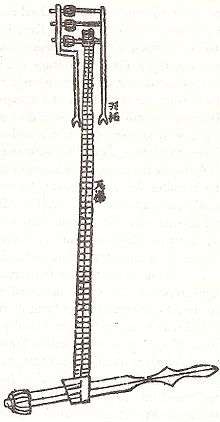
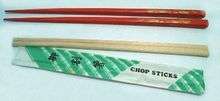
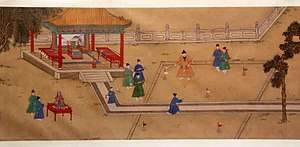

- Candle clock: Candle clocks have been used in China since at least the 6th century AD. The earliest reference of a candle clock is in a poem by You Jiangu around 520 AD.[203]
- Cannon: The earliest known depiction of a cannon is a sculpture from the Dazu Rock Carvings in Sichuan dated to 1128,[204] however the earliest archaeological samples and textual accounts do not appear until the 13th century. The primary extant specimens of cannon from the 13th century are the Wuwei Bronze Cannon dated to 1227, the Heilongjiang hand cannon dated to 1288, and the Xanadu Gun dated to 1298. However, only the Xanadu gun contains an inscription bearing a date of production, so it is considered the earliest confirmed extant cannon. The Xanadu Gun is 34.7 cm in length and weighs 6.2 kg. The other cannon are dated using contextual evidence.[205]
- Cast iron: Confirmed by archaeological evidence, cast iron, made from melting pig iron, was developed in China by the early 5th century BC during the Zhou Dynasty (1122–256 BC), the oldest specimens found in a tomb of Luhe County in Jiangsu province; despite this, most of the early blast furnaces and cupola furnaces discovered in China date after the state iron monopoly under Emperor Wu (r. 141–87 BC) was established in 117 BC, during the Han Dynasty (202 BC – 220 AD); Donald Wagner states that a possible reason why no ancient Chinese bloomery process has been discovered thus far is because the iron monopoly, which lasted until the 1st century AD when it was abolished for private entrepreneurship and local administrative use, wiped out any need for continuing the less-efficient bloomery process that continued in use in other parts of the world.[170][206][207][208][209] Wagner states that most iron tools in ancient China were made of cast iron in consideration of the low economic burden of producing cast iron, whereas most iron military weapons were made of more costly wrought iron and steel, signifying that "high performance was essential" and preferred for the latter.[210] As cast iron is comparatively brittle, it is not suitable for purposes where a sharp edge or flexibility is required. It is strong under compression, but not under tension. Cast iron found many uses in ancient Chinese society as it was poured into moulds to make ploughshares, cooking utensils as well as weapons and pagodas.[211] Cast iron would not become available in Europe until the 15th century, where Henry VIII initiated the casting of cannons and cannonballs in England.[212]
- Celadon: Named after a pale-tinted spring green colour, Chinese archaeologist Wang Zhongshu (1982) asserts that shards having this type of ceramic glaze have been recovered from Eastern Han Dynasty (25–220 AD) tomb excavations in Zhejiang; he also asserts that this type of ceramic became well known during the Three Kingdoms (220–265).[213] Richard Dewar (2002) disagrees with Wang's classification, stating that true celadon—which requires a minimum 1260 °C (2300 °F) furnace temperature, a preferred range of 1285° to 1305 °C (2345° to 2381 °F), and reduced firing—was not created until the beginning of the Northern Song Dynasty (960–1127).[214] The unique grey or green celadon glaze is a result of iron oxide's transformation from ferric to ferrous iron (Fe2O3 → FeO) during the firing process.[214] Longquan celadon wares, which the archeologist Nigel Wood at the University of Oxford writes were first made during the Northern Song, had bluish, blue-green, and olive green glazes and high silica and alkali contents which resembled later porcelain wares made at Jingdezhen and Dehua rather than stonewares.[215]
- Chain drive, endless power-transmitting: The Greek Philon of Byzantium (3rd or 2nd century BC)[216] described a chain drive and windlass used in the operation of a polybolos (a repeating ballista),[217][218] "but the chain drive did not continuously transmit power from shaft to shaft and hence they were not in the direct line of ancestry of the chain-drive proper".[219] A continuously driven chain drive first appeared in 11th century China. Perhaps inspired by chain pumps which had been known in China since at least the Han Dynasty (202 BC – 220 AD) when they were mentioned by the Han dynasty philosopher Wang Chong (27 – c. 100 AD),[220] the endless power-transmitting chain drive was first used in the gearing of the clock tower built at Kaifeng in 1090 by the Song Chinese politician, mathematician and astronomer Su Song (1020–1101).[221][222][223]
- Chain stitch: The earliest archaeological evidence of chain stitch embroidery dates from 1100 BC in China. Excavated from royal tombs, the embroidery was made using threads of silk.[224] Chain stitch embroidery has also been found dating to the Warring States period. Chain stitch designs spread to Iran through the Silk Road.[225]
- Chopsticks: The Han dynasty historian and writer Sima Qian (145–86 BC) wrote in the Records of the Grand Historian that King Zhou of Shang was the first to make chopsticks out of ivory in the 11th century BC; the most ancient archaeological find of a pair of chopsticks, made of bronze, comes from Shang Tomb 1005 at Houjiazhuang, Anyang, dated roughly 1200 BC. By 600 BC, the use of chopsticks had spread to Yunnan (Dapona in Dali),[226][227] and Töv Province by the 1st century.[228] The earliest known textual reference to the use of chopsticks comes from the Han Feizi, a philosophical text written by writer and philosopher Han Fei (c. 280–233 BC) in the 3rd century BC.[229]
- Chromium, use of: The use of chromium was invented in China no later than 210 BC when the Terracotta Army was interred at a site not far from modern Xi'an; modern archaeologists discovered that bronze-tipped crossbow bolts at the site showed no sign of corrosion after more than 2,000 years, because they had been coated in chromium. Chromium was not used anywhere else until the experiments of French pharmacist and chemist Louis Nicolas Vauquelin (1763–1829) in the late 1790s.[230]
- Chuiwan: Chuiwan, a game similar to the Scottish-derived sport of golf, was first mentioned in China by Song dynasty writer Wei Tai (fl. 1050–1100) in his Dongxuan Records (東軒錄);[231] it was popular amongst men and women in the Song Dynasty (960–1279) and Yuan Dynasty (1279–1368), while it was popular among urban men in the Ming Dynasty (1368–1644) in much the same way that tennis was for early urban Europeans during the Renaissance (according to Andrew Leibs).[232] In 1282, the writer Ning Zhi published the Book of Chuiwan, which described the rules, equipment, and playing field of chuiwan, as well as included commentary of those who mastered its tactics.[232] The game was played on flat and sloping grassland terrain and—much like the tee of modern golf—had a "base" area where the first of three strokes were played.[233]
- Civil service examinations: During the Han Dynasty (202 BC – 220 AD), the xiaolian system of recruiting government officials through formal recommendations was the chief method of filling bureaucratic posts, although there was an Imperial Academy to train potential candidates for office and some offices required its candidates to pass formal written tests before appointment.[234][235][236][237] However, it was not until the Sui Dynasty (581–618) that civil service examinations became open to all adult males not belonging to the merchant class (although civil service examinations was a path to social advancement in Imperial Chinese society to candidates regardless of wealth, social status, or family background) and were used as a universal prerequisite for appointments to office, at least in theory.[238][239] The civil service system was implemented on a much larger scale during the Song Dynasty (960–1279), when an elite core of dynastic-founding and professional families lost their majority in government to a broad strata of lesser gentry families from throughout the country.[240][241] The civil examination system was later adopted by China's other East Asian neighbors Japan and Korea.[242] The imperial examination system attracted much attention and greatly inspired political theorists in the Western World, and as a Chinese institution was one of the earliest to receive such foreign attention.[243] The Chinese examination system was introduced to the Western world in reports by European missionaries and diplomats, and encouraged the British East India Company to use a similar method to select prospective employees. Following the initial success in that company, the British government adopted a similar testing system for screening civil servants in 1855.[244] Other European nations, such as France and Germany, followed suit. Modeled after these previous adaptations, the United States established its own testing program for certain government jobs after 1883.
- Co-fusion steel process: Although British scientist, sinologist, and historian Joseph Needham speculates that it could have existed beforehand, the first clear written evidence of the fusion of wrought iron and cast iron to make steel comes from the 6th century AD in regards to the Daoist swordsmith Qiwu Huaiwen, who was put in charge of the arsenal of Northern Wei general Gao Huan from 543 to 550 AD.[245] The Tang Dynasty (618–907) Newly Reorganized Pharmacopoeia of 659 also described this process of mixing and heating wrought iron and cast iron together, stating that the steel product was used to make sickles and Chinese sabers. In regards to the latter text, Su Song (1020–1101) made a similar description and noted the steel's use for making swords.
- Coke as fuel: By the 11th century, during the Song Dynasty (960–1279), the demands for charcoal used in the blast and cupola furnaces of the iron industry led to large amounts of deforestation of prime timberland; to avoid excessive deforestation, the Song Dynasty Chinese began using coke made from bituminous coal as fuel for their metallurgic furnaces instead of charcoal derived from wood.[246][247][248]
- Color printing: By at least the Yuan Dynasty, China had invented color printing for paper. British art historian Michael Sullivan writes that "the earliest color printing known in China, and indeed in the whole world, is a two-color frontispiece to a Buddhist sutra scroll, dated 1346".[249]
- Contour canal: After numerous conquests and consolidation of his empire, China's first emperor Qin Shi Huang (r. 221–210 BC) commissioned the engineer Shi Lu to build a new waterway canal which would pass through a mountain range and connect the Xiang and Lijiang rivers.[48] The result of this project was the Lingqu Canal, complete with thirty-six lock gates, and since it closely follows a contour line (i.e. following the contours of the natural saddle in the hills), it is the oldest known contour canal in the world.[48]
- Counting rods: Counting rods were used by ancient Chinese for more than two thousand years. In 1954, forty-odd counting rods of the Warring States period were found in Zuǒjiāgōngshān (左家公山) Chu Grave No.15 in Changsha, Hunan.[250][251] In 1973, archeologists unearthed a number of wood scripts from a Han dynasty tomb in Hubei. On one of the wooden scripts was written: “当利二月定算

- Crank and crankshaft: The earliest hand-operated cranks appeared in China during the Han Dynasty (202 BC-220 AD), as Han era glazed-earthenware tomb models portray, and was used thereafter in China for silk-reeling and hemp-spinning, for the agricultural winnowing fan, in the water-powered flour-sifter, for hydraulic-powered metallurgic bellows, and in the well windlass.[254] In order to create a handle by means of a wheel to easily rotate their grain winnowers, the Chinese invented the crank handle and applied the centrifugal fan principle in the 2nd century BC.[255][256] The crank handle was used in well-windlasses, querns, mills, and many silk making machines.[255][256] The rotary winnowing fan greatly increased the efficiency of separating grain from husks and stalks. Harvesting grain by the use of rotary winnowing fan would not reach the Western World until the eighteenth century, where harvested grain was initially thrown up in the air by shovels or winnowing baskets.[257][258] However, the potential of the crank of converting circular motion into a reciprocal one never seems to have been fully realized in China, and the crank was typically absent from such machines until the turn of the 20th century.[259]
- Crossbow and repeating crossbow: According to British art historian Matthew Landruss and Gerald Hurley, Chinese crossbows may have been invented as far back as 2000 BC,[260][261] while the American historian Anne McCants at the Massachusetts institute of Technology speculates that they existed around 1200 BC.[262] In China bronze crossbow bolts dating as early as the mid 5th century BC were found at a State of Chu burial site in Yutaishan, Hubei.[263] The earliest handheld crossbow stocks with bronze trigger, dating from the 6th century BC, comes from Tomb 3 and 12 found at Qufu, Shandong, capital of the State of Lu.[202][264] Other early finds of crossbows were discovered in Tomb 138 at Saobatang, Hunan dated to the mid 4th century BC.[265][266] Repeating crossbows, first mentioned in the Records of the Three Kingdoms, were discovered in 1986 in Tomb 47 at Qinjiazui, Hubei dated to around the 4th century BC.[267] The earliest textual evidence of the handheld crossbow used in battle dates to the 4th century BC.[268] Handheld crossbows with complex bronze trigger mechanisms have also been found with the Terracotta Army in the tomb of Qin Shihuang (r. 221–210 BC) that are similar to specimens from the subsequent Han Dynasty (202 BC – 220 AD), while crossbowmen described in the Han Dynasty learned drill formations, some were even mounted as cavalry units, and Han dynasty writers attributed the success of numerous battles against the Xiongnu to massed crossbow fire.[269][270]
- Cuju (football): The game of football known as cuju was first mentioned in China by two historical texts; the Zhan Guo Ce (compiled from the 3rd to 1st centuries BC) and the Records of the Grand Historian (published in 91 BC) by Sima Qian (145–86 BC).[271] Both texts recorded that during the Warring States period (403–221 BC) the people of Linzi city, capital of the State of Qi, enjoyed playing cuju along with partaking in many other pastimes such as cockfighting.[271] Besides being a recreational sport, playing cuju was also considered a military training exercise and means for soldiers to keep fit.[271]
- Cupola furnace: American anthropologist Vincent C. Pigott of the University of Pennsylvania states that the cupola furnace existed in China at least by the Warring States period (403–221 BC),[272] while Donald B. Wagner writes that some iron ore melted in the blast furnace may have been cast directly into molds, but most, if not all, iron smelted in the blast furnace during the Han Dynasty (202 BC – 220 AD) was remelted in a cupola furnace; it was designed so that a cold blast injected at the bottom traveled through tuyere pipes across the top where the charge (i.e. of charcoal and scrap or pig iron) was dumped, the air becoming a hot blast before reaching the bottom of the furnace where the iron was melted and then drained into appropriate molds for casting.[273]
D
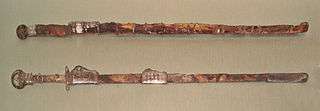
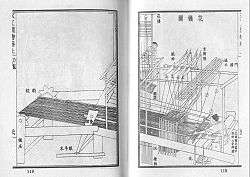
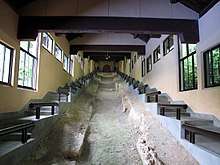
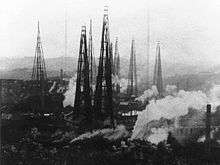
- Dao: Daos are single-edged Chinese swords, primarily used for slashing and chopping. The most common form is also known as the Chinese sabre, although those with wider blades are sometimes referred to as Chinese broadswords. In China, the dao is considered one of the four traditional weapons, along with the gun (stick or staff), qiang (spear), and the jian (sword). The earliest dao date from the Shang Dynasty in China's Bronze Age, and are known as zhibeidao (直背刀) – straight backed knives. As the name implies, these were straight-bladed or slightly curved weapons with a single edge. Originally bronze, these weapons were made of iron or steel by the time of the late Warring States period as metallurgical knowledge became sufficiently advanced to control the carbon content. Originally less common as a military weapon than the jian – the straight, double-edged blade of China – the dao became popular with cavalry during the Han dynasty due to its sturdiness, superiority as a chopping weapon, and relative ease of use – it was generally said that it takes a week to attain competence with a dao/saber, a month to attain competence with a qiang/spear, and a year to attain competence with a jian/straight sword. Soon after dao began to be issued to infantry, beginning the replacement of the jian as a standard-issue weapon.[274][275] Late Han dynasty dao had round grips and ring-shaped pommels, and ranged between 85 and 114 centimeters in length. These weapons were used alongside rectangular shields.[276]
- Dental amalgam: Dental amalgam were used in the first part of the Tang Dynasty in China (618-907 A.D.), and in Germany by Dr. Strockerus in about 1528.[277] Evidence of a dental amalgam first appears in the Tang Dynasty medical text Hsin Hsiu Pen Tsao written by Su Kung in 659, manufactured from tin and silver.[278] Historical records hint that the use of amalgams may date even earlier in the Tang Dynasty.[278] It was during the Ming Dynasty that the composition of an early dental amalgam was first published, and a text written by Liu Wen Taiin 1505 states that it consists of "100 shares of mercury, 45 shares of silver and 900 shares of tin."[278]
- Diabolo: Chinese archaeologists theorize that Chinese Diabolos (or Chinese yo-yo) originated from Chinese spinning top. In Hemudu Excavation, wooden tops were excavated. In order to extend the spinning time of the tops, whip were used to spin the top. This released a sound and gradually evolved into the term "Kongzhu" (Chinese: 空竹; pinyin: Kōng zhú; literally: "Air Bamboo" ). It was speculated that the Chinese poet Cao Zhi in the Three Kingdoms period had composed the poem "Rhapsody of Diabolos 《空竹赋》", making it the first record of Diabolo in Chinese history. The authenticity of the poem "Rhapsody of Diabolos 《空竹赋》" however required further research and evidence of proof. By the medieval Tang dynasty, Chinese Diabolo became widespread as a form of toy. The Taiwanese scholar Wu Shengda 吳盛達 however argued that records of Chinese Diabolo only appeared during late Ming dynasty Wanli period, with its details well recorded in the book Dijing Jingwulue, referring to Diabolos as "Kong Zhong" (simplified Chinese: 空钟; traditional Chinese: 空鐘; pinyin: Kōng zhong; literally: "Air Bell" ). Diabolos evolved from the Chinese yo-yo, which was originally standardized in the 12th century.[279][280] The first mention of a diabolo in the Western World was made by a missionary, Father Amiot, in Beijing in 1792 during Lord Macartney's ambassadorship, after which examples were brought to Europe,[281] as was the sheng (eventually adapted to the harmonica and accordion).[282][283]
- Dominoes: The Ming Dynasty (1368–1644) writer Xie Zhaozhe (1567–1624) initiated the legend that dominoes were first presented to the imperial court in 1112.[284] However, the oldest confirmed written mention of dominoes in China comes from the Former Events in Wulin (i.e. the capital Hangzhou) written by the Yuan Dynasty (1271–1368) author Zhou Mi (1232–1298), who listed "pupai" (gambling plaques or dominoes) as well as dice as items sold by peddlers during the reign of Emperor Xiaozong of Song (r. 1162–1189).[284] Andrew Lo asserts that Zhou Mi meant dominoes when referring to pupai, since the Ming author Lu Rong (1436–1494) explicitly defined pupai as dominoes (in regards to a story of a suitor who won a maiden's hand by drawing out four winning pupai from a set).[284] The earliest known manual written about dominoes is the Manual of the Xuanhe Period (1119–1125) written by Qu You (1347–1433).[284] In the Encyclopedia of a Myriad of Treasures, Zhang Pu (1602–1641) described the game of laying out dominoes as pupai, although the character for pu had changed (yet retained the same pronunciation).[284] Traditional Chinese domino games include Tien Gow, Pai Gow, Che Deng, and others. The thirty-two-piece Chinese domino set (made to represent each possible face of two thrown dice and thus have no blank faces) differs from the twenty-eight-piece domino set found in the Western World during the mid 18th century (in France and Italy).[285] Dominoes first appeared in Italy during the 18th century, and although it is unknown how Chinese dominoes developed into the modern game, it is speculated that Italian missionaries in China may have brought and introduced the game to Europe.[286]
- Dougong: A dougong is a building bracket which is unique to Chinese architecture. Since at least the Western Zhou Dynasty (c. 1050–771 BC), they were placed between the top of a column and a crossbeam to support the concave roofs of beam-in-tier buildings which were archetypal of Chinese architecture.[287] Each dougong is formed by double bow-shaped arms (拱, gong) supported by a wooden block (斗, dou) on each side.[287] Dougong were also used for decorative and ceremonial rather than entirely pragmatic purposes of support, such as on solid brick pagodas like the Iron Pagoda built in 1049. The Yingzao Fashi building manual published in 1103 by the Song Dynasty (960–1279) official Li Jie featured illustrations and descriptions of dougong.[288]
- Dragon boats: The use of dragon boats for racing and dragons are believed by modern scholars, sinologists, and anthropologists to have originated in southern central China more than 2500 years ago, in Dongting Lake and along the banks of the Chang Jiang (now called the Yangtze) during the same era when the Olympic games of ancient Greece were being established at Olympia).[289]
- Dragon kiln: Dragon kilns were traditional Chinese kilns used for Chinese ceramics. According to recent excavations in Shangyu District in the northeast of Zhejiang province and elsewhere, the origins of the dragon kiln may go back as far as the Shang dynasty (c. 1600 to 1046 BCE), and is linked to the introduction of stoneware, fired at 1200 °C or more. These kilns were much smaller than later examples, at some 5–12 metres long, and also sloped far less.[290] The type had certainly developed by the Warring States period,[291] and by the Eastern Wu kingdom (220–280 CE), there were over 60 kilns at Shangyu. Thereafter it remained the main design used in southern China until the Ming dynasty. The pottery areas of south China are mostly hilly, whereas those on the plains of north China typically lack suitable slopes; here the mantou kiln type predominated.[292] The Nanfeng Kiln in Guangdong province is several centuries old and still functioning. It was a producer of Shiwan ware as well as architectural ceramics, and today also functions as a tourist attraction.[293]
- Drawloom: The earliest confirmed drawloom fabrics come from the State of Chu and date c. 400 BC.[294] Most scholars attribute the invention of the drawloom to the ancient Chinese, although some speculate an independent invention from ancient Syria since drawloom fabrics found in Dura-Europas are thought to date before 256 AD.[294][295] Dieter Kuhn states that an analysis of texts and textiles from the Han Dynasty (202 BC – 220 AD) proves that the figured fabrics of that era were also crafted with the use of a drawloom.[296] The drawloom was certainly known in Persia by the 6th century AD.[294] Eric Broudy asserts there is virtually no evidence of its use in Europe until the 17th century, while the button drawloom was allegedly invented by Jean le Calabrais in the 15th century.[297] Mary Carolyn Beaudry disagrees, stating that it was used in the medieval Italian silk industry.[296]
- Drilling rig: The technique of percussion drilling for oil and gas originated during the ancient Chinese Han Dynasty in 500 BC, when percussion drilling ("churn drilling") was used to extract natural gas in Sichuan province.[298][298][299] Iron bits were fastened to long bamboo poles, which were centered within a bamboo derrick. The poles were repeatedly hoisted, using cables woven from bamboo fiber. With the assistance of levers, very heavy bits could be raised, of sufficient weight to percussively bore through rock when repeatedly dropped.[298] Han dynasty oil wells were around 10m deep; by the 10th century, depths of 100 meters could be achieved.[298] By the 16th century, Chinese oil prospectors were using percussion drilling to create wells over 2000 feet deep.[299] A modernized variant of the technique was used by American businessman Edwin Drake to drill Pennsylvania's first oil well in 1859, using small steam engines to power the drilling process.[298]
- Dry docks: The use of dry docks in China goes at least as far back the 10th century A.D.[300] In his book Dream Pool Essays, the Song dynasty polymath Shen Kuo wrote of dry docks for repairing ships.[301][302]
E
- Ephedrine: Ephedrine, known as ma huang in traditional Chinese medicine, originally as an extract of the herb Ephedra sinica, has been documented in China since the Han Dynasty (206 BC – 220 AD) as an antiasthmatic and stimulant.[303] The industrial manufacture of ephedrine in China began in the 1920s, when the American pharmaceutical company Merck began marketing and selling the drug as ephetonin. Ephedrine exports between China and the West grew from 4 tonnes to 216 tonnes between 1926 and 1928.[304]
- Escapement, hydraulic-powered (use in clockworks): Although the escapement mechanism was first invented by the Greek Philon of Byzantium for a mechanical washstand,[305] an escapement mechanism for clockworks was first developed by the Buddhist monk, court astronomer, mathematician and engineer Yi Xing (683–727) of the Tang Dynasty (618–907) for his water-powered celestial globe in the tradition of the Han dynasty polymath and inventor Zhang Heng (78–139), and could be found in later Chinese clockworks such as the clock towers developed by the military engineer Zhang Sixun (fl. late 10th century) and polymath inventor Su Song (1020–1101).[154][223][306][307][308][309] Yi Xing's escapement allowed for a bell to be rung automatically every hour, and a drum beaten automatically every quarter-hour, essentially a striking clock.[310] Unlike the modern escapement which employs a suspended oscillating pendulum resting and releasing its hooks on a small rotating gear wheel, the early Chinese escapement employed the use of gravity and hydraulics.[311] In Su Song's clock tower, scoop containers fixed to the spokes of a vertical waterwheel (which acted like a gear wheel) would be filled one by one with siphoned water from a clepsydra tank.[312] When the weight of the water in the scoop filled to an excess, it overcame a counterweight that in turn tripped a lever allowing the scoop to rotate on a pivot and drain its water.[312] However, as the scoop fell, it tripped a coupling tongue that temporarily pulled down on a long vertical chain, the latter yanking down on a balancing lever which would pull upward on a small chain connected to a locking arm, the latter lifting momentarily to release the top arrested spoke before coming back down to repeat the entire process over again.[312] It should be pointed out that the Chinese intermittently working liquid-driven escapement had "only the name in common" with the true mechanical escapement of medieval European mechanical clocks of the 14th century onwards, which worked instead with weights, producing continuous but discrete beats and that derived from the Greek and Roman verge mechanism (alarum) device of earlier mechanisms.[313]
- Exploding cannonballs: The Huolongjing military manual compiled by the Ming dynasty military official Jiao Yu (fl. 14th to early 15th century) and the Ming dynasty military strategist and philosopher Liu Bowen (1311–1375) in the mid 14th century described the earliest known exploding cannonballs, which were made of cast iron with a hollow core packed with gunpowder. Jiao and Liu wrote that when fired, they could set enemy camps ablaze. The earliest evidence for exploding cannonballs in Europe date to the 16th century.[314][315] The Huolongjing also specified the use of poison and blinding gunpowder filled into exploding shells; the effects of this chemical warfare was described as such: "Enemy soldiers will get their faces and eyes burnt, and the smoke will attack their noses, mouths, and eyes."[316]
- Explosives: At its root, the history of chemical explosives lies in the history of gunpowder.[317][318] During the Tang Dynasty in the 9th century, Taoist Chinese alchemists were eagerly trying to find the elixir of immortality.[319] In the process, they stumbled upon the explosive invention of gunpowder made from coal, saltpeter, and sulfur in 1044. Gunpowder was the first form of chemical explosives and by 1161, the Chinese were using explosives for the first time in warfare.[320][321][322] The Chinese would incorporate explosives fired from bamboo or bronze tubes known as bamboo fire crackers. The Chinese also used inserted rats from inside the bamboo fire crackers to fire toward the enemy, creating great psychological ramifications - scaring enemy soldiers away and causing cavalry units to go wild.[323]
F
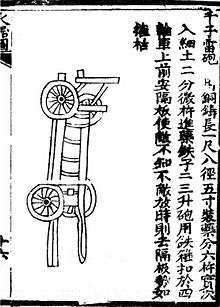
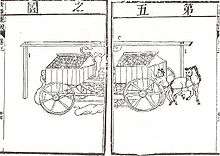
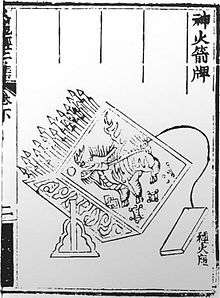
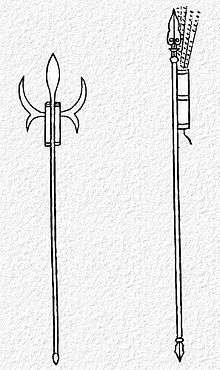
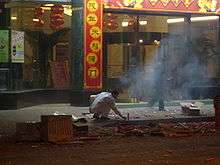
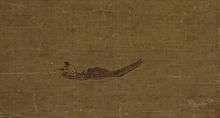
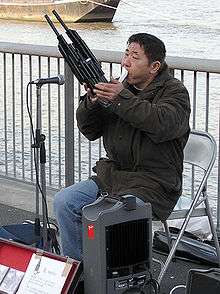
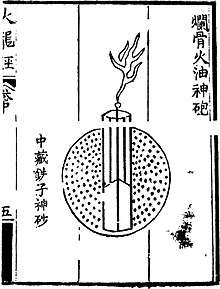
- Fermented bean curd: According to the 1596 Compendium of Materia Medica written by the Chinese polymath Li Shizhen during the Ming dynasty, the creation of soybean curd is attributed to the Han Dynasty Prince Liu An (179 – 122 BC), king of Huainan. Manufacturing of the bean curd began during the Han Dynasty in China after it was created.[324]
- Field artillery: The medieval Ming dynasty Chinese invented mobile battlefield artillery during the early part of the fourteenth century at the time when gunpowder and the primordial cannon were first being adopted in Europe.[325] One of the earliest documented uses of field artillery is found in the 14th-century Ming Dynasty treatise Huolongjing.[149] The text describes a Chinese cannon called a "thousand ball thunder cannon", manufactured of bronze and fastened with wheels.[149] The book also describes another mobile form of artillery called a "barbarian attacking cannon" consisting of a cannon attached to a two-wheel carriage.[326]
- Field mill: In the Yezhongji ('Record of Affairs at the Capital Ye of the Later Zhao Dynasty') written by Lu Hui (fl. 350 AD), various mechanical devices are described which were invented by two Later Zhao (319–351) engineers known as Xie Fei, a Palace Officer, and Wei Mengbian, the Director of the Imperial Workshops.[327] One of these is the field mill, which was essentially a cart with millstones placed onto the frame; these were mechanically rotated by the movement of the cart's terrain wheels in order to grind wheat and other cereal crops.[328] A similar vehicle these two invented was the "pounding cart", which had wooden statues mounted on the top which were actually mechanical figures who operated real tilt hammers in order to hull rice; again, the device only functioned when the cart was moved forward and the wheels turned.[328] The field mill lost its use in China sometime after the Later Zhao, but it was invented separately in Europe in 1580 by the Italian military engineer Pompeo Targone.[329] It was featured in a treatise by the Italian engineer and writer Vittorio Zonca in 1607, and then in a Chinese book of 1627 (concerning European technology) that was compiled and translated by the German Jesuit polymath Johann Schreck (1576–1630) and the Ming Dynasty (1368–1644) Chinese author Wang Zheng (王徵 1571–1644), although by then it was considered by the Chinese to be an original Western contraption.[330]
- Finery forge: In addition to accidental lumps of low-carbon wrought iron produced by excessive injected air in Chinese cupola furnaces, the ancient Chinese also created wrought iron by using the finery forge at least by the 2nd century BC, the earliest specimens of cast and pig iron fined into wrought iron and steel found at the early Han Dynasty (202 BC – 220 AD) site at Tieshengguo.[331] Pigott speculates that the finery forge existed in the previous Warring States period (403–221 BC), due to the fact that there are wrought iron items from China dating to that period and there is no documented evidence of the bloomery ever being used in China.[332] The fining process involved liquifying cast iron in a fining hearth and removing carbon from the molten cast iron through oxidation.[331] Wagner writes that in addition to the Han Dynasty hearths believed to be fining hearths, there is also pictoral evidence of the fining hearth from a Shandong tomb mural dated 1st to 2nd century AD, as well as a hint of written evidence in the 4th century AD Daoist text Taiping Jing.[333]
- Fire arrow: One of the earliest weaponized forms of gunpowder was the fire arrow which received its name from the translated Chinese term huǒjiàn (火箭), which literally means fire arrow. In China a 'fire arrow' referred to a gunpowder projectile consisting of a bag of incendiary gunpowder attached to the shaft of an arrow from the 9th century onward. Later on solid fuel rockets utilizing gunpowder were used to provide arrows with propulsive force and the term fire arrow became synonymous with rockets in the Chinese language. In other languages such as Sanskrit 'fire arrow' (agni astra) underwent a different semantic shift and became synonymous with 'cannon.'[334] Fire arrows are the predecessors of fire lances, the first firearm.[335]
- Firecracker: The predecessor of the firecracker was a type of heated bamboo, used as early as 200 BC, that exploded when heated continuously. The Chinese name for firecrackers, baozhu, literally means "exploding bamboo."[336] After the invention of gunpowder, gunpowder firecrackers had a shape that resembled bamboo and produced a similar sound, so the name "exploding bamboo" was retained.[337] In traditional Chinese culture, firecrackers were used to scare off evil spirits.[337]
- Fire lance: The fire lance was a proto-gun developed in the 10th century with a tube of first bamboo and later on metal that shot a weak gunpowder blast of flame and shrapnel; its earliest representation comes from a painting found at Dunhuang.[338][339][340] The earliest confirmed employment of the fire lance in warfare was by Song dynasty forces against the Jin in 1132 during the siege of De'an (modern Anlu, Hubei Province),[341][342][343] where they were used to great effect against wooden siege towers called "sky bridges": "As the sky bridges became stuck fast, more than ten feet from the walls and unable to get any closer, [the defenders] were ready. From below and above the defensive structures they emerged and attacked with fire lances, striking lances, and hooked sickles, each in turn. The people [i.e., the porters] at the base of the sky bridges were repulsed. Pulling their bamboo ropes, they [the porters] ended up drawing the sky bridge back in an anxious and urgent rush, going about fifty paces before stopping."[344] The surviving porters then tried once again to wheel the sky bridges into place but Song soldiers emerged from the walls in force and made a direct attack on the sky bridge soldiers while defenders on the walls threw bricks and shot arrows in conjunction with trebuchets hurling bombs and rocks. The sky bridges were also set fire to with incendiary bundles of grass and firewood. Li Heng, the Jin commander, decided to lift the siege and Jin forces were driven back with severe casualties.[344]
- Fireworks: Fireworks first appeared in China during the Song Dynasty (960–1279), in the early age of gunpowder. The common people in the Song era could purchase simple fireworks from market vendors; these were made of sticks of bamboo packed with gunpowder,[345] although grander displays were known to be held.[346] Rocket propulsion was soon applied to warfare, and by the time of the mid 14th century there were many types of rocket launchers available.[347]
- Fishing reel: In literary records, the earliest evidence of the fishing reel comes from a 4th-century AD[348][349] work entitled Lives of Famous Immortals.[350] The earliest known depiction of a fishing reel comes from a Southern Song (1127–1279) painting done in 1195 by Song dynasty painter Ma Yuan (c. 1160–1225) called "Angler on a Wintry Lake," showing a man sitting on a small sampan boat while casting out his fishing line.[351] Another fishing reel was featured in a painting by the Yuan dynasty painter Wu Zhen (1280–1354).[351] The book Tianzhu lingqian (Holy Lections from Indian Sources), printed between 1208 and 1224, features two different woodblock print illustrations of fishing reels being used.[351] An Armenian parchment Gospel of the 13th century shows a reel (though not as clearly depicted as the Chinese ones).[351] The Sancai Tuhui, a Chinese encyclopedia published in 1609, features the next known picture of a fishing reel and vividly shows the windlass pulley of the device.[351] These five pictures mentioned are the only ones which feature fishing reels before the year 1651 (when the first English illustration was made); after that year they became commonly depicted in world art.[351]
- Flamethrower, double piston and gunpowder-activated: Although the single piston flamethrower was first developed in the Byzantine Empire during the 7th century,[352] the 10th-century Chinese flamethrower, or Pen Huo Qi, boasted a continuous stream of flame by employing double piston syringes (which had been known since the Han Dynasty) spouting Greek fire which had been imported from China's maritime trade contacts in the Middle East. It was first used in battle 932 during the Five Dynasties and Ten Kingdoms period (907–960), and the earliest illustration is found in the early Song Dynasty military manuscript Wujing Zongyao of 1044, which also described the device in full.[353][354] Unlike the Greek model which employed a furnace, the Pen Huo Qi was ignited by an incendiary gunpowder fuse.[353]
- Flare: The earliest recorded use of gunpowder for signalling purposes was the 'signal bomb' used by the Song Dynasty Chinese as the Mongol-led Yuan Dynasty besieged Yangzhou in 1276.[355] These soft-shelled bombs, timed to explode in mid-air, were used to send messages to a detachment of troops far in the distance. Another mention of the signal bomb appears in a text dating from 1293 requesting their collection from those still stored in Zhejiang.[355] A signal gun appears in Korea by 1600. The Wu I Thu Phu Thung Chih or Illustrated Military Encyclopedia written in 1791 depicts a signal gun in an illustration.[356]
- Folding screen: The folding screen is a type of furniture consisting of several frames or panels. Screens date back to China during the Eastern Zhou Dynasty period (771–256 BC).[357][358] These were initially one-panel screens in contrast to folding screens.[359] Folding screens were invented during the Han Dynasty (206 BC - AD 220).[360] Depictions of those folding screens have been found in Han Dynasty era tombs, such as one in Zhucheng, Shandong Province.[357] During the Tang Dynasty, folding screens were considered ideal ornaments for many painters to display their paintings and calligraphy on.[358][359] Many artists painted on paper or silk and applied it onto the folding screen.[358] The landscape paintings on folding screens reached its height during the Song Dynasty (960–1279).[357]
- Forensic entomology: The Song Dynasty (960–1279) forensic science book Collected Cases of Injustice Rectified published by the Song Dynasty court judge, physician, medical scientist and writer Song Ci in 1247 contains the oldest known case of forensic entomology.[361] In a murder case of 1235, a villager was stabbed to death and authorities determined that his wounds were inflicted by a sickle; this was a tool used for cutting rice at harvest time, a fact which led them to suspect a fellow peasant worker was involved.[361] The local magistrate had the villagers assemble in the town square where they would temporarily relinquish their sickles.[361] Within minutes, a mass of blow flies gathered around one sickle and none other, attracted to the scent of traces of blood unseen by the naked eye.[361] It became apparent to all that the owner of that sickle was the culprit, the latter pleading for mercy as he was detained by authorities.[361]
- Fragmentation bomb: The use of fragmentation in bombs dates to the 14th century, and first appears in the Ming Dynasty text Huolongjing. The fragmentation bombs were filled with iron pellets and pieces of broken porcelain. A heated mixture of salammoniac, tung oil, chin chih, scallion juice, and yin hsiu is poured into the bomb, coating the pellets. Once the bomb explodes, the resulting shrapnel is capable of piercing the skin and blinding enemy soldiers.[362]
- Free reed aerophone: The musical pipe organ employing metal piston bellows had a long history in the Western world, dating back to the Hellenistic period. However, the Western pipe organ did not make use of the reed, which the ancient Chinese mouth organ employed. The latter instrument, called a sheng and made traditionally of bamboo pipes, was first mentioned in the Shi Jing of the Zhou Dynasty (c. 1050–256 BC). The Chinese sheng is considered the ancestor of the harmonica, harmonium, concertina, accordion, and all other reed organ instruments. A free reed organ was invented in the Arab world in the 13th century, while the German organ builder Heinrich Traxdorf (fl. 15th century) of Nuremberg built one around 1460 AD. It is thought that the classical Chinese sheng travelled west through Russia during the 19th century, as it was described then in Saint Petersburg.[363]
- Fu: Fu were Chinese tally sticks made of bamboo, wood, metal (gold, silver, bronze) or jade and used as a proof of authorization.[364] Most commonly, fu were made of wood or bamboo in sizes of wooden slips or bamboo chopsticks.[364] Although fu have been made in various shapes (such as tiger, dragon, turtle, snake, fish or human), most of them come in the shape of a tiger.[364] Classical description of tallies is found in the Chinese classic Rites of Zhou, which refers to the tallies of jade and horn, and mentions the shapes of tiger, human, dragon, seal, and banner.[365]
- Fuses: Documented evidence suggests that the earliest fuses were first used by the Chinese between the 10th and 12th centuries. After the Chinese had invented gunpowder, they began adapting its explosive properties for use in military technology. By 1044 they were using gunpowder in simple grenades, bombs, and flamethrowers, all of which required a fuse to be lit before being thrown at the enemy.[366]
G
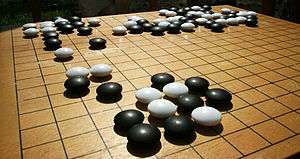
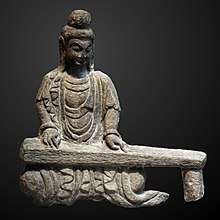
- Gas cylinder: The world's first natural gas cylinders were invented in China during the medieval Tang dynasty where the Chinese drilled deep boreholes to retrieve natural gas and used airtight jointed bamboo pipes to collect and transport it for many miles to towns and villages.[367][368][369]
- Gas lighting: The ancient Chinese during the Spring and Autumn period made the first practical use of natural gas for lighting purposes around 500 B.C. where they used bamboo pipelines to transport and carry both brine and natural gas for many miles to towns and villages.[370][371][372][373][374]
- Gimbal: The gimbal is known as the 'Cardan' suspension after Italian polymath Gerolamo Cardano (1501–1576), yet it was known long before him.[375] The British scientist, sinologist, and historian Joseph Needham writes that the earliest confirmed use of gimbals in Europe is the 9th century recipe book Little Key of Painting and English antiquary and book collector Thomas Phillipps's Mappae clavicula, which mentioned a vase surrounded by rings which allowed it to be undisturbed when in a rolling motion.[376] Needham and Belgian-born American chemist and historian of science George Sarton both write that an Arabic translation—dated to roughly the era of Al-Ma'mun (r. 813–833)—of an ancient Greek work now lost (i.e. Pneumatica) by 3rd-century BC Greek engineer, physicist, and writer Philo of Byzantium (c. 280 – c. 220 BC) contains a description of gimbals used to support an inkpot that could wet a pen on any of its sides, yet Needham suspects Arabic interpolation and doubts total authenticity, while Belgian-born American chemist and historian of science George Sarton asserts that for the most part the Arabic translation is faithful to Philo's lost original, hence Philo should be credited with the invention of the gimbal.[377][378] Around 180 AD, the Han Dynasty (202 BC – 220 AD) inventor, craftsman and mechanical engineer Ding Huan (丁緩) — who also created a rotary fan and zoetrope lamp—invented a 'Perfume Burner for use among Cushions', or 'Bedclothes Censer'.[379] This incense burner had a series of metal rings which could be moved in any direction while the burner in the middle remained constantly level.[379] This is the first clear reference in China of the gimbal, although there is a hint in the writing of the Western Han Dynasty Chinese poet, writer, and musician Sima Xiangru (179–117 BC) that this device existed in the 2nd century BC (i.e., 'the metal rings burning perfume').[380] The gimbal incense burner is mentioned in subsequent dynasties, while silverwork specimens of gimbal incense burners from the Tang Dynasty (618–907) still exist.[381] In the Liang Dynasty (502–557) there is mention of gimbals used in hinges for doors and windows, while an unnamed artisan presented a warming stove to Empress Wu Zetian (r. 690–705) in 692 which employed gimbals to keep it constantly balanced.[382]
- Go (board game) (圍棋 pinyin: wéiqí in Chinese): Although ancient Chinese legend (perhaps contrived during the Han Dynasty) has it that the mythological ruler Yao came down to earth from the Heavens around 2200 BC carrying with him a go board and stone player's pieces, it is known from existing literature that the go board game existed since at least the 10th century BC during the Zhou Dynasty (c. 1050–256 BC) and was even mentioned in writing by ancient Chinese philosophers Confucius (551–479 BC) and Mencius (371–289 BC), although the latter two had a slightly negative opinion of it.[383][384]
- Goldfish domestication: In ancient China, various species of carp (collectively known as Asian carps) were domesticated and have been reared as food fish for thousands of years. Some of these normally gray or silver species have a tendency to produce red, orange or yellow color mutations; this was first recorded in the Jin Dynasty (265–420).[385] During the Tang Dynasty (618–907), it was popular to raise carp in ornamental ponds and watergardens. A natural genetic mutation produced gold (actually yellowish orange) rather than silver coloration. People began to breed the gold variety instead of the silver variety, keeping them in ponds or other bodies of water.[386][387] Goldfish were introduced into Europe during the 17th century, and into North America in the 19th century.[388][389]
- Guqin (古琴 pinyin: gǔqín in Chinese): The guqin is one of the oldest stringed zither instruments from China and has existed since at least the Shang Dynasty (c. 1600 – c. 1050 BC), as a Shang oracle bone contains the oldest known inscription of the Chinese character for qin (琴).[390] The oldest example of a guqin comes from the tomb of Marquis Yi of Zeng (433 BC); Bo Lawergren argues they may have developed from Middle Eastern harps like konghou, which was also found in Qiemo, Xinjiang dating to 400–200 BC.[391] It was said to be popular in the Zhou Dynasty (c. 1050 – 256 BC), while the oldest known written tablature for the guqin dates to the Han Dynasty (202 BC – 220 AD).[390] The guqin became a musical instrument highly associated with China's gentry class when it was exalted as one of the Four Arts of the Chinese Scholar as well as one of the gentry's "nine guests" described by Song dynasty polymath Shen Kuo (1031–1095);[392] it was even featured in painted artwork, such as in a 12th-century piece by Emperor Huizong himself.
H
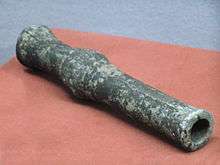
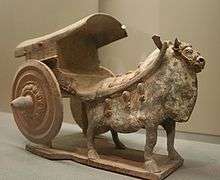
- Hand cannon: The bronze Yuan Dynasty gun from Heilongjiang which dates to about 1288 is a little over 0.3 m (1 ft) in length and weighs 3.6 kg (8 lbs). It has a small touch hole for ignition and an even bore except for the bulbous enlargement around the explosion chamber. It was excavated with a bronze pan, mirror and vase.[393]
- Hand fan: The oldest existing Chinese fans are a pair of woven bamboo side-mounted fans from the 2nd century BCE.[394] The Chinese character for "fan" (扇) is etymologically derived from a picture of feathers under a roof. The Chinese fixed fan, pien-mien, means 'to agitate the air'. A particular status and gender would be associated with a specific type of fan. During the Song Dynasty, famous artists were often commissioned to paint fans. The Chinese dancing fan was developed in the 7th century. The Chinese form of the hand fan was a row of feathers mounted in the end of a handle. In the later centuries, Chinese poems and four-word idioms were used to decorate the fans by using Chinese calligraphy pens. In ancient China, fans came in various shapes and forms (such as in a leaf, oval or a half-moon shape), and were made in different materials such as silk, bamboo, feathers, etc.[395]
- Hand grenade, explosive: Before explosive grenades, incendiary grenades were used by the Eastern Roman Empire, incorporating Greek fire.[396] Early prototypes to the modern explosive grenade, according to British scientist and sinologist Joseph Needham, appear in the military book, Wujing Zongyao ("Compilation of Military Classics"), by 1044. During the Song Dynasty, weapons known as Zhen Tian Lei were created when Chinese soldiers packed gunpowder into ceramic or metal containers and thrown at the enemy. Further descriptions and illustrations of early Chinese hand grenades are provided in the Huolongjing.[397]
- Hand gun: An early known depiction of a hand gun is a sculpture from a cave in Sichuan, dating to 1128, that portrays a figure carrying a vase-shaped bombard, firing flames and a cannonball.[398] However, the oldest existent archaeological discovery of a metal barrel handgun is the Heilongjiang hand cannon from the Chinese Heilongjiang excavation, dated to 1288.[399] Handheld firearms first appeared in China where gunpowder was first developed. They were hand cannons (although they were not necessarily fired from the hand, but rather at the end of a handle). By the 14th century, they existed in Europe as well. The first handheld firearms that might better be called "pistols" were made as early as the 15th century, but their creator is unknown.[400]
- Handscroll: The handscroll originated from ancient Chinese text documents.[401] From the Spring and Autumn period (770-481 BCE) through the Han dynasty (206 BCE - 220 CE), bamboo or wooden slips were bound and used to write texts on.[401] During the Eastern Han period (25-220), the use of paper and silk as handscrolls became more common.[401] The handscroll was the one of the main formats for texts up until the Tang dynasty (618-907).[401] Since the Three Kingdoms (220–280), the handscroll became a standard form for mounting artwork.[401] New styles were developed over time.[401]
- Hanging scroll: Hanging scrolls originated in their earliest form from literature and other texts written on bamboo strips and silk banners in ancient China.[402][403][404] The earliest hanging scrolls are related to and developed from silk banners in early Chinese history.[402][403][405] These banners were long and hung vertically on walls.[402] Such silk banners and hanging scroll paintings were found at Mawangdui dating back to the Han Dynasty (206 BCE – 220 CE).[403][405] By the time of the Tang Dynasty (618–907), the aesthetic and structural objectives for hanging scrolls were summarized, which are still followed to this day.[360] During the early Song Dynasty (960–1279), the scrolls became well suited to the art styles of the artists,[404][403] consequently hanging scrolls were made in many different sizes and proportions.[402]
- Harrow: The invention of the harrow was first written in the Chinese agricultural text Qimin Yaoshu written by the Northern Wei Dynasty official Jia Sixie. The harrow was used as a farm implement for breaking up soil chunks as well as eradicating weeds, suppressing pests, and diseases.[406]
- Heavy moldboard iron plow: Although use of the simple wooden ard in China must have preceded it, the earliest discovered Chinese iron plows date to roughly 500 BC, during the Zhou Dynasty (1122–256 BC) and were flat, V-shaped, and mounted on wooden poles and handles.[407][408] By the 3rd century BC, improved iron casting techniques led to the development of the heavy moldboard plow, seen in Han Dynasty (202 BC – 220 AD) artwork such as tomb carved bricks.[407] The moldboard allowed the Chinese to turn farm soil without clogging the plowshare with dirt, which was flung off the wheelbarrow via slanted wings on both sides.[409] While the frame of excavated plowshares dating to the Warring States period (403–221 BC) were made mostly of perishable wood except for the iron blade, the frame of excavated plowshares dating to the Han Dynasty were made entirely of solid iron with the moldboard attached to the top to turn the soil.[410]
- Helicopter rotor and bamboo-copter: The use of a helicopter rotor for vertical flight has existed since 400 BC in the form of the bamboo-copter, an ancient Chinese toy.[411] The bamboo-copter is spun by rolling a stick attached to a rotor. The spinning creates lift, and the toy flies when released.[411] The Jin dynasty philosopher and politician Ge Hong's book the Baopuzi (Master Who Embraces Simplicity), written around 317, describes the apocryphal use of a possible rotor in aircraft: "Some have made flying cars (feiche) with wood from the inner part of the jujube tree, using ox-leather (straps) fastened to returning blades so as to set the machine in motion." British scientist and sinologist Joseph Needham concludes that this is a description of a helicopter top, because "'returning (or revolving) blades' can hardly mean anything else, especially in close association with a belt or strap."[412] The Italian polymath Leonardo da Vinci designed a machine known as an "aerial screw" with a rotor based on a water screw. The Russian polymath Mikhail Lomonosov developed a rotor based on the Chinese toy. The French naturalist Christian de Launoy constructed his rotor out of turkey feathers.[411] The English aerospace engineer and inventor Sir George Cayley, inspired by the Chinese top in his childhood, created multiple vertical flight machines with rotors made of tin sheets.[411] French engineer and inventor Alphonse Pénaud would later develop coaxial rotor model helicopter toys in 1870, powered by rubber bands. One of these toys, given as a gift by their father, would inspire the American inventors the Wright brothers to pursue the dream of modern flight.[413]
- Hell money: Hell money is a form of joss paper printed to resemble fake legal tender bank notes. The notes are not an official form of recognized currency or legal tender since their sole intended purpose is to be offered as burnt offerings to the deceased as a superstitious solution to resolve their ancestors financial problems. This custom has been practiced by the modern Chinese and across East Asia since the late 19th century.[414][415]
- Hill censer: The hill censer, a vessel used for burning incense, dates to the Han Dynasty (206 BC – 220 AD). The censers are shaped like mountains and were used for religious rituals. The shape of the hill censer acts as a visual aid for envisioning the sacred mountains that were said to have been inhabited by Taoist immortals.[416] Hill censers were originally designed for Taoist rituals, but were later used by Chinese Buddhists.[417] Hill censers often include carvings of wilds animals and birds. Some censers depict waves at the foundation of the vessel, said to be the waves of the East China Sea.[418] A hole at the top of the censer releases the smoke of the incense.[418]
- Horse collar: A significant improvement of the ancient breast harness was the horse collar. The horse collar was depicted in a Northern Wei (386–534) mural at Dunhuang, China, dated 477–499; the latter artwork does not feature the essential collar cushion behind the cross bar, though, while a later Tang Dynasty (618–907) mural of about 851 accurately displays the cushioned collar behind the cross bar.[419][420] An earlier painting of the Sui Dynasty (581–618) accurately depicted the horse collar as it is seen today, yet the illustration shows its use on a camel instead of a horse.[421]
- Horse harness, ("trace" or "breast"): Throughout the ancient world, the 'throat-and-girth' harness was used for harnessing horses that pulled carts; this greatly limited a horse's ability to exert itself as it was constantly choked at the neck.[422] A painting on a lacquerware box from the State of Chu, dated to the 4th century BC, shows the first known use of a yoke placed across a horses's chest, with traces connecting to the chariot shaft.[423] The hard yoke across the horse's chest was gradually replaced by a breast strap, which was often depicted in carved reliefs and stamped bricks of tombs from the Han Dynasty (202 BC – 220 AD).[424] Eventually, the horse collar was invented in China, at least by the 5th century.[419][425]
- Hot pot: The Chinese hot pot has a history of more than 1,000 years.[426] Hot pot originated during the Chinese Jin Dynasty where the main ingredient was meat, usually beef, mutton or horse. It then spread to Southern China during the medieval Song Dynasty and was further established during the Mongolian Yuan Dynasty.[426]
- Hukou system: The Hukou system is a governmental household and family registration system that has its origins in ancient China. Roots of the system date back as early as the pre-dynastic era to the 21st century BC.[427][428] The modern Chinese Hukou system grew out of ancient Chinese family registries that was used to impose conscription, social control and taxation. The modern Chinese Hukou system operates as a domestic passport, population regulation system, and rural-to-urban migration.[429] Chinese citizens living an urban hukou permits them to enjoy privileged access to public sector services such as education, food rations, health care, security, welfare, and pensions. In contrast, Chinese citizens living in a rural hukou are deprived of such public services and unable to move freely across the more affluent urban areas.[430] The ancient Hukou system also influenced neighboring East Asian countries such as those which adopted a similar household registration system that exists within the public administration structures of Japan (koseki) and Korea (hoju) as well as Vietnam (hộ khẩu).[431][432][433][434][435]
- Hygrometer: Prototype hygrometers were devised and developed in the hills during the Western Han dynasty in Ancient China to elucidate mechanisms of long-range meteorological fluctuations.[436] The Chinese used a bar of charcoal and a lump of earth: its dry weight was taken and then compared with its damp weight after being exposed in the air. The differences in weight was used to tally the humidity level. Other techniques were applied using mass to measure humidity such as when the air was dry, the bar of charcoal would be light while the air was humid, the bar of charcoal would be heavy. By hanging a lump of earth and a bar of charcoal on the two ends of a staff separately and adding a fixated lifting string on the middle point to make the staff horizontal in dry air, an ancient hygrometer was made.[437][436]
I
- Incense: According to biological anthropologist and ecologist David Michael Stoddart of the University of Tasmania, "the earliest recorded use of incense comes from the Chinese who burned various herbs and plant products."[438] Sandalwood, casia, styrax, and cinnamon were used by the Chinese.[438]
- Incense clocks: Incense clocks were Chinese timekeeping devices that appeared during the Song Dynasty (960-1279) and spread to neighboring East Asian countries such as Japan and Korea. In addition to water, mechanical, and candle clocks, incense clocks were used in Asia, and were fashioned in several different forms.[439] Incense clocks were first used in China around the 6th century spread to Japan as one survives in the Shōsōin.[440] Although popularly associated with China the incense clock is believed by some to have originated in India, at least in its fundamental form, if not function.[441][442]
- India ink: Although named after carbonaceous pigment materials originating from India, Indian ink first appeared in China; some scholars say it was made as far back as the 3rd millennium BC, while others state it was perhaps not invented until the Wei Dynasty (220–265 AD).[443][444][445][446]
- Inkstone: The inkstone is a stone mortar used in Chinese calligraphy for grinding and mixing ink. Other than stone, inkstones are also manufactured from clay, bronze, iron, and porcelain. The device evolved from a rubbing tool used for rubbing dyes dating around 6000 to 7000 years ago.[447] The earliest excavated inkstone is dated from the 3rd century BC, and was discovered in a tomb located in modern Yunmeng, Hubei. Usage of the inkstone was popularized during the Han Dynasty.[448]
- Inoculation, treatment of smallpox: As Europeans would not begin to develop vaccinations for smallpox until 1796, historical Chinese records show that Chinese physicians have been inoculating against the same disease hundreds of years earlier.[449] The British scientist, sinologist, and historian Joseph Needham states that a case of inoculation for smallpox may have existed in the late 10th century during the Song Dynasty (960–1279), yet they rely on a book Zhongdou xinfa (種痘心法) written in 1808 by Zhu Yiliang for this evidence.[450] Wan Quan (1499–1582) wrote the first clear reference to smallpox inoculation in his Douzhen xinfa (痘疹心法) of 1549.[451] The process of inoculation was also vividly described by Yu Chang in his Yuyi cao (寓意草), or Notes on My Judgment published in 1643, and Zhang Yan in his Zhongdou xinshu (種痘新書), or New book on smallpox inoculation in 1741. As written by Yu Tianchi in his Shadou jijie (痧痘集解) of 1727, which was based on Wang Zhangren's Douzhen jinjing lu (痘疹金鏡錄) of 1579, the technique of inoculation to avoid smallpox was not widespread in China until the reign of the Longqing Emperor (r. 1567 – 1572) during the Ming Dynasty (1368–1644).[451]
- Irrigation systems: In the modern Sichuan region belonging to the State of Qin of ancient China, the Dujiangyan Irrigation System devised by the Qin Chinese hydrologist and irrigation engineer Li Bing was built in 256 BCE to irrigate a vast area of farmland that today still supplies water.[452] By the 2nd century AD, during the Han Dynasty, the Chinese also used chain pumps that lifted water from a lower elevation to higher one.[453] These were powered by manual foot pedal, hydraulic waterwheels, or rotating mechanical wheels pulled by oxen.[454] The water was used for public works of providing water for urban residential quarters and palace gardens, but mostly for irrigation of farmland canals and channels in the fields.[455]
J
- Jacob's staff: The Song Dynasty (960–1279) polymath Shen Kuo (1031–1095), an antiquarian who pursued studies of archaeological finds, unearthed an ancient crossbow-like mechanism from a garden in Jiangsu which had on its stock a graduated sighting scale in minute measurements.[456] He wrote that while viewing the whole of a mountain, the distance on the instrument was long, but while viewing a small part of the mountainside the distance was short due to the device's cross piece that had to be pushed further away from the observer's eye, with the graduation starting on the further end.[456] He wrote that if one placed an arrow on the device and looked past its end, the degree of the mountain could be measured and thus its height could be calculated.[456] Shen wrote that this was similar to mathematicians who used right-angled triangles to measure height.[456] British scientist, sinologist, and historian Joseph Needham writes that what Shen had discovered was Jacob's staff, a surveying tool which was not known in Europe until the medieval French Jewish mathematician Levi ben Gerson (1288–1344) described it in 1321.[457]
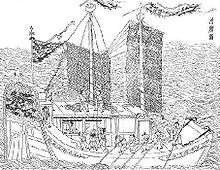
- Jade burial suit: Burial suits made of jade existed in China during the Han Dynasty (202 BC – 220 AD). Confirming ancient records about Han royalty and nobility buried in jade burial suits, archaeologists discovered in June 1968 the tombs and jade burial suits of Prince Liu Sheng (d. 113 BC) and his wife Dou Wan in Hebei province.[458] Liu's suit, in twelve flexible sections, comprised 2,690 square pieces of green jade with holes punctured in the four corners of each piece so that they could be sewn together with gold thread.[459] The total weight of the gold thread used in his suit was 1,110 g (39 oz).[460] Princess Dou Wan's suit had 2,156 pieces of jade stitched together with 703 g (24.7 oz) of gold thread.[460] Although jade burial outer wears and head masks appear in tombs of the early Han Dynasty, burial suits did not appear until the reign of Emperor Wen of Han (r. 180–157 BC), with the earliest being found in the Shizishan site. A total of 22 Western Han (202 BC – 9 AD) and 27 Eastern Han (25–220 AD) complete and partial jade burial suits were uncovered between 1954 and 1996. They are found mainly in Hebei, Shandong, Jiangsu and Henan, as well as at Yangjiawan, Dongyuan, Guangzhou, Mawangdui, Mianyang and Shizhaishan. The jade burial suit gradually disappeared when it was forbidden in 222 by Emperor Wen of Wei.[461]
- Junk (ship): The Chinese junk, derived from the Portuguese term junco (which in turn was adapted from the Javanese djong meaning "ship"),[462] was a ship design unique to China, although many other ship types in China (such as the towered lou chuan) preceded it.[463][464] Its origins could be seen in the latter half of the Han Dynasty (202 BC – 220 AD), when ship designs began to have square-ended bows and sterns with flat bottom hulls.[465] Unlike the earliest shipbuilding traditions of the Europe and South Asia, the junk had a (flat or slightly rounded) carvel-shaped hull which lacked a keel and sternpost (necessitating block and tackle or socket-and-jaw attachment of the Chinese rudder).[466] Since there is no keel in the design, solid transverse bulkheads take the place of structural ribs.[467] There are many theories about the evolution of the junk. One suggests that it developed from the double canoe, another claims that the bamboo raft used by Taiwanese aboriginals was the source of the junk.[468] Records by Western travelers in China during the Song Dynasty mention that junks could support 130 sailors. The size of junks grew during the Ming Dynasty. By the 14th century, junks could carry 2,000 tons. Archaeological evidence of the large size of the junk has been proven by a sunken junk discovered in 1973 near the coast of Southeastern China.[469]
K
- Kang bed-stove: Kang bed stoves were traditional long (2 metres or more) heated bed floors for general living, working, entertaining and sleeping used in northern part of China, where there is cold climate in winter. It is made of bricks or other forms of fired clay and more recently of concrete in some locations. The kang is said to be derived from the concept of a heated bed floor called a huoqiang found in China in the Neolithic period, according to analysis of archeological excavations of building remains in Banpo Xi'an. However, archeological sites in Shenyang, Liaoning, show humans using the heated bed floor as early as 7,200 years ago.[470][471] Literary evidence from the Shui Jing Zhu also gives evidence of heated floors by the Northern Wei Dynasty, though it was not explicitly named a dikang:[472]
- Keel: The adjustable centerboard keel traces its roots to the medieval Chinese Song dynasty. Many Song Chinese junk ships had a ballasted and bilge keel that consisted of wooden beams bound together with iron hoops. Maritime technology and the technological know-how allowed Song dynasty ships to be used in naval warfare between the Southern Song Dynasty, the Jin Dynasty, and the Mongols.[473][474][475]
- Kite: As written in the Mozi, the Zhou Dynasty philosopher, carpenter, and structural engineer Lu Ban (fl. 5th century BC) from the State of Lu created a wooden bird that remained flying in the air for three days, essentially a kite; there is written evidence that kites were used as rescue signals when the city of Nanjing was besieged by Hou Jing (died 552) during the reign of Emperor Wu of Liang (r. 502–549), while similar accounts of kites used for military signalling are found in the Tang (618–907) and Jin (1115–1234) dynasties; kite flying as a pastime can be seen in painted murals of Dunhuang dating to the Northern Wei (386–534) period, while descriptions of flying kites as a pastime have been found in Song (960–1279) and Ming (1368–1644) texts.[476][477]
L
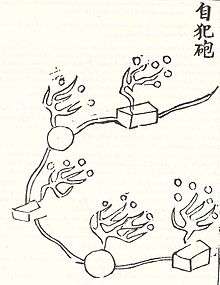
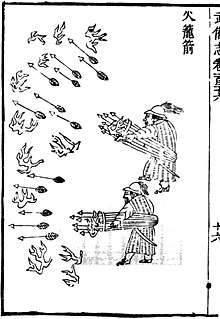

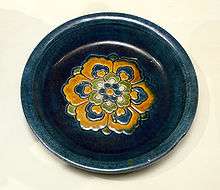


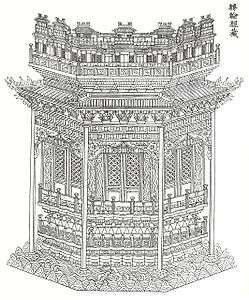
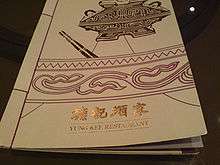
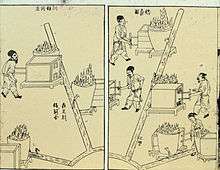
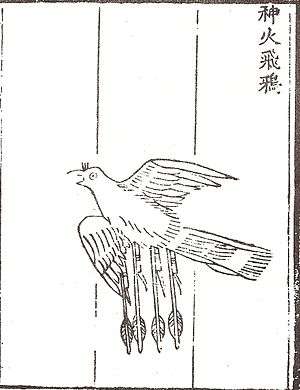

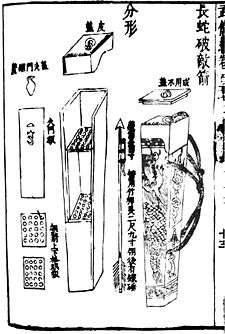
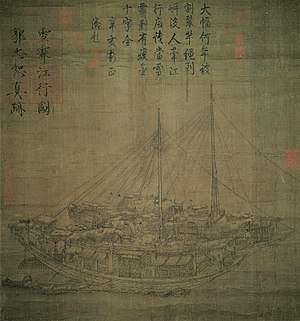
- Lamian: The unique method of making lamian noodles originated in China.[479] The Songshi Yangsheng Bu (simplified Chinese: 宋氏养生部; traditional Chinese: 宋氏養生部), which was written by Song Xu and dates back to 1504, has the earliest description of the method to make lamian.[479]
- Land mine: Textual evidence suggests that the first use of a land mine in history was by a Song Dynasty brigadier general known as Lou Qianxia, who used an 'enormous bomb' (huo pao) to kill Mongol soldiers invading Guangxi in 1277.[480] However, the first detailed description of the land mine was given in the Huolongjing text written by Ming Dynasty writer, military strategist and philosopher Jiao Yu (fl. 14th to early 15th century) and Liu Bowen (1311–1375) during the late Yuan Dynasty (1271–1368) and early Ming Dynasty (1368–1644).[481] Jiao and Liu wrote that land mines were spherical, made of cast iron, and their fuses ignited by a mechanism tripped by enemy movement; although Jiao and Liu did not describe this trip mechanism in full detail, a later text of 1606 revealed that enemy movement released a pin that allowed hidden underground weights to fall and spin a chord around an axle that rotated a spinning wheel acting as a flint to spark a train of fuses.[482]
- Land sailing: The usage of the land sail in China dates back to at least the Northern and Southern dynasties period.[483] The earliest text describing the Chinese use of mounting masts and sails on large vehicles is the Book of the Golden Hall Master written by the Daoist scholar and crown prince Xiao Yi, who later became Emperor Yuan of Liang (r. 552–554 AD).[483]
- Leeboard: To avoid leeward drift caused by the force of wind while sailing, the leeboard was invented; it was a board lowered onto the side of the ship opposite to the direction of the wind, helping the ship to stay upright and afloat even if the hull was breached. British writers Paul Johnstone and Sean McGrail state that an odd-looking second paddle on a bronze drum of the Dong Son culture (centered in the Red River Delta of northern Vietnam) may depict a leeboard in use as early as 300 BC.[484] Leeboards may have been invented in China as early as the 8th century during the Tang Dynasty and are featured shortly after in 9th century engraved artwork found at the Borobudur monument built during the Sailendra dynasty of Central Java (Indonesia).[484] Leeboards were first used in the West by the Dutch, during the 15th to 16th centuries (possibly used on early Dutch cogs, or perhaps influenced by a Chinese origin).[485][486]
- Liubo: The now defunct board game liubo for the most part remains an enigma for modern scholars still deciphering exactly how it was played; its association with both gambling and divination make it a unique game.[487][488] The earliest two liubo game boards are found in the Zhongshan Tomb 3 at Shijiazhuang, Hebei.[489][490] Similar finds, dating from the mid 4th century BC, are also found in the Chu Tomb 197 and 314 at Jiangling, Hubei.[489][491] Liubo game boards have been found in several Western Han (202 BC – 9 AD) tombs; 1 wooden board at Jiangdu in Jiangsu; 1 wooden board in Tomb 8 at Fenghuangshan in Hubei; 1 lacquered set of liubo in Tomb 3 at Mawangdui Han tombs site in Hunan; 1 lacquered board in Tomb 1 at Dafentou in Yunnan; 1 bronze board at Xilin in Guangxi.[492] During the Han Dynasty, an argument over the divination portents of the game as a result of a playing session led to a fight between a Western Han crown prince and Liu Xian (劉賢), where the latter was killed in the scuffle which (in part) prompted his father Liu Pi (劉濞), the King of Wu, to rebel against central Han authority in the Rebellion of the Seven States (154 BC).[487] The British sinologist and historian Michael Loewe asserts that the set pieces of liubo were symbolic of the forces of the Chinese Five Elements, wu xing.[488]
- Louche: The louche (耬車) was a mobile animal-drawn agricultural seed drill invented by the Chinese agronomist Zhao Guo, a Han official in charge of agricultural production during the reign of Han Wudi in the Han dynasty. According to the records of Political Commentator by the Eastern Han dynasty writer Cui Shi, the Louche consisted of three feet and thus was called three-legged Lou. The three legs had three ditch diggers under it used for sowing. The Louche was animal powered and was pulled by an ox and the leg of the Louche directly dug a ditch in the flattened soil, sowed the seeds, covered the seeds, and pressed the land flat at the same time. The machine was known for its utility and efficiency for serving several agricultural uses at the same time, while saving time and effort.[406]
M
- Magic mirrors: In about 800 AD, during the Tang Dynasty (618–907), a book entitled Record of Ancient Mirrors described the method of crafting solid bronze mirrors with decorations, written characters, or patterns on the reverse side that could cast these in a reflection on a nearby surface as light struck the front, polished side of the mirror; due to this seemingly transparent effect, they were called 'light-penetration mirrors' by the Chinese. Unfortunately, this Tang era book was lost over the centuries, but magic mirrors were described in the Dream Pool Essays by the Song dynasty polymath Shen Kuo (1031–1095), who owned three of them as a family heirloom. Perplexed as to how solid metal could be transparent, Shen guessed that some sort of quenching technique was used to produce tiny wrinkles on the face of the mirror too small to be observed by the eye. Although his explanation of different cooling rates was incorrect, he was right to suggest the surface contained minute variations which the naked eye could not detect; these mirrors also had no transparent quality at all, as discovered by British scientist and mathematician William Bragg in 1932.[493]
- Mahjong: The Dutch journalist and writer Jelte Rep writes that the gambling game of mahjong (Traditional Chinese: 麻將; Pinyin: májiàng), which employs a set of over a hundred tiles, was first invented in 1846 by Zhen Yumen, a Qing Dynasty (1644–1912) diplomatic official from Ningbo.[494] However, Rep traces the origins of the game to a card game of the Tang Dynasty (618–907) which used thirty-two wood or ivory pieces in the shape of cards.[495] This evolved into the forty-card game of madiao (馬吊) during the Ming Dynasty (1368–1644), which had four suits of cards instead of the three found in modern mahjong.[495]
- Mandarin square: Mandarin squares were large embroidered badges sewn onto the surcoat of an officials in Imperial China, Korea and Vietnam. It was embroidered with detailed, colourful animal or bird insignia indicating the rank of the official wearing it. Mandarin squares were first authorized for wear in 1391 by the Ming Dynasty. The use of squares depicting birds for civil officials and animals for military officials was an outgrowth of the use of similar squares, apparently for decorative use, in the Yuan Dynasty.[496] The original court dress regulations of the Ming Dynasty were published in 1368, but did not refer to badges as rank insignia.[497]
- Mantou kiln: The mantou kiln was the most common type of pottery kiln in north China, in historical periods when the dragon kiln dominated south China; both seem to have emerged in the Warring States period of approximately 475 to 221 BC.[498] It is named (in both English and Chinese) after the Chinese mantou bun or roll, whose shape it (very approximately) resembles; the ground plan resembles a horseshoe.[499] The kilns are roughly round, with a low dome covering the central firing area, and are generally only 2 to 3 metres across inside. However it is capable of reaching very high temperatures, up to about 1370 °C. There is a door or bricked-up opening at the front for loading and unloading, and one or two short chimneys at the rear.[499]
- Match, non-friction: The earliest type of match for lighting fire was made in China by 577 AD, invented by Northern Qi (550–577) court ladies as they desperately looked for materials to light fires for cooking and heating as enemy troops of Northern Zhou (557–581) and the Chen Dynasty (557–589) besieged their city from outside. Early matches in China were designed to be lit by an existing flame and carried to light another fire. They were pinewood sticks impregnated with sulfur and needed only a slight touch from a flame to light. This was written in the Records of the Unworldly and Strange by Tao Gu in 950 (Five Dynasties and Ten Kingdoms period).[500]
- Meat analogue: The use of tofu as a meat analogue is recorded in a document written by Tao Gu (903–970). Tao describes how tofu was popularly known as "small mutton" (xiao zaiyang), which shows that the Chinese valued tofu as an imitation meat. Tofu was widely consumed during the Tang dynasty (618–907), and likely spread to Japan during the later Tang or early Song dynasty.[501] Prior to the arrival of Buddhism, China was predominantly a meat consuming culture. The vegetarian dietary laws of Buddhism led to development of meat analogues as a replacement for the meat-based dishes that the Chinese were no longer able to consume as Buddhists. Meat analogues such as tofu and wheat gluten are still associated with Buddhist cuisine in China and other parts of East Asia.[502]
- Mechanical theater (driven by carriage wheels): The inventors of the field mill mentioned above, Xie Fei and Wei Mengbian of the Later Zhao (319–351 AD), also invented an intricate mechanical theater mounted on a carriage, its figures operated by motive power (i.e. simply advancing the carriage forward).[503] From 335 to 345 AD, they worked at the court of the ethnic-Jie emperor Shi Hu (334–349).[503] The vehicle they crafted was a four-wheeled and 6 m (20 ft) long carriage that was about 3 m (10 ft) wide.[503] On it rested a large golden Buddha statue with a Daoist statue continually rubbing his front with his mechanical hand.[503] The Buddha was also surrounded by ten wooden Daoists who rotated around him in a circuit, periodically bowing to him, saluting him, and throwing incense into a censer.[503] Above the Buddha were nine dragon-headed faucets which spouted water.[503] Like the field mill and the pounding cart of these two inventors, when the carriage halted, so did all of its moving components of mechanical statues and spouting faucets.[504]
- Mechanical cup-bearers and wine-pourers on automatic-traveling boats: The mechanical engineer Huang Gun served the court of Emperor Yang Di (r. 604–617) and wrote the book Shuishi Tujing on his inventions, which his colleague Du Bao enlarged and commented on.[505] He constructed seven small boats, called 'wine boats', that were as large as 3 m (10 ft) long and 1.8 m (6 ft) wide which supported a number of mechanical figures of wooden statues called 'hydraulic elegances', each about 0.6 m (2 ft) tall, some of them animals but most in human form consisting of singing girls, musicians playing actual instruments, dancers and tumblers, oarsmen busy rowing, cup-bearers, and wine-pourers all moving simultaneously as if alive.[505] These boats were set to travel at timed intervals along circuits made of winding stone channels and canals in palace courtyards and gardens (designed by Tang Haogui), where guests would gather for special occasions.[505] The cup-bearer stood at the bow of each ship and beside him the wine-pourer; when the ship made automatically timed periodic stops where guests were seated, the cup-bearer automatically stretched out his arm with a full cup of wine.[505] When the guest was done emptying his cup, he placed the cup back into the figure's hands; the latter then waited as the wine-pourer filled a second cup to be emptied.[505] When this guest had been served, the wine boat automatically moved onwards to the next stop.[505] The British sinologist, scientist, and historian Joseph Needham speculates that the 'wine boats' may have been paddle-wheel-driven.[506] Another paddle wheel ship was commanded by Wang Zhen'e and described in his biographies dated from the Liu Song Dynasty (420–479).[507] side from the partial remains of the Shuishi Tujing, an account of these 'wine boats' was also preserved by Huang Gun's contemporary Yan Shigu (581–645).[508]
- Merit system: The earliest example of a merit system dates back to the Qin and Han dynasties. In order to maintain power over a large, sprawling empire, it became necessary for the government to maintain a complex network of officials.[509] Prospective officials could come from a rural background and government positions were not restricted to the nobility. Rank was determined by merit, through the civil service examinations, and education became the key for social mobility.[509] After the fall of the Han Dynasty, the nine-rank system was established during the Three Kingdoms period. The concept of a merit system spread from China to British India during the 17th century, and then into continental Europe and the United States.[510]
- Modular system of architecture, eight standard grades: Although other texts preceded it, such as the 'National Building Law' of the Tang Dynasty (618–907) which was partially preserved in other texts, the Yingzao Fashi published in 1103 by the Song Dynasty (960–1279) scholar-official Li Jie (1065–1110) is the oldest known Chinese architectural treatise that has survived fully intact.[511] It contains descriptions and illustrations detailing the cai fen system (材份制) of eight standard dimensions for module components of timber architecture and structural carpentry.[512] The eight standard grades of module timber components in the Yingzao Fashi, with grade I being the largest and grade VIII the smallest, were used to determine the ultimate proportions and scale of a building as a whole, as all timber hall types—palaces, mansions, ordinary houses, and pavilions—were hierarchically categorized along the lines of which cai fen grade was employed.[513] For example, palace type buildings used only grades I through V, while mansion type buildings never used components larger than grade III and no less than grade VI.[514] In this system of structural carpentry, the smallest grade of VIII is represented by one cai; one cai is equal to the modern equivalent of 15 cm (5.9 in), while one cai is also divided into fifteen fen (hence the title of this modular system).[515]
- Moveable sails: By the time of the Zhou Dynasty ship technologies such as stern mounted rudders were developed, and by the Han Dynasty, a well kept naval fleet was an integral part of the military. The Chinese used the complex moving technology behind the kite allowed then to develop the worlds first moving sails (in comparison with the mounted sails used in the West) around 200 AD. These moving sails allowed ships to sail into the wind for the first time in human history. Civilizations around the world soon emulated the Chinese technology and eventually moving sails became the standard on ships.[516][517][518][369]
- Multiple rocket launcher: The first multiple rocket launchers were made during the medieval Chinese Song dynasty. It was designed to launch multiple rocket arrows from a gunpowder box. These also appeared later, in an expanded version, in the Joseon Dynasty of Korea, where they were used with great effectiveness against the Japanese invasions of 1592–98, most notably the Battle of Haengju.[519] Multiple rocket launchers evolved from Chinese fire lances when the Song military favored multiple rocket launchers that fired simultaneously up to 100 small fire-arrow rockets after the Mongol siege of Kaifeng. The typical powder section of such an arrow-rocket was 1/3 and 1/2 ft (10 to 15 cm) long. Bamboo arrow shafts varied from 1.5 ft (45 cm) to 2.5 ft (75 cm) long and the striking distance reached 300 to 400 paces. The Chinese also enhanced rocket tips with poison and made sure that the launchers were also mobile. Song Chinese rocket designers designed multiple rocket launchers that could be carried and operated by a single soldier.[520]
- Multistage rocket: Although there is still some ambiguity as to whether the earliest rockets of the 13th century were first developed in Europe (i.e. 'ignis volantis in aere' in the work of Marcus Graecus around 1232, although Needham and Davis assert it was most likely a fire lance), the Middle East (i.e. 'sahm al-Khitāi' or 'arrows of China' as referred to by Hasan al-Rhammāh in 1280) or China (i.e. 'di lao shu' or 'ground rat' mentioned in 1264 or the 'chong' mortar used by the armies of the Song Dynasty and invading Mongols during the 1270s), during the Yuan Dynasty (1271–1368) the term 'fire arrow' once implied to mean incendiary arrows during the Tang Dynasty was then used to describe the true rocket, producing a headache, as Needham says, for historians;[30][521][522] the Huolongjing written by military officer Jiao Yu (fl. 14th to early 15th century) and the Song dynasty Chinese philosopher and politician Liu Bowen (1311–1375) during the early Ming Dynasty (1368–1644) described several types of rockets,[523] one of them being a multistage rocket known as the 'huo long chu shui' or 'fire dragon issuing from the water' which, despite its name, was not launched from beneath the water from a primitive submarine but rather at near water-level maintaining a flat trajectory; defined as a two-stage rocket, it employed booster rockets that, when about to burn out of use, ignited a swarm of smaller rocket arrows fired from the front end of the missile shaped as a dragon's mouth.[524]
- Multiple-tube seed drill: The wooden seed drill existed in China by the 3rd century BC, while the multiple-tube iron seed drill was first invented in China by the 2nd century BC, during the Han Dynasty (202 BC – 220 AD).[525][526] The seed drill allowed for greater speed and regulation of distributing seeds in lined rows of crops instead of casting them out onto the farm field.[525]
N
- Natural gas as a fuel: On tomb brick reliefs of Sichuan province dating to the Han Dynasty (202 BC - 220 AD), scenes of borehole drilling for mining projects are shown.[527] They show towering derricks lifting liquid brine through bamboo pipes to the surface so that the brine could be distilled in evaporation pans over the heat of furnaces and produce salt.[527] The furnaces were heated by natural gas brought by airtight jointed bamboo pipes for miles to towns and villages, yet gas brought up from 610 m (2,000 ft) below the surface could cause an explosion if it was not properly mixed with oxygen first, so the Han dynasty Chinese built underground carburetor chambers and siphoned some of the gas off with exhaust pipes.[527]
- Naval mine: The Huolongjing military manuscript written by Ming dynasty military writer, strategist, and philosopher Jiao Yu (fl. 14th to early 15th century) and Chinese military strategist, philosopher, statesman and poet Liu Bowen (1311–1375) also describes naval mines used at sea or on rivers and lakes; made of wrought iron and enclosed in an ox bladder, it was a timed device in that a burning joss sticks floating above the mine determined when the fuse was to be ignited; the text explicitly mentions that without air and doused in water the fuse would not burn, so the fuse was protected by a long waterproof tube made out of goat's intestine; a later model shown in Ming Chinese scientist and encyclopedist Song Yingxing's (1587–1666) encyclopedia of 1637 shows the ox bladder replaced with a lacquered leather bag while the mine is ignited by a rip cord pulled from the shore to rotate a flint-and-steel firing mechanism.[528]
- Nickel silver: Nickel silver was first known and used in China during the modern Manchu-led Qing dynasty.[529] During the Qing Dynasty, it was "smuggled into various parts of the East Indies", despite a government ban on the export of nickel silver.[530]
- Night market: The concept of the night market traces its roots back to the medieval Chinese Tang dynasty. The Tang government put strict sanctions on night markets and their operations in A.D. 836. Towards the end of the Tang Dynasty, economic expansion led to less state regulation and restrictions being lifted on night markets. During the Song Dynasty (960-1279), Night markets played a central role in medieval Chinese nightlife. These markets were found in corners of large cities. Some stayed open for twenty- four hours. Song period night markets are also known to have included restaurants and brothels due to being frequently located near business and red light districts.[531]
O
- Open-spandrel segmental arch bridge: The earliest known fully stone open-spandrel segmental arch bridge is the Zhaozhou Bridge in southern Hebei province, China, completed in 605 by the Sui Dynasty (581–618) engineer Li Chun.[532][533] The bridge span is 37.5 m (123 ft) and the structure relatively light in weight due to the four semi-circular arch spandrels which allow for additional flood waters to pass through. Other Chinese bridges would be influenced by this design, such as the open-spandrel Yongtong Bridge of Zhaoxian, Hebei built in 1130, and the simple segmental arch Lugou Bridge built in 1698 (originally in 1189).[534] The latter, located just west of Beijing and features eleven segmental arches.
- Oil refining: The Chinese were among the first civilizations to refine oil.[535] During 512 A.D. and 518 A.D., in the late Northern Wei Dynasty, the Chinese geographer, politician, and writer Li Daoyuan introduced the process of refining oil intro various lubricants in his famous work Commentary on the Water Classic.[536][537][535] During the first century AD, the Chinese were among the first peoples to refine oil for use as an energy source.[537][535] During the Northern Song Dynasty, a workshop called the "Fierce Oil Workshop", was established in the city of Kaifeng to produce refined oil for the Song military as a weapon. The troops would then fill the iron cans with refined oil and threw them toward the enemy troops, causing a fire - effectively the world's first "fire bomb" The workshop was one of the world's earliest oil refining factories where thousands of people worked to produce Chinese oil powered weaponry.[538]
- Oil well: The earliest record of an oil well dates from 347 AD in China.[539] Petroleum was used in ancient China for "lighting, as a lubricant for cart axles and the bearings of water-powered drop hammers, as a source of carbon for inksticks, and as a medical remedy for sores on humans and mange in animals."[540] The earliest illustrated depiction of an oil well dates to 1762 AD.[540]
P
- Paper cup and paper napkin: Paper cups have been documented in imperial China, alongside paper napkins. Paper cups were known as chih pei and were used for the serving of tea.[541] They were constructed in different sizes and colors, and were adorned with decorative designs. Paper napkins, or chih pha, accompanied tea cups and were folded into squares. Textual evidence of paper cups and napkins appears in a description of the possessions of the Yu family, from the city of Hangzhou.[541]
- Paper lantern: The paper lantern is a lighting device made of paper. Early lanterns in China were constructed with silk, paper, or animal skin with frames made of bamboo or wood.[542] One of the earliest descriptions of paper lanterns is found in records from Khotan, which describe a "mounting lantern" made of white paper.[542]
- Parachute: The earliest primitive form of the parachute was made some 4,000 years ago when the Chinese noticed that air resistance would slow a person's fall from a height. The Western Han Dynasty writer Sima Qian in his book Historical Records records the story of Shun, a legendary Chinese emperor who ran away from his murderous father by climbing onto the top of a high granary. As there was nowhere to go, Shun grabbed two bamboo hats and leapt off the granary and glided downward to safety.[543][544]
- Percussion drilling: Ancient China's principal drilling technique, percussive drilling, was invented during the Han dynasty. The process involved two to six men jumping on a level at rhythmic intervals to raise a heavy iron bit attached to long bamboo cables from a bamboo derrick.[545][546][547] Utilizing cast iron bits and tools constructed of bamboo, the early Chinese were able to percussion drilling to drill holes to a depth of 3000 ft. The construction of percussion drilling machines took more than two to three generations of workers.[548] The cable tool drilling machines developed by the early Chinese involved raising and dropping a heavy string of drilling tools to crush through rocks into diminutive fragments.[549] In addition, the Chinese also used a cutting head secured to bamboo rods to drill to depths of 915 m.[550] The raising and dropping of the bamboo drill strings allowed the drilling machine penetrate less denser and unconsolidated rock formations.[549]
- Petroleum as fuel: The use of petroleum dates back to ancient China more than 2000 years ago. In I Ching, one of the earliest Chinese writings cites the use of oil in its raw state without refining was first discovered, extracted, and used in China in the first century BCE. In addition, the Chinese were the first to use petroleum as fuel as the early as the fourth century BCE.[551][552][535][553]
- Pig iron: The earliest pig iron dates to the Zhou Dynasty. By the 5th century, archaeological evidence indicates that pig iron was melted to produce cast iron.[170] In Europe, the process was not invented until the late medieval ages.[554]
- Pinhole camera: The Greek philosopher Aristotle (384–322 BC) observed that the spaces between the leaves of trees acted as tiny pinholes which cast the image of a partial solar eclipse onto the ground.[555] He also used a metal plate with a small pinhole to project an image of a solar eclipse onto the ground.[555] The ancient Chinese philosopher Mozi (c. 470 BC – c. 391 BC)—founder of Mohism during the establishment of the Hundred Schools of Thought—lived just before the time of Aristotle and it was in his Mojing (perhaps compiled by his disciples) that a pinhole camera was described.[556] The Mojing stated that the "collecting place" (pinhole) was an empty hole "like the sun and moon depicted on the imperial flags," where an image could be inverted at an intersecting point which "affects the size of the image."[556] The Mojing seems to be in line with the Epicurean theory of light traveling into the eye (and not vice versa like in Pythagoreanism),[557] since the Mojing states that the reflected light shining forth from an "illuminated person" becomes inverted when passing through the pinhole, i.e. "The bottom part of the man becomes the top part (of the image) and the top part of the man becomes the bottom part (of the image)."[556] In his Book of Optics (1021), Ibn al-Haytham (965–1039) wrote of his experimentation with camera obscura, which was followed by Song dynasty polymath Shen Kuo (1031–1095), the latter who alluded that the Tang Dynasty (618–907) writer Duan Chengshi (died 863)—in his Miscellaneous Morsels from Youyang—described inverted images of Chinese pagodas.[558]
- Pipeline transport: The ancient Chinese made use of channels and pipe systems for public works. The Han Dynasty court eunuch Zhang Rang (d. 189 AD) ordered the engineer Bi Lan to construct a series of square-pallet chain pumps outside the capital city of Luoyang.[559] These chain pumps serviced the imperial palaces and living quarters of the capital city as the water lifted by the chain pumps was brought in by a stoneware pipe system.[559][560]
- Playing cards: The first reference to the card game in world history dates no later than the 9th century, when the Collection of Miscellanea at Duyang, written by Su E (fl. 880), described the Wei clan (family of Princess Tongchang's husband) of the Tang Dynasty (618–907 AD) enjoying the "leaf game" in 868.[561][562][563] The Yezi Gexi was a book on the card came which was allegedly written by a Tang woman and commented on by Chinese scholars in subsequent dynasties.[564] In his Notes After Retirement, the Song Dynasty (960–1279) scholar Ouyang Xiu (1007–1072) asserted that playing card games existed since the mid Tang Dynasty and associated this invention with the simultaneous evolution of the common Chinese writing medium from paper rolls to sheets of paper that could be printed.[562][564] During the Ming Dynasty (1368–1644), characters from popular novels such as the Water Margin were widely featured on the faces of playing cards.[564] By the 11th century playing cards could be found throughout the Asian continent.[565] Playing cards were some of the first printed materials in Europe, appearing by the 14th century (i.e. in Spain and Germany in 1377, in Italy and Belgium in 1379, and in France in 1381) and produced by European woodblock printing before the innovation of the early modern printing press by German inventor, printer, publisher and blacksmith Johannes Gutenberg (c. 1400–1468).[565]
- Pontoon bridge: The Zhou Dynasty Chinese text of the Shi Jing (Book of Odes) records that King Wen of Zhou was the first to create a pontoon bridge in the 11th century BC. However, the British scientist, sinologist and historian Joseph Needham has pointed out that in all likely scenarios, the temporary pontoon bridge was invented during the 9th or 8th century BC in China, as this part was perhaps a later addition to the book (considering how the book had been edited up until the Han Dynasty, 202 BC–220 AD). Although earlier temporary pontoon bridges had been made in China, the first secure and permanent ones (and linked with iron chains) in China came first during the Qin Dynasty (221 BC–207 BC). The later Song Dynasty (960–1279 AD) Chinese statesman Cao Cheng once wrote a description of the early pontoon bridges in China.[566] During the Eastern Han Dynasty (25–220 AD), the Chinese created a very large pontoon bridge that spanned across the width of the Yellow River. There was also the rebellion of Gongsun Shu in 33 AD, where a large pontoon bridge with fortified posts was constructed across the Yangtze River, eventually broken through with ramming ships by official Han troops under Commander Cen Peng. During the late Eastern Han into the Three Kingdoms period, during the Battle of Chibi in 208 AD, the Prime Minister Cao Cao once linked the majority of his fleet together with iron chains, which proved to be a fatal mistake once he was thwarted with a fire attack by Sun Quan's fleet. The armies of Emperor Taizu of Song had a large pontoon bridge built across the Yangtze River in 974 in order to secure supply lines during the Song Dynasty's conquest of the Southern Tang.[567]
- Porcelain: Although glazed ceramics existed beforehand, the author and historian Samuel Adrian M Adshead writes that the earliest type of vitrified, translucent ceramics that could be classified as true porcelain was not made until the Tang Dynasty (618–907).[568] The archaeologist Nigel Wood of the University of Oxford states that true porcelain was manufactured in northern China from roughly the beginning of the Tang Dynasty in the 7th century, while true porcelain was not manufactured in southern China until about 300 years later, during the early 10th century.[569]
- Pot stickers: Pot stickers are Chinese dumplings that are pan-fried on the bottom and steamed on top. Legend has it that they were invented by an imperial Chinese court chef who panicked after realizing he'd accidentally burnt a batch of dumplings. With no time to make any more, he eventually served them to the Emperor.[570][571]
- Pound lock: Indirect evidence suggests that pound locks may have been used in antiquity by the Ptolemaic Greeks and the Romans.[572] In China, although the one gate canal flash lock existed beforehand, the two-gate pound lock was invented in 984 by an official of Huainan and engineer named Qiao Weiyo, during the early Song Dynasty (960–1279), so that ships could safely travel along canal waterways having gated and segmented chambers where water levels could be regulated.[573][574] The economic and transport benefits of this innovation were described by the polymath official and inventor Shen Kuo (1031–1095) in his Dream Pool Essays.[573]
- Puddling process: The puddling process was known the ancient Chinese during the Han Dynasty by the 1st century AD. The improvement of steelmaking processes improved the overall quality of steel by repeated forging, folding, and stacking of wrought iron from pig iron to make swords.[575]
- Puppet theater, waterwheel-powered: The mechanical toys of Roman Egypt, especially the weight-driven puppet theater of Heron of Alexandria (c. 10–70 AD), are well known and discussed by historians such as Beck, Prou, and de Rochas d'Aiglun.[576] In China, Zhang Heng (78–139) wrote of plays with artificial fish and dragons, while a 6th-century text Xijing Zaji states that when Liu Bang (reigned as Emperor Gaozu of Han from 202–195 BC) came upon the treasury of the deceased Qin Shihuang (r. 221–210) in 206 BC, he found an entire mechanical orchestra of 1 m (3 ft) tall puppets dressed in silk and playing mouth organs, all powered by pulling ropes and blowing into tubes.[577] As written in the Records of the Three Kingdoms, the engineer Ma Jun (fl. 220–265)—already associated with the differential gear system of the south-pointing chariot—invented a mechanical theater powered by a rotating wooden waterwheel for the entertainment of Emperor Ming's (r. 226–239 AD) court.[577] With the waterwheel in motion, a number of mechanical puppets performed tricks, such as singing girls who played music and danced, other puppets who would beat drums and sound flutes when one puppet entered the scene, puppets dancing on balls, throwing swords, hanging upside down on rope ladders, etc.[577] Other mechanical puppets dressed as government officials did tasks in their offices, puppets dressed as laborers did jobs of pounding and grinding (trip hammer and millstone), while others watched cockfighting, all moving simultaneously.[577] Water-powered puppet theaters in the tradition of Ma Jun were created in later dynasties as well.[578]
R
- Raised-relief map: The raised-relief map may have existed in China since the 3rd century BC, if the accounts in the Records of the Grand Historian (by Sima Qian, 91 BC) about Qin Shi Huang's (r. 221–210 BC) tomb prove correct (if it is excavated).[478] It is known that Ma Yuan (14 BC – 49 AD) created a raised-relief map in 32 AD made out of rice, a type of map described in detail during the Tang Dynasty (618–907) by Jiang Fang in his Essay on the Art of Constructing Mountains with Rice (c. 845).[579] Xie Zhuang (421–466) of the Liu Song Dynasty (420–479) created a 0.93 m2 (10 ft2) wooden raised-relief map of the empire (showing mountains and rivers) which could be taken apart and pieced together like a giant jigsaw puzzle. The Song dynasty polymath Shen Kuo also created his own raised-relief map using sawdust, wood, beeswax, and wheat paste.[580][581]
- Restaurant menu: During the early Song Dynasty (960–1279), expanding trade and commerce brought money and people to the Song Chinese capital. The world's first restaurants sprang up and food like dumplings and noodles became available to the masses for a small price. Urban shopkeepers of the merchant middle class often had little time to eat at home, so they ventured out to eat at a variety of establishments such as temples, taverns, tea houses, food stalls, and restaurants which provided business for nearby brothels, singing-girl houses, and drama theaters; this along with traveling foreigners and Chinese who migrated to urban centers from regions with different cooking styles encouraged a demand for a variety of flavors served at urban restaurants, giving rise to the menu.[582][583]
- Revolving bookcase: Revolving bookcases, known as zhuanluntang, have been documented in ancient China, and its invention is credited to Fu Xi in 544.[584] Descriptions of revolving bookcases have been found in 8th- and 9th-century Chinese texts. Revolving bookcases were popularized in Buddhist monasteries during the Song Dynasty under the reign of Emperor Taizu, who ordered the mass printing of the Buddhist Tripiṭaka scriptures.[584] An illustration of a revolving bookcase is depicted in Li Jie's architectural treatise the Yingzao Fashi.[584]
- Ritual bronzemaking: During the Shang dynasty, China became one of the most skilled bronze-working civilizations in the ancient world, as people heated, melted, and cast metal to making cooking utensils, tools, weapons, and other household items. Modern archaeologists see such preservation of how the ancient Chinese lived by interpreting from lacquer paintings on wood which helped preserve ancient Chinese bronze artifacts.[517]
- Rockets: The first gunpowder-powered rockets were developed during the Song dynasty and by the 13th century. The Chinese rocket technology was adopted by the Mongols and the invention was spread via the Mongol invasions to the Middle East and Europe in the mid-13th century.[585] Rockets are recorded to have been used by the Song navy in a military exercise dated to 1245. Internal-combustion rocket propulsion is mentioned in a reference to 1264, recording that the 'ground-rat,' a type of firework, had frightened the Empress-Mother Gongsheng at a feast held in her honor by her son the Emperor Lizong.[586] Subsequently, rockets are included in the military treatise Huolongjing, also known as the Fire Drake Manual, written by the Chinese artillery officer Jiao Yu in the mid-14th century. This text mentions the first known multistage rocket, the 'fire-dragon issuing from the water' (huo long chu shui), thought to have been used by the Chinese navy.[587]
- Rocket bombs, aerodynamic wings and explosive payloads: The first known rockets fitted with aerodynamic wings are described as the 'flying crows with magic fire' in the oldest strata of the Huolongjing (early-to-mid 14th century), compiled by Jiao Yu and Liu Bowen during the early Ming Dynasty (1368–1644).[588] The body of the rocket was shaped like a bird (specifically a crow), packed with gunpowder, and made of bamboo laths forming a long basketwork frame that was reinforced with glued paper.[589] A decorative head and tail were attached to the front and back ends, while the wings were nailed to the sides.[589] Under each wing were two slanting rockets to propel the weapon; a main fuse was lit that ignited a fourfold fuse connected to each rocket and running through a drilled hole in the back of the bird.[589] The book then claims that the rocket, after being launched high into the air and aimed at encampments or enemy boats, automatically produced an explosion upon impact that could be seen from considerably long distances.[590]
- Rocket boosters: An illustration and description in the 14th century Chinese military treatise Huolongjing by the Ming dynasty military writer and philosopher Jiao Yu shows the oldest known multistage rocket with rocket boosters. The Huolongjing describes and illustrates the oldest known multistage rocket.[591][587] It was a two-stage rocket that had carrier or booster rockets that would automatically ignite a number of smaller rocket arrows that were shot out of the front end of the missile, which was shaped like a dragon's head with an open mouth, before eventually burning out.[587] This multi-stage rocket may be considered the ancestor to the modern YingJi-62 ASCM.[587][592] The British scientist, sinologist, and historian Joseph Needham points out that the written material and depicted illustration of this rocket come from the oldest stratum of the Huolongjing, which can be dated roughly from 1300–1350 AD.[587] Solid rocket boosters finds its roots in the Chinese invented fire arrows invented during the medieval Song dynasty more than 1000 years ago, using gunpowder as solid rocket propellants. Gunpowder was packed into a bamboo case cylinder and an opening was created on the cylinders other end. As the gunpowder was ignited, it began to burn rapidly and created large amounts of gas that would rush out to create thrust.[593][594]
- Rocket launcher: The earliest rocket launchers documented in imperial China launched fire arrows with launchers constructed of wood, basketry, and bamboo tubes.[595] The rocket launchers divided the fire arrows with frames meant to keep the arrows separated, and were capable of firing multiple arrow rockets at once. Textual evidence and illustrations of various early rocket launchers are found in the 11th-century Northern Song Dynasty text Wujing Zongyao. The Wujing Zongyao describes the "long serpent" rocket launcher, a rocket launcher constructed of wood and carried with a wheelbarrow, and the "hundred tiger" rocket launcher, a rocket launcher made of wood and capable of firing 320 rocket arrows.[596] The text also describes a portable rocket arrow carrier consisting of a sling and a bamboo tube.[597]
- Rocket propellant: Solid fuel rocket propellant began during the 1200s during the medieval Chinese Song dynasty at a time when bows, arrows, and catapult-based projectile launchers were state of the art military technology in medieval Europe.[598] The Song Chinese invented solid propellant rockets in 1232 during the military siege of Kaifeng. The rocket propellants were powered by solid gunpowder fuel.[599][600][601][602][603]
- Rotary fan, manual and water-powered: For purposes of air conditioning, the Han Dynasty craftsman and mechanical engineer Ding Huan (fl. 180 AD) invented a manually operated rotary fan with seven wheels that measured 3 m (10 ft) in diameter; in the 8th century, during the Tang Dynasty (618–907), the Chinese applied hydraulic power to rotate the fan wheels for air conditioning, while the rotary fan became even more common during the Song Dynasty (960–1279).[604][605] The first rotary fan used in Europe was for mine ventilation during the 16th century, as illustrated by German mineralogist and metallurgist Georg Agricola (1494–1555).[606]
- Rudder, stern-mounted and vertical axial: Lawrence V. Mott, who defines a steering oar as a rudder, states the ancient Egyptian use of stern-mounted rudders can be traced back to the 6th dynasty (2350–2200 BC).[607] Mott states that the method of attachment for rudders in the Arab, Chinese, and European worlds differed from each other, leading him to doubt the spread of the Chinese system of attachment by socket-and-jaws or block and tackle (versus European pintle-and-gudgeon invented by c. 1180 AD).[607][608] In regards to Mott's definition of a steering oar as a rudder, Joseph Needham, Richard Lefebvre des Noëttes, K.S. Tom, Chung Chee Kit, S.A.M. Adshead, Paul Johnstone and Sean McGrail state that a steering oar is not a rudder; the steering oar has the capacity to interfere with handling of the sails (limiting any potential for long ocean-going voyages) while it was fit more for small vessels on narrow, rapid-water transport; the rudder did not disturb the handling of the sails, took less energy to operate by its helmsman, was better fit for larger vessels on ocean-going travel, and first appeared in China.[178][608][609][610][611] Leo Block writes of the use of the steering oar in the ancient Mediterranean world (specifically in regards to the Phoenicians, 1550–300 BC): "A single sail tends to turn a vessel in an upwind or downwind direction, and rudder action is required to steer a straight course. A steering oar was used at this time because the rudder had not yet been invented. With a single sail, a frequent movement of the steering oar was required to steer a straight course; this slowed down the vessel because a steering oar (or rudder) course correction acts like a break."[612] The oldest depicted rudders at the back of a ship, without the use of oars or a steering oar, comes from several ceramic models of Chinese ships made during both the Western and Eastern eras of the Han Dynasty (202 BC – 220 AD).[178][613][614][615] According to the scholars Zhang Zunyan and Vassilios Christides, there is literary evidence to suggest that the axial stern rudder existed in China since the 1st century BC,[616] while Gang Deng asserts the first reference was made in the Huainanzi of the 2nd century BC,[615] and K.S. Tom says the first clear reference dates to the 5th century AD.[178] However, K.S. Tom points to the fact that all Chinese pottery models of ships before this Guangzhou tomb model show steering oars instead of a rudder, which he states is strong evidence for the rudder's invention only by the 1st century AD.[617] Jacques Gernet states that while the Chinese had invented the rudder in the 1st century AD, it was not completely fixed to the sternpost of Chinese ships until the end of the 4th century.[618] The bulkhead ship design of the junk, which appeared roughly the same time as the rudder, provided the essential vertical components for the hinged axial rudder.[467] Deng points out that an Eastern Han (25–220) model distinctly shows a rudder located in its own separate cabin, suggesting that helmsmanship had already become an established profession.[615] Following the invention of the balanced rudder pivoted on an axis, Tom and Deng state that the Chinese then innovated the fenestrated rudder by the Song Dynasty (960–1279), with deliberate puncturing and boring out of holes in shapes such as diamonds, which, according to Tom, made the rudder "easier to steer, reduced turbulence drag, did not affect efficiency and was hydrodynamically sound."[615][619]
S
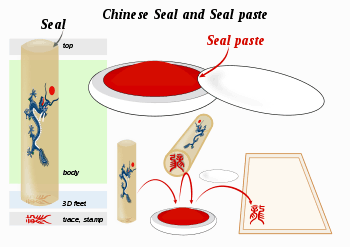
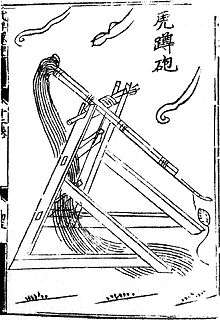
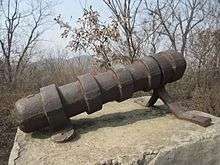
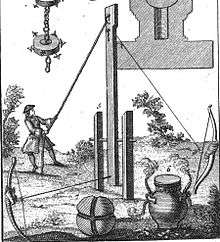
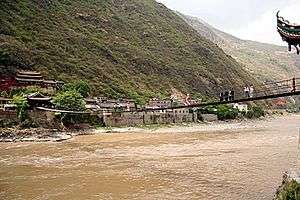
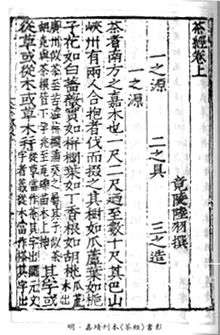
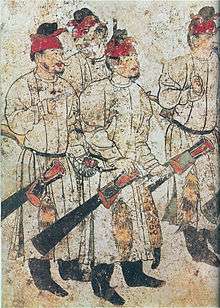
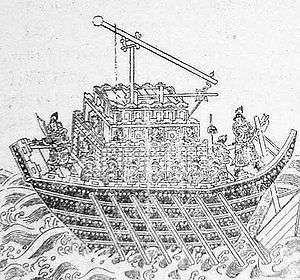
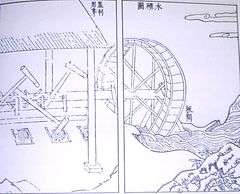
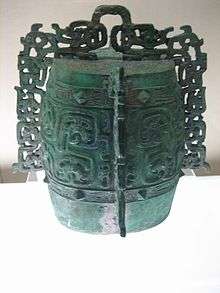
- Salt mining: Ancient China was among the earliest civilizations in the world with cultivation and trade of salt mining.[620] They first discovered natural gas when they excavated rock salt as the Chinese writer, poet, and politician Zhang Hua of the Jin Dynasty wrote in his book Bowuzhi how people in Zigong, Sichuan excavated natural gas and used it to boil a rock salt solution.[538] The ancient Chinese gradually mastered and advanced the techniques of producing salt. Salt mining was an arduous task for the ancient Chinese, where they faced geographical and technological constraints. Salt was mainly extracted from the sea and salt works in the coastal areas in late imperial China equated to more than 80 percent of national production.[621] In conjunction to this, the Chinese made use of natural crystallization of salt lakes and constructed some artificial evaporation basins close to the shores.[620] In 1041, during the medieval Song dynasty, the Chinese drilled a well with a diameter about the size of a bowl and several dozen feet deep was drilled for salt production.[538] In Southwestern China, natural salt deposits were mined with bores that could reach to a depth of more than 1000 meters but the yields of ground and salt were relatively low.[621] As salt was a necessity of life for human civilization, salt mining played a pivotal role as one of the most important sources of Imperial Chinese government revenue and state development.[621]
- Salt well: The Chinese have been using brine wells and a form of salt solution mining as part of their civilization for more than 2000 years.[194] The first recorded salt well in China was dug in the Sichuan province around 2,250 years ago. This was the first time that ancient water well technology was applied successfully for the exploitation of salt, and marked the beginning of Sichuan’s salt drilling industry.[76] Shaft wells were sunk as early as 220 BC in the Sichuan and Yunnan provinces.[194] By 1035 AD, Chinese in the Sichuan area were using percussion drilling to recover deep brines, a technique that would not be introduced to Europe and the Western World for another 600 to 800 years. Medieval and modern European travelers to China between 1400 and 1700 AD reported salt and natural gas production from dense networks of brine wells.[194] Archaeological evidence of Song dynasty salt drilling tools used are kept and displayed in the Zigong Salt Industry Museum.[622] Many of the wells were sunk deeper than 450 m and at least one well was more than 1000 meters deep. The medieval Venetian traveler to China Marco Polo reported an annual production in a single province of more than 30,000 tonnes of brine during his time there.[194] According to Salt: A World History, a Qing Dynasty well, also located in Zigong, "continued down to 3,300 feet [1,000 m] making it at the time the deepest drilled well in the world."[623]
- Seal: The Chinese have been using fingerprints as a means for identification, authentication, and verification dating back before the 3rd century BC.[624][625][626][627][628] This has been recorded since the 3rd century BCE in China – continuing for at least a millennium, and by the 8th century AD the practice had spread to Japan. Chinese dynastic history would utilize ancient fingerprint authentication technology long before European historical fingerprint records.[627] Chinese documents bore a clay seal marked by the fingerprint of the originator.[627][628][629] The clay seal would provide evidence tracing the fingerprint back the originator and the uniqueness of the signature would be used for means of authentication. Signatures were utilized by the Chinese to consider the impression of a fingerprint on a document to be a unique signature. The seal would also contain a left thumbprint embedded on one side and a Chinese script on the other for authentication.[627] Fingerprints were used as identifying marks in ancient China during the Qin and Han dynasties as early as 246 BCE.[627][628] Chinese seals were used by individuals as signatures for many kinds of official documents, such as army rosters, engagements and divorces, deeds for lands and homes, legal papers and financial transactions.[627][625] In addition to clay seals, the Chinese also used bamboo and wooden slips to record fingerprints were used in burglary crime scene investigations.[627] With the invention of paper by the Han dynasty and Six Dynasties period, the availability of paper and silk would replace bamboo as a medium for recording fingerprints. Fingerprints were also used as evidence in criminal and civil disputes as well as recording confessions. Kia Kung-Yen, a Chinese historian of the Tang dynasty mentions the use of Chinese documents dating from the Tang dynasty, which allude to fingerprints used to seal contracts and legal documents.[627][628] Yung-Hwui, a Chinese law book, specified that in order for a husband to divorce must present a document giving the reasons for the action, all letters must be in his handwriting and if unable to write, he must sign with his fingerprints.[629][630][631] In his Jami al-Tawarikh (Universal History), the Persian physician Rashid-al-Din Hamadani (also known as "Rashideddin", 1247–1318) refers to the Chinese practice of identifying people via their fingerprints, commenting: "Experience shows that no two individuals have fingers exactly alike."[632]
- Seismometer: The Chinese polymath and inventor Zhang Heng (78–139) of the Han Dynasty (202 BC – 220 AD) invented the first seismometer in 132, a large metal urn-shaped instrument which employed either a suspended pendulum or inverted pendulum acting on inertia (i.e. ground tremors from earthquakes) to dislodge a metal ball by a lever trip device; this ball would fall out of dragon-shaped metal mouth into the corresponding metal toad mouth indicating the exact cardinal direction of where a distant earthquake had occurred in order for the state to send swift aid and relief to the affected regions; several subsequent recreations of his device were employed by Chinese states up until the Tang Dynasty (618–907), when use of the device fell into obscurity, a fact noted even by the writer Zhou Mi around 1290, during the Yuan Dynasty (1271–1368).[619][633][634][635][636][637][638][639]
- Snap fastener: Some of the oldest snap fasteners and snap-together connectors were made of metal and developed for the Chinese Terracotta army dating back to 210 BC.[640][641][642][640] The horse halters, comprised a gold and silver tube were linked with metal snap fasteners and made using advanced fastener-making technologies during the Qin dynasty.[642] Inside the halters laid a pin that was able to be pulled out allowing the snap to unfasten so the halters were able to be removed.[643][640]
- Snow gauge: The first use of snow gauges were precipitation gauges that was widely used in 1247 during the Southern Song dynasty to gather meteorological data. The Song Chinese mathematician and inventor Qin Jiushao records the use of gathering rain and snowfall measurements in the Song mathematical treatise Mathematical Treatise in Nine Sections. The book discusses the use of large conical or barrel-shaped snow gauges made from bamboo situated in mountain passes and uplands which are speculated to be first referenced to snow measurement.[644][644][437]
- Solid-propellant rocket: The medieval Song dynasty Chinese invented the solid-propellant rocket at a time when bows, arrows, and catapult-based projectile launchers were state of the art military technology in medieval Europe.[598] Illustrations and descriptions in the 14th century Chinese military treatise Huolongjing by the Ming dynasty military writer and philosopher Jiao Yu confirm that the Chinese in 1232 used proto-solid propellant rockets then known as "fire arrows" to drive back the Mongols during the Siege of Kaifeng.[602][645] Each arrow took a primitive form of a simple, solid-propellant rocket tube that was filled gunpowder. One open end allowed the gas to escape and was attached to a long stick that acted as a guidance system for flight direction control.[645][602]
- South-pointing chariot: Although the claim of Wei Dynasty mechanical engineer and statesman Ma Jun (fl. 220–265) that the south-pointing chariot was first invented by the mythological Yellow Emperor are dubious, his south-pointing chariot was successfully designed and tested in 255 AD with many later models recreated in subsequent dynasties; this device was a wheeled vehicle with differential gears that ensured a mounted wooden figurine would always point in the southern direction no matter how the vehicle turned, in essence a non-magnetic compass.[646][647][648] The Book of Song written in the 6th century states that the device was successfully reinvented by the mathematician and astronomer Zu Chongzhi (429–500) during the Liu Song Dynasty (420–479).[649] The Japanese historical text Nihon Shoki, compiled by 720, states that the device was crafted and presented as a gift to Emperor Tenji (661–672) on two different occasions (658 and 666) by the Tang Dynasty (618–907) Chinese Buddhist monks Zhi Yu and Zhi You.[650] The wheeled vehicle device was described in intricate detail in the historical text covering the Song Dynasty (960–1279), i.e. the Song Shi (compiled 1345); for example, it revealed the number of gear teeth on each mechanical gear wheel, the diameter of each gear wheel, and how these gear wheels were properly positioned.[651]
- Soybean oil: Chinese records dating prior to 2000 BC mention the use of cultivated soybeans to produce edible soy oil.[652] Ancient Chinese literature reveals that soybeans were extensively cultivated and highly valued as a use for the soybean oil production process before written records were kept.[653]
- Soy sauce: Soy sauce in its current form was created about 2,200 years ago during the Western Han dynasty and was soon spread throughout East and Southeast Asia where it is used in cooking and as a condiment.[654][655][656][657] The condiment considered almost as old as soy paste — a type of fermented paste (Jiang, 酱) obtained from soybeans — which had appeared during the Western Han dynasty and was listed in the bamboo slips found in the archaeological site Mawangdui.[656][655]
- Squatting-tiger fire trebuchet: According to the Song dynasty military compendium Wujing Zongyao (published 1044), the hu dun pao or squatting-tiger trebuchet is depicted as a traction trebuchet with a triangular frame.[658] It is operated by a dedicated corps of 70 haulers, who took turns pulling the ropes attached to the trebutchet arm to send the projectile, a 16-pound (7.3 kg) stone or bomb, into flight.[659] It has a range of 85 yards (78 m).[658] The Annales ianuenses, an official history of Genoa, carries drawings of trabuchium, a counterweighted trebuchet with triangular supporting trusses, that British historian, scientist, and sinologist Joseph Needham considers to be derived from or related to the Chinese "Crouching Tiger Trebuchet".[660] Similar triangular-framed trebutchets are found in Byzantine sources as labdarea (lambda-shaped machines) and as "Turkish trebuchets" (manjanīq turkī) by Mardi ibn Ali al-Tarsusi and the Templar of Tyre.[661] Mao Yuanyi (茅元儀; 1594–1640), the compiler of the Ming dynasty military treatise Wubei Zhi, considered the "Crouching Tiger Trebuchet" as an ancestor to the cannon along with other bomb-throwing trebuchets.[662]
- Steel made from cast iron through oxygenation: The earliest known production of steel is a piece of ironware excavated from an archaeological site in Anatolia (Kaman-Kalehoyuk) and is about 4,000 years old.[663] Other ancient steel comes from East Africa, dating back to 1400 BC.[664] In the 4th century BC steel weapons like the Falcata were produced in the Iberian Peninsula, while Noric steel was used by the Roman military.[665] The Chinese, who had been producing cast iron from the late Spring and Autumn period (722–481 BC), produced steel by the 2nd century BC through a process of decarburization, i.e. using bellows to pump large amounts of oxygen on to molten cast iron.[331][666] This was first described in the Han Dynasty (202 BC – 220 AD) book Huainanzi, compiled by scholars under Prince Liu An (179–122 BC). For steel, they used both quenching (i.e. rapid cooling) and tempering (i.e. slow cooling) methods of heat treatment. Much later, the American inventor William Kelly (1811–1888) brought four Chinese metallurgists to Eddyville, Kentucky in 1845, whose expertise in steelmaking influenced his ideas about air injection to reduce carbon content of iron; his invention anticipated the Bessemer process of English inventor Henry Bessemer (1813–1898).[667]
- Sticky rice mortar: Hydraulic mortar was not available in ancient China, possibly due to a lack of volcanic ash. Around 500 CE, sticky rice soup was mixed with slaked lime to make an inorganic−organic composite mortar that had more strength and water resistance than lime mortar.[668][669] Sticky rice played a major role in maintaining the durability of the Great Wall as well as tombs, pagodas, and city walls.[670] Sticky rice mortar had high adhesive strength, sturdiness, waterproof, and prevented weeds from growing as crude mortar made of sticky rice and burnt lime created a seal between bricks that would rival modern cement in strength. During the Ming Dynasty (1368 – 1644 AD), brick-making techniques in terms of quantity and quality of production improved significantly.[671] Since then, Great Wall sections were widely built with bricks, with lime mortar and sticky rice used to reinforce the bricks strong enough to resist earthquakes and modern bulldozers while keeping the building intact. Modern chemists through their research identified amylopectin, a type of polysaccharide, or complex carbohydrate, found in rice and other starchy foods is the secret that appears to be responsible for the sticky rice mortar's strength and durability.[672][673]
- Stinkpot: The stinkpot was an earthenware incendiary weapon part filled with sulphur, gunpowder, nails, and shot, while the other part was filled with noxious materials designed to emanate a highly unpleasant and suffocating smell to its enemies when ignited.[674] The weapon was used in the 19th century during the Qing Dynasty, where the British Admiral Sir William Robert Kennedy recorded the use of the stinkpot in 1856 during the Second Opium War in his book Hurrah for the Life of a Sailor - Fifty Years in the Royal Navy. These incendiary weapons were wrapped in calico bags and were then hoisted in a basket to the truck of the mast.[675] When an enemy ship was alongside, one of the crew members would climb up the mast and primed the stinkpots with lighted joss sticks.[675] The stinkpots were then launched onto the enemy deck by cutting the rope by which the basket had been hoisted.[676] The ensuing noise, flying debris, and pungent smell would create, would cause the enemy crew sufficient confusion and blow them into disarray.[674]
- Stir frying: Stir frying is a Chinese cooking technique used for preparing food in a wok. It originates from the Han Dynasty, but did not fully develop until the Song Dynasty.[677] Although there are no surviving records of Han Dynasty stir frying, archaeological evidence of woks and the tendency to slice food thinly indicate that the technique was likely used for cooking.[678] It was not until the Ming Dynasty that stir frying was popularized as primary cooking method of Chinese cuisine.[679] Stir frying was brought to America by early Chinese immigrants, and has been used for non-Asian cuisines.[680]
- Stirrup: There are authors who point out that it is unclear whether the stirrup was invented by northern nomads or the sedentary Chinese.[681] Liu Han (1961) credited the invention of the stirrup to nomadic invaders of northern China.[682] Archaeologial evidence shows that horse riders in India had a small loop for a single toe to be inserted by roughly the 1st century AD.[683] However, the first true depiction of the stirrup is featured on a Jin Dynasty (265–420) Chinese tomb figurine dated 302 AD, yet this was a single stirrup and was perhaps used only for initially mounting the horse.[684] The first validated depiction of a rider with a pair of saddle stirrups for both feet comes from a Jin Chinese tomb figurine dated 322.[684] The first actual specimens of stirrups comes from a Chinese tomb in southern Manchuria that is dated 415.[684] The stirrup was not widely used by Chinese cavalry until the 5th century.[683][685] By the 6th century, the use of the stirrup had spread as far west as the Byzantine Empire, where both the stirrup and Celtic horseshoe were adopted.[683]
- Sunglasses: The first sunglasses were invented in 12th century China when medieval Chinese magistrates wore smoke-colored lenses to conceal their eyes and feelings during trials while questioning the witnesses and accused. They were a crude slab of smoked quartz that was made to block out the light from the sun.[686][687][688]
- Suspension bridge using iron chains: Although there is evidence that many early cultures employed the use of suspension bridges with cabled ropes, the first written evidence of iron chain suspension bridges comes from a local history and topography of Yunnan written in the 15th century, which describes the repair of an iron chain bridge during the reign of the Yongle Emperor (r. 1402–1424); although it is questionable if Ming Dynasty (1368–1644) Chinese claims that iron chain suspension bridges existed since the Han Dynasty, their existence in the 15th century predates that of anywhere else.[689] K.S. Tom mentions this same repaired Ming suspension bridge described by Needham, but adds that recent research has revealed a document which lists the names of those who allegedly built an iron chain suspension bridge in Yunnan around the year 600 AD.[690]
T
- Tangram: The tangram is a dissection puzzle consisting of seven flat shapes, which are put together to form shapes. The objective of the puzzle is to form a specific shape using all seven pieces, which may not overlap. The game is reputed to have been invented in China during the Song Dynasty,[691] and was popularized in Europe and United States during the 19th century.[692] The word tangram is likely derived from two words, the Chinese word tang, referring to the medieval Chinese Tang Dynasty, and the Greek word gramma, a synonym of "graph".[693]
- Tea: The tea plant is indigenous to western Yunnan;[694] by the mid 2nd millennium BC, tea was being consumed in Yunnan for medicinal purposes.[695] Tea drinking was already an established custom in the daily life in this area as shown by the Contract with a Slave, written by Wang Bao in 59 BC.[696] This written record also reveals that tea was processed and used as a drink instead of a medicinal herb, emerged no later than the 1st century BC.[697] Early Chinese tea culture began from the time of Han Dynasty (202 BC – 220 AD) to the Southern and Northern Dynasties (420–589) when tea was widely used by Chinese gentry, but only took its initial shape during the Tang Dynasty (618–907).[698]
- Teabag: Packing tea in paper goes back to medieval 8th century China, during the Tang Dynasty when paper was folded and sewn into square bags to preserve tea flavoring and aromas. Then the paper tea bags were stitched from all sides to create protective casings for the tea leaves.[699][700][701] Modern tea bags in the Western World would not be patented until 1903.[702]
- Teapot: The teapot was invented during the Yuan Dynasty, tea preparation in previous dynasties did not utilize a teapot.[703] In the Tang Dynasty, a cauldron was used to boil grounded tea, which was served in bowls. Song Dynasty tea was made by pouring water boiled using a kettle into a bowl with finely ground tea leaves. A brush was then used to stir the tea. The innovation of the teapot, a vessel that steeps tea leaves in boiling water, occurs during the late Yuan dynasty. Written evidence of a teapot appears in the Yuan Dynasty text, Jiyuan Conghua, which describes a teapot that the author, Cai Shizhan, bought from the scholar Sun Daoming. By the Ming Dynasty, teapots were widespread in China.[703]
- Thyroid hormones to treat goiters: In 239 BC, Master Lu's Spring and Autumn Annals stated that where water is too light, people suffer widespread baldness and goiter.[704] It was not until the 1860 that French physician Gaspard Adolphe Chatin (1813–1901) linked goiter with the lack of iodine in soil and water; iodine was discovered in the thyroid gland in 1896 by German chemist Eugen Baumann, while thyroid extract was used to treat patients in 1890. The Tang Dynasty (618–907) physician Zhen Quan (d. 643 AD), in his Old and New Tried and Tested Prescriptions, stated that the thyroid glands taken from gelded rams were used to treat patients with goiter; the thyroid hormones could be swallowed in pill form (the body of the pill made from crushed jujube pulp) or as a solid thyroid gland with the fat taken off.[704] The Pharmacopoeia of the Heavenly Husbandman asserted that iodine-rich sargassum was used to treat goiter by the 1st century BC (Ge Hong, 284–364, also suggested using a tincture derived from sargassum seaweed in about 340 AD),[705] a treatment later recorded in the Western World by Italian practrica Roger of Palermo in his Practica Chirurgiae of 1180 AD.
- Tianchi Basins: As precipitation was for important agriculture and food production, the Song Chinese mathematician and inventor Qin Jiushao developed a precipitation gauge that was widely used in 1247 during the Southern Song dynasty to gather meteorological data. Qin Jiushao later records application of rainfall measurements in the mathematical treatise Mathematical Treatise in Nine Sections. The book also discusses problems using large snow gauges made from bamboo situated in mountain passes and uplands which are speculated to be first referenced to snow measurement.[644][644][437] Tianchi Basins were installed at provincial and district capitals and bamboo snow gauges were situated in mountain passes. The rain gauges were conical or barrel-shaped with one being installed at each provincial and district capital in China. In the treatise, Qin Jiushao also discusses how point measurements were converted to real averages. These averages were important as they postulated indicators of natural disasters such as flooding, since river flooding has always been a problem in China.[644][644]
- Tofu: Although both popular tradition and Song Dynasty philosophers like Zhu Xi (1130–1200 AD) credit the invention of tofu—along with soymilk— to Liu An (179–122 BC), a Han-Dynasty King of Huainan, no mention of tofu is found in the extant Huainanzi (compiled under Liu An).[706][707][708] The earliest known mention of tofu was made in Records of the Extraordinary (Qingyi lu 清異錄), which reported that tofu was sold at Qingyang (Anhui).[709] The earliest explanation of how to make tofu is found in the Bencao Gangmu, written by the Ming dynasty polymath Li Shizhen (1518–1593).[708] According to Liu Keshun (1999), Liu An's process for making tofu was essentially the same as today.[710]
- Toilet paper: Toilet paper was first mentioned by the Sui Chinese politician and artist Yan Zhitui (531–591) in the year 589 during the Sui Dynasty, with full evidence of continual use in subsequent dynasties.[711][712] By the mid 14th century during the Yuan Dynasty (1271–1368), it was written that ten million packages of 1,000 to 10,000 sheets of toilet paper were manufactured annually in Zhejiang province alone.[711]
- Tower ships: Historical records relating to invention of Chinese tower ships are found in sources such as the Wujing Zongyao, written during the Song Dynasty, and the Taibai Yinjing from the Tang Dynasty. Chinese tower ships were naval warships meant to be a central vessel in the fleet, the louchuan was equipped for boarding and attacking enemy vessels, as well as with siege weapons including traction trebuchets for ranged combat against enemy ships.[713]
- Traction trebuchet: The earliest type of trebuchet catapult was the traction trebuchet, developed first in China by the 5th or 4th century BC, the beginning of the Warring States period (403–221 BC); to operate the trebuchet, a team of men pulled on ropes attached to the butt of the shorter segment of a long wooden beam separated by a rotating axle fixed to a base framework, allowing the longer segment of the beam to lunge forward and use its sling to hurl a missile; by the 9th century a hybrid of the traction and counterweight trebuchet, employing manpower and a pivoting weight, was used in the Middle East, Mediterranean Basin, and Northern Europe; by the 12th century, the full-fledged counterweight trebuchet was developed under the Ayyubid dynasty of Islamic Syria and Egypt (described by Mardi bin Ali al-Tarsusi) and used in the Third Crusade; by the 13th century, the counterweight trebuchet found its way into Song Dynasty (960–1279) China via the Mongol invaders under Kublai Khan (r. 1260–1294) who used it in the Siege of Xiangyang (1267–1273).[714][715][716]
- Trip hammer: The ancient Chinese used pestle and mortar to pound and decorticate grain, which was superseded by the treadle-operated tilt hammer (employing a simple lever and fulcrum) perhaps during the Zhou Dynasty (1122–256 BC) but first described in a Han Dynasty (202 BC – 220 AD) dictionary of 40 BC and soon after by the Han dynasty philosopher and writer Yang Xiong (53 BC – 18 AD) in his Fangyan dictionary written in 15 BC; the next stage in this evolution of grain-pounding devices was to apply hydraulic power, which the Han dynasty philosopher and writer Huan Tan (43 BC – 28 AD) mentioned in his Xinlun of 20 AD, although he also described trip hammers powered by the labor of horses, oxen, donkeys, and mules.[717] After Huan Tan's book was written, numerous references to trip hammers powered by waterwheels were made in subsequent Chinese dynasties and in Medieval Europe by the 12th century.[718] However, trip hammers were also attested by both literary (Pliny, Natural History 18.97) and archaeological evidence in fairly widespread use in the Roman Empire by the 1st century AD.[719][720]
- Tuned bells: The earliest complete set of tuned bells, sixteen in all, were found in Tomb 8 of Marquis Su of Jin at Qucun, southern Shanxi.[721] The tomb has been dated by AMS radiocarbon techniques to 815–786 BC, during the period of the Zhou Dynasty.[722] Of the sixty-four bronze bells found in the tomb of Marquis Yi of Zeng interred by 433 BC, forty-seven of them produce two notes with minor third intervals while sixteen produce two notes with major third intervals.
- Tung oil: The tung oil tree originates in southern China and was cultivated there for tung oil, but the date of cultivation remains unknown.[723] During the Song Dynasty, tung oil was used for waterproofing on ships.[724] Tung oil is etymologically derived from the Chinese tongyou.[725] The earliest references for Chinese use of tung oil is in the writings of Confucius around 500 to 400 BC[726][727][728][729] The Chinese have used tung oil, also known as China wood oil, for at least 2500 years for building waterproof boats and paper parasols, wood finishing, wood waterproofing, caulking, inks and paints.[730]
- Two-stage rocket: The 14th-century Chinese military treatise compiled and edited by Chinese military strategists and philosophers Jiao Yu and Liu Bowen of the early Ming dynasty (1368–1683) Huolongjing describes and illustrates the oldest known two-stage rocket invented in the 13th century; this was the "fire-dragon issuing from the water" (huo long chu shui), which was known to be used by the Song and Ming Chinese navies.[731][732] The two-stage rocket had a carrier and booster rocket that would automatically ignite a number of smaller rocket arrows that were shot out of the front end of the missile shaped like a dragon's head with an open mouth that exploded on impact, before eventually burning out.[733][323] The British scientist, historian, and sinologist Joseph Needham says that the written material and illustration of this rocket come from the oldest stratum of the Huolongjing.[731]
U
- Umbrella: In all written records, the oldest reference to a collapsible umbrella dates to the year 21 AD, when Wang Mang (r. 9–23) had one designed for a ceremonial four-wheeled carriage.[734] The 2nd-century commentator Fu Qian added that this collapsible umbrella of Wang Mang's carriage had bendable joints which enabled them to be extended or retracted.[735] A 1st century collapsible umbrella has since been recovered from the tomb of Wang Guang at Lelang Commandery in the Korean Peninsula, illustrated in a work by Harada and Komai.[736] However, the Chinese collapsible umbrella is perhaps a concept that is yet centuries older than Wang's tomb. Zhou Dynasty bronze castings of complex bronze socketed hinges with locking slides and bolts—which could have been used for parasols and umbrellas—were found in an archeological site of Luoyang, dated to the 6th century BC.[736]
- Underwater salvage operation: In 219 BC, Emperor Qin Shihuang (r. 221–210 BC) assembled an expedition consisting of a thousand people for the salvage of the Nine Tripod Cauldrons. The tripods were considered important artifacts, Chinese legends credit a Xia dynasty emperor with their construction. The tripods were lost in Sishui River in present-day Anhui Province. The salvage attempt was ultimately unsuccessful. Carvings in Han Dynasty tombs depict the salvage attempt.[622] In the 11th century AD, a successful underwater salvage operation in the Song Dynasty (960–1279) which would employ the use of buoyancy.[737] The Chinese understood the concept of buoyancy by at least the 3rd century AD; the short-lived child prodigy Cao Chong (196–208) weighed a large elephant by placing it on a boat in a pond and measuring the rise of the water level, then matching this weight with a boat loaded with numerous heavy objects which could be measured separately.[738] Between 1064 and 1067, the Puchin Bridge near Puchow, a floating bridge built some 350 years earlier across the Yellow River, was destroyed in a flood.[739] This bridge was made of boats secured by iron chains which were attached to eight different cast iron statues located on each river bank, cast in the shape of recumbent oxen.[740] The flood pulled the oxen from the sandy banks into the river, where they sunk to the bottom; after this loss, the local officials issued a proclamation for submission of ideas on how to recover the statues.[739] The plan of the Buddhist monk Huaibing was accepted, which is described in the text Liang Chi Man Chih of 1192, "he used two huge boats filled with earth, cables from them being made fast to the oxen in the river bed (by the drivers). Hooks and a huge counterweight lever were also used. Then the earth in the boats was gradually taken away so that the boats floated much higher and the oxen were lifted off the river bottom."[741]
- Unmanned hot air balloons: The sky lantern is an early unmanned hot air balloon. The Chinese military strategist, politician, writer, and inventor Zhuge Liang of the Three Kingdoms era is credited with its invention, and reportedly used it during military campaigns. According to the British scientist, historian, and sinologist Joseph Needham, hot air balloons have been used in China since the 3rd century BC.[742] In 1783, the French entrepreneurs and inventors Joseph-Michel and Jacques-Etienne Montgolfier took part in the first modern manned hot air balloon flight.[743]
W
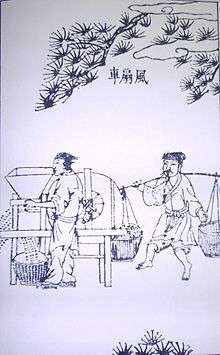

- War wagon: The ancient Chinese invented a mobile-like armored cart used in from the 5th century BC called the Dongwu Che (Chinese: 洞屋车). It was used for the purpose of protecting warriors on the battlefield. The Chinese war wagon was designed as a kind of mobile protective cart with a shed-like roof. It would serve to be rolled up to city fortifications to provide protection for sappers digging underneath to weaken a walls foundation. The early Chinese war wagon would become the basis of technologies for the making of ancient Chinese south-pointing chariots.[744][745]
- Watertight compartments: The Song Dynasty Chinese author Zhu Yu wrote of Song Chinese invented watertight compartments in his book, Pingzhou Table Talks, written from AD 1111 to 1117 and published in 1119.[746][747][748][749] Chinese shipbuilders made sailboats with bulkheads and watertight compartments as early as the second century AD.[750][751] Bulkhead watertight compartments improved buoyancy and protected cargo. The Song dynasty Chinese ran with the idea of junks featured watertight compartments. The watertight compartments were there to ensure that if one part of the ship was leaking, the ship itself would not sink. Song Chinese naval engineers came up with this idea by cutting up bamboo plants. In a bamboo plant, the stem is split into sections and at the end of a section there is a plug-like device that lets in water, but does not let it out. By using this as a model, they were able to make a large scale version that would protect the ship. In addition, the compartments were used as storage tanks in which fresh drinking water could be stored for sailors on board. Compartments were also used to help control the masts and sails so they could all be used at once.[752][753] The wide application of Chinese watertight compartments soon spread across East Asia and later to the Europeans through contacts with Indian and Arab merchants.[754]
- Weeding rakes: As weeding was a constant issue in the ancient and medieval Chinese agricultural process, it led to the invention of the weeding rake. The invention of the Chinese weed rake is derived from the invention of the Chinese harrow.[406] In the Chinese agricultural text Qimin Yaoshu written by the Northern Wei Dynasty official Jia Sixie. Harrows were originally called iron-teeth rakes due to its shaping. According to its shape, the Chinese harrow was divided into three sub-classifications: Strip rake, Y-shaped rake, and square rake. The harrows seen in the murals of the Wei and Jin Dynasties are strip rakes.[755]
- Well drilling: The earliest record of well drilling dates from 347 AD in China.[756] Petroleum was used in ancient China for "lighting, as a lubricant for cart axles and the bearings of water-powered drop hammers, as a source of carbon for inksticks, and as a medical remedy for sores on humans and mange in animals."[757] In ancient China, deep well drilling machines were in the forefront of brine well production by the 1st century BC. The ancient Chinese developed advanced sinking wells and were the first civilization to use a well-drilling machine and to use bamboo well casings to keep the holes open.[758][759][76][760]
- Well-field system: The well-field system was a Chinese land distribution method existing between the ninth century BC (late Western Zhou dynasty) to around the end of the Warring States period. Its name comes from Chinese character 井 (jǐng), which means 'well' and looks like the # symbol; this character represents the theoretical appearance of land division: a square area of land was divided into nine identically-sized sections; the eight outer sections (私田; sītián) were privately cultivated by serfs and the center section (公田; gōngtián) was communally cultivated on behalf of the landowning aristocrat.[761]
- Wheat gluten: The earliest description of wheat gluten comes from 6th century China.[762] It was widely consumed by the Chinese as a substitute for meat, especially among adherents of Buddhism.[502] The oldest reference to wheat gluten appears in the Qimin Yaoshu, a Chinese agricultural encyclopedia written by Jia Sixie in 535. The encyclopedia mentions noodles prepared from wheat gluten called bo duo. Wheat gluten was known as mian jin by the Song dynasty (960–1279).[762]
- Wheelbarrow: The earliest wheelbarrows with archaeological evidence in the form of a one-wheel cart come from 2nd century Han Dynasty Emperor Hui's tomb murals and brick tomb reliefs.[763] The painted tomb mural of a man pushing a wheelbarrow was found in a tomb at Chengdu, Sichuan province, dated precisely to 118 CE.[764] The stone carved relief of a man pushing a wheelbarrow was found in the tomb of Shen Fujun in Sichuan province, dated circa 150 CE.[765] And then there is the story of the pious Dong Yuan pushing his father around in a single-wheel lu che barrow, depicted in a mural of the Wu Liang tomb-shrine of Shandong (dated to 147 CE).[766] However, there are even earlier accounts than this that date back to the 1st century BCE and 1st century CE. The 5th century Book of Later Han stated that the wife of the once poor and youthful imperial censor Bao Xuan helped him push a lu che back to his village during their feeble wedding ceremony, around 30 BCE.[764] Later, during the Red Eyebrows Rebellion (c. 20 CE) against Xin dynasty's Wang Mang (45 BCE–23 CE), the official Zhao Xi saved his wife from danger by disguising himself and pushing her along in his lu che barrow, past a group of brigand rebels who questioned him, and allowed him to pass after he convinced them that his wife was terribly ill.[764] The first recorded description of a wheelbarrow appears in Liu Xiang's work Lives of Famous Immortals. Liu describes the invention of the wheelbarrow by the legendary Chinese mythological figure Ko Yu, who builds a "Wooden ox".[183]
- Winnowing fan: Contemporary to the rotary air conditioning fan invented by Han dynasty mechanical engineer Ding Huan (fl. 180 AD) is a pottery tomb model of a crank-operated rotary winnowing fan from the Han Dynasty, used for separating chaff from grain.[767][768] The winnowing fan was first described by the Tang Dynasty writer and linguist Yan Shigu (581–645), in his commentary on the Jijiupian dictionary written earlier in 40 BC by Shi Yu; it was also mentioned in a poem by the Song Dynasty artist Mei Yaochen in about 1060.[769] The earliest known drawn illustration of the winnowing fan comes from the Book of Agriculture published in 1313 by Yuan dynasty inventor and politician Wang Zhen (fl. 1290–1333).[770]
- Wok: The cast-iron Wok was invented in China during the Han dynasty. The round-bottomed cooking vessel is central to Chinese cooking and soon spread to other Asian culinary spheres due to its unique concave shape and ability to sear food at a fast pace.[771][772]
- Wrapping paper and paper envelope: The use of wrapping paper is first documented in ancient China, where paper was invented in the 2nd century BC.[773] In the Southern Song dynasty, monetary gifts were wrapped with paper, forming an envelope known as a chih pao. The wrapped gifts were distributed by the Chinese court to government officials.[774] In the Chinese text Thien Kung Khai Wu, Sung Ying-Hsing states that the coarsest wrapping paper is manufactured with rice straws and bamboo fiber.[775] Although the Hall brothers Rollie and Joyce Hall, founders of Hallmark Cards, did not invent gift wrapping, their innovations led to the development of modern gift wrapping. They helped to popularize the idea of decorative gift wrapping in the 20th century, and according to Joyce Hall, "the decorative gift-wrapping business was born the day Rollie placed those French envelope linings on top of that showcase."[776]
- Wrought iron: During the Han dynasty, new iron smelting processes led to the manufacture of new wrought iron implements for use in agriculture, such as the multi-tube seed drill and iron plough.[777] In addition to accidental lumps of low-carbon wrought iron produced by excessive injected air in ancient Chinese cupola furnaces. The ancient Chinese created wrought iron by using the finery forge at least by the 2nd century BC, the earliest specimens of cast and pig iron fined into wrought iron and steel found at the early Han Dynasty (202 BC – 220 AD) site at Tieshengguo.[778][331] Pigott speculates that the finery forge existed in the previous Warring States period (403–221 BC), due to the fact that there are wrought iron items from China dating to that period and there is no documented evidence of the bloomery ever being used in China.[332] The fining process involved liquifying cast iron in a fining hearth and removing carbon from the molten cast iron through oxidation.[331] Wagner writes that in addition to the Han Dynasty hearths believed to be fining hearths, there is also pictoral evidence of the fining hearth from a Shandong tomb mural dated 1st to 2nd century AD, as well as a hint of written evidence in the 4th century AD Daoist text Taiping Jing.[333]
X
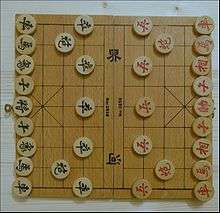
- Xiangqi (See also: List of Chinese inventions#L – Liubo): The exact origins of the Chinese chess board game known as xiangqi are ambiguous. Historian David H. Li asserts that it was first invented by Han Xin (d. 196 BC), a renowned military general of the early Han Dynasty who fell victim to a purge instigated by Empress Lü Zhi (d. 180 BC).[779] Li states that it was revived under a different, camouflaged name of xiangxi by Emperor Wu of Northern Zhou (r. 561–578), which to this day has made the two terms synonymous and interchangeable for the same game.[780]
- Xiaochi: Xiaochi (Chinese: 小吃; pinyin: xiǎochī; literally: "small eats")[781] are forms of Chinese street food and serve as substantial snacks, which could be eaten together or with more substantial dishes like the Spanish tapas or Middle Eastern Levantine meze, or alone as a light meal or snack like the French goûter. Typically, they are most commonly served by outlets ranging from market stalls to teahouses and restaurants in areas of heavy pedestrian traffic: for example near temples and markets in the commercial centres of Chinese towns and cities. The so-called "four great xiaochi clusters" of mainland China are all based around temples:[782] Taiwanese food critic Shu Kuo-chih describes xiaochi as "food from a street stall, shop or even a restaurant that comes in small portions and could never be considered a 'square meal' on its own. In New York, he says, 'hot dogs or nachos could be xiaochi.' Dim sum? Definitely."[783]
Z
- Zoetrope: British sinologist, scientist, and historian Joseph Needham described several ancient Chinese devices which he classified as "a variety of zoetrope",[784] but his use of that term appears to have been very broad and unconventional. There is some evidence that a device capable of displaying moving images existed amongst the items of the treasury of the deceased Qin Shi Huang (r. 221–210 BC) of the Qin Dynasty.[785] A magician named Shao Ong who staged a seance for Emperor Wu of Han (r. 141–87 BC) may have used such a device in his performance of 121 BC.[784] Another device that Needham included in the same category comes, according to his dating, from the late Han Dynasty, when the engineer and artisan Ding Huan (丁緩) made a 'nine-storied hill-censer' around 180 AD.[785] This featured figures of birds and other animals which moved when the lamp was lit; the convection of rising hot air currents caused the vanes at the top canopy of the lamp to spin, while the painted figures on paper attached to the side of the cylinder gave the impression that they were in movement.[785]
Modern (1912-present)
- Artemisinin, Tu Youyou, Project 523, Dihydroartemisinin.
- Car fueled by charcoal: In 1931, Tang Zhongming created an internal combustion engine powered by charcoal and mounted it in an automobile.
- Carbon aerogel: In 2013, scientists at Zhejiang University broke the world record for the world's lightest substance, a carbon aerogel weighing in at 0.16 mg/cc.[786]
- Cure of a solid cancer: In 1956, Min Chiu Li, who was educated and worked in the USA after leaving China because of the communist takeover, and Roy Hertz, demonstrated that systemic chemotherapy could result in the cure of a widely metastatic malignant disease by his use of methotrexate to cure women of choriocarcinoma.[787][788]
- Electronic cigarette: Hon Lik, a Chinese pharmacist, is credited with the invention of the modern electronic cigarette. In 2003, he came up with the idea of using a piezoelectric ultrasound-emitting element to vaporise a pressurized jet of liquid containing nicotine diluted in a propylene glycol solution. This design produces a smoke-like vapour that can be inhaled and provides a vehicle for nicotine delivery into the bloodstream via the lungs. He also proposed using propylene glycol to dilute nicotine and placing it in a disposable plastic cartridge which serves as a liquid reservoir and mouthpiece.[789]
- Facekini: The facekini mask is a mask designed for swimmers and beachgoers which covers the head and reveals only the eyes, nose, and mouth.[790][791][792] It was invented by Zhang Shifan, a former accountant from the coastal Chinese city of Qingdao.[793]
- Hydrogen bicycle: In 2007, Pearl (SPHPST.Co), unveiled at the 9th China International Exhibition on Gas Technology the first hydrogen powered bicycle, PHB. It uses a proton exchange membrane fuel cell to generate power.
- Non-invasive prenatal diagnostic testing for Down's Syndrome: Previously, women underwent invasive testing such as amniocentesis or chorionic villus sampling (CVS). This new maternal blood test has the potential to reduce the number of women referred for invasive testing for Down's syndrome by 98 percent. Developed by Chinese researchers in Hong Kong in 2008, this is hailed as a breakthrough.[794]
- Passenger drone: The world's first passenger drone, a drone capable of carrying human cargo, Ehang 184 was unveiled at the Computer Electronics Show (CES) 2016 by Chinese entrepreneurs.[795][796]
- Radar-absorbing active stealth material[797]
- Synthetic bovine insulin: In 1965, Chinese scientists synthesized bovine insulin, with the "same crystalline form and biological activities as natural insulin."[798][799] The project began in 1958, and is considered one of the "first proteins ever synthesized in vitro."[800]
- Stem cell educator therapy: Chinese and US researchers have produced remarkable results for this new treatment of obtaining stem cells from human cord blood to "re-educate" misbehaving immune cells. This result was published in the open-access journal BMC Medicine in January 2012, and offers hope for Type 1 diabetics and potentially may also be used to treat other auto-immune diseases if the approach lives up to early promise.[801][802]
- Turning Urine Samples into Brain Cells: This new technique of reprogramming ordinary cells present in urine into immature brain cells that can form multiple types of functioning neurons and glial cells was developed by Chinese researchers in China, and was published in the scientific journal Nature Methods in December 2012. Instead of using retrovirus, they used vectors which the researchers say is a breakthrough[803] This does not involve embryonic stem cells which come with serious drawbacks when transplanted, such as the risk of developing tumours. This technique makes the procedure of generating Induced pluripotent stem cells far easier and non-invasive, as the cells can be obtained from a urine sample instead of a blood sample or biopsy. This research proves human excreta could be a powerful source of cells to study disease, bypassing some of the problems of using stem cells, and could be useful for research studying the cellular mechanisms of neurodegenerative conditions such as Alzheimer's and Parkinson's and for testing the effects of new drugs that are being developed to treat them.[804][805][806]
See also
- Chinese exploration
- History of Chinese archaeology
- History of science in Classical Antiquity
- History of science and technology in China
- History of typography in East Asia
- List of China-related topics
- List of Chinese discoveries
- List of Japanese inventions
- List of Korean inventions
- List of Taiwanese inventions and discoveries
- Science and technology of the Han Dynasty
- Technology of the Song Dynasty
References
Citations
- ↑ Joseph Needham, Science and Civilisation in China, 1954–2008, Cambridge University Press
- ↑ Bowman (2000), 104–105.
- ↑ Levathes (1994), 37–38.
- ↑ Hsu (1988), 96.
- ↑ Bellwood (2006), 106.
- ↑ Needham (2004) p201.
- ↑ Bray (1978), 24–26.
- ↑ Bray (1978), 27–28.
- ↑ Needham (1986), Volume 4, Part 1, p. 290.
- ↑ Buisseret (1998), 12.
- ↑ Needham (1985), Volume 5, Part 1, 1–2, 40–41, 122–123, 228.
- ↑ Bowman (2000), 594.
- 1 2 Tom (1989), 99.
- 1 2 Day & McNeil (1996), 122.
- ↑ Cotterell (2004), 11–13.
- ↑ Cotterell (2004), 11.
- ↑ Pan (1997), 979–980.
- ↑ Needham and Tsien (1985), Volume 5, Part 1, 149–150.
- 1 2 Needham (1986), Volume 5, Part 1, 151.
- ↑ Needham, Volume 5, Part 1, 201–202.
- 1 2 Gernet (1996), 335.
- 1 2 Bowman (2000), 599.
- ↑ Day & McNeil (1996), 70.
- ↑ Needham (1986), Volume 5, Part 1, 205–207.
- ↑ Needham, Volume 5, Part 1, 212.
- 1 2 Bowman (2000), 601.
- ↑ Needham (1986), Volume 5, Part 1, 203.
- ↑ Needham, Volume 5, Part 7, 8–9, 80–82.
- ↑ Needham (1986), Volume 5, Part 7, 70–73, 120–124.
- 1 2 3 Gernet (1996), 311.
- ↑ Day & McNeil (1996), 785.
- ↑ Needham (1986), Volume 5, Part 7, 24–25, 345–346.
- 1 2 Li Shu-hua (1954), 176, 180.
- ↑ Carlson (1975), 753–760.
- ↑ Blanc (1985), 125, 128, 132–133, 136.
- ↑ Knoblock (2001), 218.
- ↑ Rickett (1998), 426.
- ↑ Carlson (1975), 755.
- 1 2 Gernet (1962), 77.
- ↑ Tom (1989), 98–99.
- ↑ Lacheisserie (2005), 5
- ↑ Aczel (2002), 80.
- ↑ Needham (1986), Volume 4, Part 1, see 261 footnote. f for ch. 52 on ladle and 232 footnote. d for ch. 47 on magnet (c.f. Lunheng ch. 52 & ch. 47).
- ↑ Sivin (1995), III, 21–22.
- ↑ Needham (1986), Volume 4, Part 1, 279.
- ↑ Elisseeff (2000), 296.
- ↑ Gernet (1996), 328.
- 1 2 3 Day & McNeil (1996), 636.
- ↑ Needham (1986), Volume 4, Part 1, 252.
- ↑ Sivin (1995), III, 21.
- ↑ McGovern, P. E.; Zhang, J.; Tang, J.; Zhang, Z.; Hall, G. R.; Moreau, R. A.; Nunez, A.; Butrym, E. D.; Richards, M. P.; Wang, C. -S.; Cheng, G.; Zhao, Z.; Wang, C. (2004). "Fermented beverages of pre- and proto-historic China". Proceedings of the National Academy of Sciences. 101 (51): 17593–17598. Bibcode:2004PNAS..10117593M. doi:10.1073/pnas.0407921102. PMC 539767. PMID 15590771.
- ↑ "The Earliest Alcoholic Beverage in the World". Penn Museum. University of Pennsylvania Museum of Archaeology and Anthropology. Retrieved 9 June 2013.
- ↑ Vouillamoz, J. F.; McGovern, P. E.; Ergul, A.; Söylemezoğlu, G. K.; Tevzadze, G.; Meredith, C. P.; Grando, M. S. (2006). "Genetic characterization and relationships of traditional grape cultivars from Transcaucasia and Anatolia". Plant Genetic Resources: characterization and utilization. 4 (2): 144–158. doi:10.1079/PGR2006114.
- ↑ Cavalieri, D; McGovern P.E.; Hartl D.L.; Mortimer R.; Polsinelli M. (2003). "Evidence for S. cerevisiae fermentation in ancient wine" (PDF). Journal of Molecular Evolution. 57 Suppl 1: S226–32. Bibcode:2003JMolE..57S.226C. doi:10.1007/s00239-003-0031-2. PMID 15008419. 15008419. Archived from the original (PDF) on December 9, 2006. Retrieved 2007-01-28.
- 1 2 "Fermented fruits and vegetables. A global perspective". FAO Agricultural Services Bulletins - 134. Archived from the original on January 19, 2007. Retrieved 2007-01-28.
- ↑ Dirar, H., (1993), The Indigenous Fermented Foods of the Sudan: A Study in African Food and Nutrition, CAB International, UK
- ↑ Huang (2002), 20–27.
- ↑ Falkenhausen (1994), 132, Appendix I 329, 342.
- ↑ Falkenhausen (1994), 134.
- 1 2 Wang (1997), 93–96.
- ↑ Underhill (2002), 106.
- ↑ Legge (2004), 525.
- ↑ Watson (2003), 101.
- ↑ Mair (1997), 336.
- 1 2 3 Luan (2006), 49–55.
- ↑ "Remnants of an Ancient Kitchen Are Found in China". The New York Times.
- ↑ "Harvard, BU researchers find evidence of 20,000-year-old pottery". Boston.com.
- 1 2 Wu, X.; Zhang, C.; Goldberg, P.; Cohen, D.; Pan, Y.; Arpin, T.; Bar-Yosef, O. (2012). "Early Pottery at 20,000 Years Ago in Xianrendong Cave, China". Science. 336 (6089): 1696–1700. Bibcode:2012Sci...336.1696W. doi:10.1126/science.1218643. PMID 22745428.
- ↑ Zielinski (6 February 2013). "Stone Age Stew? Soup Making May Be Older Than We'd Thought". NPR. Retrieved 8 February 2013.
- 1 2 3 Lu (2006), 123–124.
- ↑ Liang (2004),35&38
- ↑ Chen (2003), 24.
- ↑ Ma (1987), 122.
- ↑ Gabriel, 143.
- ↑ Wang(1982),123
- 1 2 3 Kuhn, Oliver (2004-06-30). "Ancient Chinese Drilling". Canadian Society of Exploration Geophysicists. Canadian Society of Exploration Geophysicists. 29 (6).
- 1 2 Chang, Mingteh (2012). Forest Hydrology: An Introduction to Water and Forests (3rd ed.). CRC Press (published November 1, 2012). p. 31. ISBN 978-1439879948.
- ↑ Angelakis, Andreas N.; Mays, Larry W.; Koutsoyiannis, Demetris; Mamassis, Nikos (2012). Evolution of Water Supply Through the Millennia. Iwa Publishing (published January 1, 2012). pp. 202–203. ISBN 978-1843395409.
- ↑ Koon, Wee Kek (July 25, 2015). "How the ancient Chinese looked after their drinking water". South China Morning Post.
- ↑ Yoshinori Yasuda (2012). Water Civilization: From Yangtze to Khmer Civilizations. Springer Science & Business Media. pp. 30–35.
- ↑ Brook, 19–20
- ↑ Earliest Chinese building brick appeared in Xi'an (中國最早磚類建材在西安現身). takungpao.com (28 January 2010)
- ↑ China's first brick, possible earliest brick in China (藍田出土"中華第一磚" 疑似我國最早的"磚")
- ↑ 西安發現全球最早燒制磚 (Earliest fired brick discovered in Xi'an). Sina Corp.com.tw. 30 January 2010 (in Chinese)
- ↑ Li, Geng (2014). Ruggles, Clive, ed. Gnomons in Ancient China Handbook of Archaeoastronomy and Ethnoastronomy. Springer New York (published July 7, 2014). p. 2095. ISBN 978-1-4614-6141-8.
- ↑ Li, Geng (9 July 2017). Handbook of Archaeoastronomy and Ethnoastronomy. p. 2095. Bibcode:2015hae..book.2095L. doi:10.1007/978-1-4614-6141-8_219.
- ↑ Li, Geng (2014). Ruggles, Clive, ed. Gnomons in Ancient China Handbook of Archaeoastronomy and Ethnoastronomy. Springer New York (published July 7, 2014). pp. 2095–2096. ISBN 978-1-4614-6141-8.
- ↑ Siegel, Jeremy (2005). The Future for Investors: Why the Tried and the True Triumphs Over the Bold. Crown Business. p. 209. ISBN 978-1400081981.
- ↑ Liu, Li 2003:3-15
- 1 2 Fiero, Gloria K. The Humanistic Tradition 6th Ed, Vol. I. McGraw-Hill, 2010.
- ↑ Pope-Henessey, Chapter II.
- ↑ Howard, 19-22
- ↑ Loewe (1968), 170–171.
- ↑ Stark (2005),30
- 1 2 3 Wang (1982),80
- ↑ Loewe (1999),178.
- ↑ Buckley Ebrey, Patricia. "Jade from Fu Hao's Tomb". A Visual Sourcebook of Chinese Civilization. University of Washington. Retrieved August 4, 2007.
- ↑ Loewe (1968), 186–187.
- ↑ Murphy (2007), 114, 184.
- ↑ Sagart (2005), 21.
- ↑ Bellwood (2004), 121.
- ↑ Murphy (2007), 186–187.
- ↑ Deng (1997), 22.
- ↑ Nelson (1995), 85.
- ↑ The Japan Times. (10 February 1999). Oldest oar unearthed from Ishikawa ruins. Retrieved on 2008-08-13.
- ↑ Liu (2007), 65.
- ↑ Wu (1990), 349–365
- ↑ Liu (2007), 126.
- ↑ Liu (2007), 66.
- ↑ Harris (1996), 427–428.
- ↑ You Archived 2011-07-06 at the Wayback Machine. (1999), 1–8.
- ↑ Chen (1995), 198.
- ↑ Cheng (2005), 102–107.
- ↑ Underhill (2002), 156 & 174.
- ↑ Hu (2005), 159.
- ↑ Liu (2007), 132.
- ↑ Red Pottery Urn Coffin Archived 2009-06-08 at the Wayback Machine.. cultural-china.com. Retrieved on 2008-08-03
- ↑ Legge (2004), 108.
- ↑ Greenberger, Robert (2005). The Technology of Ancient China. Rosen Publishing Group. p. 10. ISBN 978-1404205581.
- ↑ Huang, H.T. (2000). Science and Civilisation in China: Volume 6, Biology and Biological Technology, Part 5, Fermentations and Food Science. 6. Cambridge University Press (published November 30, 2000). p. 463. ISBN 978-0521652704.
- ↑ Shelach-Lavi, Gideon (2015). The Archaeology of Early China: From Prehistory to the Han Dynasty. Cambridge University Press (published January 26, 2015). p. 53. ISBN 978-0521145251.
- ↑ Xujie, Liu; et al. (2002). Steinhardt, Nancy Shatzman, ed. Chinese Architecture. New Haven, CT, USA:Yale University Press ; Beijing, China: New World Press. pp. 12–14, 21–22. ISBN 978-0-300-09559-3. OCLC 186413872.
- ↑ Murphy (2007), 187.
- ↑ Murphy (2007), 187–188.
- ↑ Brook (2004), 81–85.
- ↑ Origins and evolution of the Western diet: health implications for the 21st century. American Journal of Clinical Nutrition. Retrieved on 2008-7-5.
- ↑ Rowan Flad et al. (2005), 12618–12622.
- ↑ A seasoned ancient state: Chinese site adds salt to civilization's rise. Sciencenews.org. Retrieved on 2008-7-5.
- 1 2 Schoeser (2007), 17.
- ↑ Simmons (1950), 87.
- ↑ Murphy (2007), 121.
- ↑ Siddiqi (2001), 389
- ↑ Murphy (2007), 122–123.
- ↑ Murphy (2007), 135.
- ↑ Cao, Zhihong; Fu, Jianrong; Zou, Ping; Huang, Jing Fa; Lu, Hong; Weng, Jieping; Ding, Jinlong (August 2010). "Origin and chronosequence of paddy soils in China". Proceedings of the 19th World Congress of Soil Science: 39–42. Retrieved 8 February 2013.
- ↑ Fujiwara, H. (ed.). Search for the Origin of Rice Cultivation: The Ancient Rice Cultivation in Paddy Fields at the Cao Xie Shan Site in China. Miyazaki: Society for Scientific Studies on Cultural Property, 1996. (In Japanese and Chinese)
- ↑ Omura (2003), 15.
- ↑ Omura (2003), 19 & 22.
- ↑ Zhao (2000), 6–9.
- 1 2 Loewe (1999), 847.
- ↑ Sterckx (2002), 66–67.
- ↑ Williams (1904), 131.
- ↑ Needham (1986), Volume 4, Part 2, 30 & 479 footnote e.
- ↑ Crespigny (2007), 1050.
- ↑ Morton & Lewis (2005), 70.
- ↑ Loewe (1968), 107.
- 1 2 Bowman (2000), 595.
- ↑ Needham 1987, pp. 314–316
- 1 2 3 4 Needham, Joseph (1987). Science & Civilisation in China, volume 7: The Gunpowder Epic. Cambridge University Press. pp. 317–319. ISBN 0-521-30358-3.
- 1 2 Needham (1988), Volume 5, Part 9, 207–208.
- ↑ Loewe, Michael (1997). "Wood and bamboo administrative documents of the Han period". In Edward L. Shaughnessy. New Sources of Early Chinese History. Society for the Study of Early China. pp. 161–192. ISBN 1-55729-058-X.
- ↑ Perkins, Dorothy (1998). Encyclopedia of China: History and Culture. Routledge. p. 24. ISBN 978-1579581107.
- ↑ Ebrey, Walthall, and Palais (2006), 156.
- 1 2 Bowman (2000), 105.
- 1 2 Gernet (1962), 80.
- ↑ Ch'en (1965), 615–621.
- ↑ Gernet (1962), 80–81.
- ↑ Rezende, Lisa (2007). Chronology of Science. Checkmark Books (published April 1, 2007). p. 24. ISBN 978-0816071197.
- ↑ Wagner (2001), 77–80.
- ↑ Crespigny (2007), 184.
- ↑ Needham (1986), Volume 4, Part 2, 370–376.
- ↑ Day & McNeil (1996), 225.
- 1 2 Needham (1986), Volume 4, Part 2, 108.
- ↑ Needham (1988), Volume 5, Part 9, 160–163.
- 1 2 Barbara Ann Kipfer (30 April 2000). Encyclopedic Dictionary of Archaeology. Springer. p. 64. ISBN 978-0-306-46158-3.
- ↑ Donald B. Wagner (1993). Iron and Steel in Ancient China. BRILL. p. 169. ISBN 978-90-04-09632-5.
- ↑ Sen, Tansen (2017). India, China, and the World: A Connected History. Rowman & Littlefield Publishers (published September 20, 2017). p. 104. ISBN 978-1442220911.
- ↑ Hsu, Cho-yun; Cheng, Joseph Y. S.; Baker Jr., Timothy (2012). China: A New Cultural History. Columbia University Press (published June 12, 2012). p. 313.
- 1 2 Peng, Shijiang (1983). "Biological Control – One Of The Fine Traditions Of Ancient Chinese Agricultural Techniques". Scientia Agricultura Sinica. 1: 92–98. Archived from the original on 2016-12-20.
- 1 2 3 Wagner (2001), 7, 36–37, 64–68.
- ↑ Pigott (1999), 183–184.
- ↑ Lu Gwei-Djen, Joseph Needham and Phan Chi-Hsing. Technology and Culture, Vol. 29, No. 3 (Jul., 1988), pp. 594-605
- ↑ Needham (1986), Volume 5, Part 7, 170–174.
- 1 2 Needham (1986), Volume 5, Part 7, 171.
- ↑ Needham (1986), Volume 5, Part 7, 173–174.
- ↑ Needham (1986), Volume 5, Part 7, 170.
- ↑ Loewe (1968), 194.
- 1 2 3 4 5 6 7 Tom (1989), 103.
- 1 2 Hobson, John M. (2004). The Eastern Origins of Western Civilisation. Cambridge University Press. p. 215. ISBN 978-0521547246.
- ↑ Loewe (1968), 191.
- ↑ Wang (1982), 105.
- ↑ Hossain, M. E.; Abdullah Al-Majed, Abdulaziz (2015). Fundamentals of Sustainable Drilling Engineering. Wiley-Scrivener (published March 2, 2015). ISBN 978-0470878170.
- 1 2 Rezende, Lisa (2007). Chronology of Science. Checkmark Books (published April 1, 2007). p. 40. ISBN 978-0816071197.
- 1 2 Conner, Clifford D. (2005). A People's History of Science: Miners, Midwives, and Low Mechanicks. Nation Books. p. 175. ISBN 978-1560257486.
- ↑ "Chinese Inventions". Asia Society.
- ↑ J. James, Peter; Thorpe, Nick (1995). Ancient Inventions. Ballantine Books (published October 31, 1995). p. 337. ISBN 978-0345401021.
- ↑ Eijkhoff, Pieter (2000). Wine in China: Its History and Contemporary Developments (PDF). The Netherlands. p. 24.
- ↑ Eijkhoff, Pieter (2000). Wine in China: Its History and Contemporary Developments (PDF). The Netherlands. p. 24.
- ↑ Needham, Volume 4, Part 2, 28.
- 1 2 Needham, Volume 4, Part 2, 311–315.
- 1 2 Sturgis, R.C. (2015). The Mammals That Moved Mankind: A History of Beasts of Burden. Authorhouse. ISBN 978-1504939447.
- ↑ Micuta, Waclaw. "The Chinese collar". Food and Agriculture Organization of the United Nations.
- 1 2 Krebs, Robert E.; Krebs, Carolyn A. (2003). Groundbreaking Scientific Experiments, Inventions, and Discoveries of the Ancient World. Greenwood (published December 30, 2003). pp. 255–256. ISBN 978-0313313424.
- 1 2 3 4 5 6 Warren, John K. (2016). Evaporites: A Geological Compendium. Springer (published May 18, 2016). p. 1034.
- ↑ "Who invented the toothbrush and when was it invented?". The Library of Congress. 2007-04-04. Retrieved 2008-04-12.
- ↑ Kendall (2006), 2.
- ↑ Needham (1986), Volume 4, Part 3, 391, 422, 462–463.
- ↑ Ebrey, Walthall, and Palais (2006), 159.
- ↑ Needham (1986), Volume 4, Part 3, 420–422.
- ↑ Gernet (1996), 327.
- ↑ Temple (1986), 72.
- 1 2 You (1994), 80.
- ↑ Rodgers, Leo. "A Brief History of Time Measurement". NRICH. Retrieved 4 November 2017.
- ↑ Lu 1988.
- ↑ Andrade 2016, p. 52-53.
- ↑ Ebrey, Walthall, and Palais (2006), 30.
- ↑ Gernet (1996), 69.
- ↑ Wagner (1993), 335.
- ↑ Pigott (1999), 177.
- ↑ Wagner (1993), 336.
- ↑ Wagner, Donald B. (May 2008). Science and Civilisation in China: Volume 5, Chemistry and Chemical Technology, Part 11, Ferrous Metallurgy. Cambridge University Press. pp. 159–169. ISBN 978-0-521-87566-0.
- ↑ Wagner, Donald B. (2008). Science and Civilisation in China: 5. Chemistry and Chemical Technology: part 11 Ferrous Metallurgy. Cambridge University Press, pp. 349–51.
- ↑ Wang (1982), 1982.
- 1 2 Dewar (2002), 42.
- ↑ Wood (1999), 75–76.
- ↑ Ceccarelli (2004), 69.
- ↑ Campbell (2003), 7.
- ↑ Soedel & Foley (1979), 124–125.
- ↑ Needham (1986), Volume 4, Part 2, 109–111.
- ↑ Needham (1986), Volume 4, Part 2, 344.
- ↑ Fry (2001), 11.
- ↑ Needham (1986), Volume 4, Part 2, 111, 165, 456–457.
- 1 2 Gernet (1996), 341.
- ↑ Mary Schoeser (2007). Silk. Yale University Press. p. 18. ISBN 978-0-300-11741-7. Retrieved 15 January 2013.
from the same dates comes the earliest evidence of chain stitch embroidery, worked with silk threads
- ↑ Catherine Amoroso Leslie. Needlework Through History: An Encyclopedia. Greenwood Publishing Group. p. 41. ISBN 978-0-313-33548-8.
- ↑ Lu (2004), 209–216.
- ↑ Le due leggende sulle bacchette cinesi cri.cn. Retrieved on 2008-7-20
- ↑ The National Museum of Mongolian History. washington.edu. Retrieved on 2008-7-20.
- ↑ Needham (1986), Volume 6, Part 5, 104, footnote 161.
- ↑ Cotterell (2004), 102.
- ↑ Ling (1991), 12–23.
- 1 2 Leibs (2004), 30.
- ↑ Leibs (2004), 31.
- ↑ Crespigny (2007), 1222 & 1232.
- ↑ Bielenstein (1980), 9 & 19.
- ↑ Wang (1949), 152.
- ↑ Loewe (1968), 45.
- ↑ Ebrey (2006), 97.
- ↑ Gasciogne and Gasciogne (2003), 95.
- ↑ Hartwell (1982), 416–420.
- ↑ Ebrey (1999), 145–146.
- ↑ Liu, Haifeng, Influence of China’s Imperial Examinations on Japan, Korea and Vietnam -Frontiers of History in China, October 2007, Volume 2, Issue 4, pp 493-512
- ↑ Kracke, 251
- ↑ Ssu-yu Teng, "Chinese Influence on the Western Examination System", Harvard Journal of Asiatic Studies 7 (1942-1943): 267-312.
- ↑ Needham (1986), Volume 4, Part 2, 34.
- ↑ Ebrey, Walthall, and Palais (2006), 158.
- ↑ Ebrey (1999), 144.
- ↑ Hobson (2004), 53.
- ↑ Michael Sullivan (18 June 1984). The Arts of China (Third ed.). University of California Press. p. 203. ISBN 978-0-520-04918-5.
- ↑ Ancient China Math – Copyright © 2010 – TutorVista.com, All rights reserved.
- ↑ 中国独特的计算工具, archived from the original on 2007-11-21, retrieved 2007-12-16
- ↑ Wu Wenjun ed, Grand Series of History of Chinese Mathematics, vol 1, p371
- ↑ 老子: 善數者不用籌策。
- ↑ Needham, Joseph. (1986). Science and Civilization in China: Volume 4, Part 2, Mechanical Engineering. Taipei: Caves Books, Ltd. Pages 118–119.
- 1 2 Quick, Graeme R. (2008). Remarkable Australian Farm Machines: Ingenuity on the Land. Grantham House Publishing. p. 68. ISBN 978-1869341053.
- 1 2 Dorsey, Gray L. (1993). Jurisculture. Transaction Publishers. p. 82. ISBN 978-1560000907.
- ↑ Bautista Paz, Emilio; Ceccarelli, Marco; Otero, Javier Echávarri; Sanz, José Luis Muñoz (2010). A Brief Illustrated History of Machines and Mechanisms. Springer (published May 12, 2010). p. 19. ISBN 978-9048125111.
- ↑ Du Bois, George (2014). Understanding China: Dangerous Resentments. Trafford on Demand. ISBN 978-1490745077.
- ↑ White, Jr. 1962, p. 104:
Yet a student of the Chinese technology of the early twentieth century remarks that even a generation ago the Chinese had not 'reached that stage where continuous rotary motion is substituted for reciprocating motion in technical contrivances such as the drill, lathe, saw, etc. To take this step familiarity with the crank is necessary. The crank in its simple rudimentary form we find in the [modern] Chinese windlass, which use of the device, however, has apparently not given the impulse to change reciprocating into circular motion in other contrivances'. In China the crank was known, but remained dormant for at least nineteen centuries, its explosive potential for applied mechanics being unrecognized and unexploited.
- ↑ Landrus, Matthew (Matt) (2010), Leonardo da Vinci’s Giant Crossbow, Springer Science & Business Media, p. 45, ISBN 3540689184
- ↑ Hurley, Gerald V.(Vic) (2011), Arrows Against Steel: The History of the Bow and how it Forever Changed Warfare, Cerberus Books, p. 217, ISBN 098347561X
- ↑ McCants, Anne, Engineering the Medieval Achievement – A Collection of Information on Engineering During the Middle Ages – The Crossbow, MIT Retrieved on 04 January 2017.
- ↑ Wagner (1993), 153, 157–158.
- ↑ A Crossbow Mechanism with Some Unique Features from Shandong, China Archived 2008-05-18 at the Wayback Machine.. Asian Traditional Archery Research Network. Retrieved on 2008-08-20.
- ↑ Mao (1998), 109–110.
- ↑ Wright (2001), 159.
- ↑ Lin (1993), 36.
- ↑ Wright (2001), 42.
- ↑ Needham (1986), Volume 5, Part 6, 124–128.
- ↑ Lewis (2000a), 45.
- 1 2 3 Speak (1999), 32.
- ↑ Pigott (1999), 191.
- ↑ Wagner (2001), 75–76.
- ↑ Tom 2001, p. 207
- ↑ Graff 2002, p. 41
- ↑ Lorge 2011, pp. 69-70.
- ↑ Bjørklund G (1989). "The history of dental amalgam (in Norwegian)". Tidsskr Nor Laegeforen. 109 (34–36): 3582–3585. PMID 2694433.
- 1 2 3 Czarnetzki, A.; Ehrhardt S. (1990). "Re-dating the Chinese amalgam-filling of teeth in Europe". International Journal of Anthropology. 5 (4): 325–332.
- ↑ "Information about Chinese yo-yo". www.hcs.harvard.edu. Retrieved 2016-01-18.
- ↑ "Origin of Toys: The Chinese Kouen-gen" (1893), Nature. (in French)
- ↑ "History", DiabolArt.Free.Fr. (in French)
- ↑ "The Accordion", CrossSound.com. Accessed: November 30, 2016.
- ↑ Missin, Pat. "Western Free Reed Instruments"
- 1 2 3 4 5 Lo (2000), 401.
- ↑ Pickover (2002), 141.
- ↑ Rodney P. Carlisle (2 April 2009). Encyclopedia of Play. SAGE. p. 181. ISBN 978-1-4129-6670-2. Retrieved 5 October 2012.
- 1 2 Fletcher (1996), 693.
- ↑ Needham (1986), Volume 4, Part 3, 100.
- ↑ Worcester, George. The Junks and Sampans of the Yangtze River, 1971.
- ↑ Kerr, 348–350
- ↑ Wood
- ↑ Vainker, 50–51; Rawson, 364–365
- ↑ "Ancient Nanfeng Kiln", China Tour Advisors
- 1 2 3 Broudy (1979), 124.
- ↑ Forbes (1987), 218 & 220.
- 1 2 Beaudry (2006), 146.
- ↑ Broudy (1979), 130–133.
- 1 2 3 4 5 Smil, Vaclav (2017). Oil – A Beginner's Guide. Oneworld Publications. ISBN 978-1786072863.
- 1 2 Heshelow, Kathy (2010). Investing in Oil and Gas: The ABC's of DPPs. Iuniverse. p. 52. ISBN 978-1450261715.
- ↑ Levathes, Louise (1994). When China Ruled the Seas. Oxford University Press. p. 77. ISBN 978-0-19-511207-8.
- ↑ Needham, Joseph (1986). Science and Civilization in China: Volume 4 Part 3. Taipei: Caves Books, Ltd. Page 660
- ↑ Bouée, Charles-Edouard (2010). China's Management Revolution: Spirit, Land, Energy. Palgrave Macmillan. p. 84. ISBN 978-0230285453.
- ↑ Woodburne O. Levy; Kavita Kalidas (26 February 2010). Norman S. Miller, ed. Principles of Addictions and the Law: Applications in Forensic, Mental Health, and Medical Practice. Academic Press. pp. 307–308. ISBN 978-0-12-496736-6.
- ↑ Frank Dikotter; Lars Peter Laamann (16 April 2004). Narcotic Culture: A History of Drugs in China. University of Chicago Press. p. 199. ISBN 978-0-226-14905-9.
- ↑ Lewis (2000b), 343–369 (356f.)
- ↑ Needham (1986), Volume 4, Part 2, 89, 445–456, 473–475.
- ↑ Fry (2001), 10.
- ↑ Bodde (1991), 140.
- ↑ Day & McNeil (1996), 781, 786–787.
- ↑ Needham (1986), Volume 4, Part 2, 473–474.
- ↑ Needham (1986), Volume 4, Part 2, 460–462.
- 1 2 3 Needham (1986), Volume 4, Part 2, 460.
- ↑ David Landes: "Revolution in Time: Clocks and the Making of the Modern World", rev. and enlarged edition, Harvard University Press, Cambridge 2000, ISBN 0-674-00282-2, p.18f.
- ↑ Needham (1986), Volume 5, Part 7, 264.
- ↑ Cowley (1996), 49.
- ↑ Needham, Volume 5, Part 7, 267.
- ↑ Sastri, M.N. (2004). Weapons of Mass Destruction. APH Publishing Corporation. p. 1. ISBN 978-8176487429.
- ↑ Singh, Kirpal (2010). Chemistry in Daily Life. Prentice-Hall. p. 68. ISBN 978-8120346178.
- ↑ Sigurðsson, Albert (January 17, 2017). "China's explosive history of gunpowder and fireworks". GB Times.
- ↑ Pomeranz, Ken; Wong, Bin. "China and Europe, 1500–2000 and Beyond: What is Modern?" (PDF). 2004: Columbia University Press.
- ↑ Kerr, Gordon (2013). A Short History of China. No Exit Press. ISBN 978-1842439685.
- ↑ Takacs, Sarolta Anna; Cline, Eric H. (2008). The Ancient World. Routledge. p. 544.
- 1 2 Stamp, Jimmy (February 13, 2013). "The History of Rocket Science". Smithsonian Magazine.
- ↑ Steinkraus, Keith H. (2008). Handbook of indigenous fermented foods. CRC Press. pp. 633–641. ISBN 0-8247-9352-8. More than one of
|ISBN=and|isbn=specified (help) - ↑ James, Peter J.; Thorpe, Nick; Thorpe, I. J. (1995). Ancient Inventions. Ballantine Books. p. 236. ISBN 978-0345401021.
- ↑ Needham 1987, p. 321
- ↑ Needham (1986), Volume 4, Part 2, 159–160, 256–257.
- 1 2 Needham (1986), Volume 4, Part 2, 256.
- ↑ Needham, Volume 4, Part 2, 255.
- ↑ Needham (1986), Volume 4, Part 2, 255–256.
- 1 2 3 4 5 Pigott (1999), 186.
- 1 2 Pigott (1999), 186–187.
- 1 2 Wagner (2001), 80–83.
- ↑ Needham 1986, p. 68.
- ↑ Andrade 2016, p. 31.
- ↑ David Curtis Wright (29 September 2005). Thomas F. Glick; Steven J. Livesey; Faith Wallis, eds. Medieval Science, Technology, and Medicine: An Encyclopedia2. Psychology Press. p. 211. ISBN 978-0-415-96930-7.
- 1 2 Hugh Baker (1 June 2011). Ancestral Images: A Hong Kong Collection. Hong Kong University Press. p. 184. ISBN 978-988-8083-09-1.
- ↑ Needham (1986), Volume 5, Part 7, 224–225, 232–233, 241–244.
- ↑ Embree (1997), 185.
- ↑ Cowley (1996), 38.
- ↑ Needham 1986, p. 222.
- ↑ Chase 2003, p. 31.
- ↑ Lorge 2008, p. 33-34.
- 1 2 Andrade 2016, p. 38.
- ↑ Gernet (1962), 186.
- ↑ Kelly (2004), 2.
- ↑ Needham (1986), Volume 5, Part 7, 485–489.
- ↑ Birrell (1993), 185.
- ↑ Hucker (1975), 206.
- ↑ Ronan (1994), 41.
- 1 2 3 4 5 6 Needham (1986), Volume 4, Part 2, 100 & PLATE CXLVII.
- ↑ Needham (1986), Volume 5, Part 7, 77–78.
- 1 2 Needham (1986), Volume 5, Part 7, 81–84.
- ↑ Gernet (1996), 310.
- 1 2 Needham (1986), Volume 5, Part 7, 169.
- ↑ Needham (1986), Volume 5, Part 7, 331.
- 1 2 3 Handler, Sarah (2007). Austere luminosity of Chinese classical furniture. University of California Press. pp. 268–271, 275, 277. ISBN 978-0-520-21484-2.
- 1 2 3 Mazurkewich, Karen; Ong, A. Chester (2006). Chinese Furniture: A Guide to Collecting Antiques. Tuttle Publishing. pp. 144–146. ISBN 978-0-8048-3573-2.
- 1 2 Needham, Joseph; Tsien, Tsuen-hsuin (1985). Paper and printing, Volume 5. Cambridge University Press. p. 120. ISBN 978-0-521-08690-5.
- 1 2 Lee, O-Young; Yi, Ŏ-ryŏng; Holstein, John (1999). Things Korean. Tuttle Publishing. p. 135. ISBN 978-0-8048-2129-2.
- 1 2 3 4 5 Haskell (2006), 432.
- ↑ Joseph Needham (1986). Military Technology: The Gunpowder Epic. Cambridge University Press. pp. 180–181. ISBN 978-0-521-30358-3.
Then fill in (with a gunpowder core) to a case of cast iron making a fragmentation bomb. When it bursts it breaks into pieces which wound the skin and break the bones (of enemy soldiers) and blinds their eyes
- ↑ Needham (1986), Volume 4, Part 1, 211–212.
- 1 2 3 "Tally(符 Fu)". China Info Online. Archived from the original on 2012-04-24. Retrieved 28 Sep 2011.
- ↑ Lothar von Falkenhausen, "The E Jun Qi Metal Tallies" in Text and Ritual in Early China, 2005:83
- ↑ Crocker 2002, p. 3
- ↑ Quick, P.S. (September 30, 2015). All About: Mighty Middle Chinese Dynasties. AUK Academic.
- ↑ Yigitcanlar, Tan (2016). Technology and the City: Systems, Applications and Implications. Routledge (published May 10, 2016). p. 19. ISBN 978-1138826700.
- 1 2 Khan, Q.S. (2012). How to Prosper the Islamic Way. p. 117.
- ↑ Robbins, Paul (2007). "Encyclopedia of Environment and Society". Sage Publications. p. 1216. Missing or empty
|url=(help) - ↑ Smith, Kimberly (2005). Powering Our Future: An Energy Sourcebook for Sustainable Living. Iuniverse Inc. (published May 31, 2005). p. 56.
- ↑ Rapier, Robert (March 30, 2012). Power Plays: Energy Options in the Age of Peak Oil. Apress (published March 27, 2012). ISBN 978-1430240860.
- ↑ Heshelow, Kathy (2008). Investing in Oil and Gas: The ABC's of DPPs (Direct Participation Program). Iuniverse Inc (published September 2, 2008). p. 52. ISBN 978-0595531929.
- ↑ Conner, Clifford (2005). A People's History of Science: Miners, Midwives, and Low Mechanicks. Nation Books (published November 8, 2005). p. 18. ISBN 978-1560257486.
- ↑ Needham (1986), Volume 4, Part 2, 228–229.
- ↑ Needham (1986), Volume 4, Part 2, 229 & 231.
- ↑ Needham (1986), Volume 4, Part 2, 236.
- ↑ Sarton (1959), 349–350.
- 1 2 Needham (1986), Volume 4, Part 2, 233.
- ↑ Needham (1986), Volume 4, Part 2, 233–234.
- ↑ Needham (1986), Volume 4, Part 2, 234–235.
- ↑ Needham (1986), Volume 4, Part 2, 234.
- ↑ Lasker (1960), xiii.
- ↑ Shotwell, Yang, and Chatterjee (2003), 133.
- ↑ "Goldfish". Ocean Park. Retrieved 2009-11-16.
- ↑ "Background information about goldfish". Retrieved 2006-07-28.
- ↑ Nutrafin Aquatic News, Issue #4, 2004, Rolf C. Hagen, Inc. (USA) and Rolf C. Hagen Corp. (Montreal, Canada)
- ↑ Brunner, Bernd (2003). The Ocean at Home. New York: Princeton Architectural Press. ISBN 1-56898-502-9.
- ↑ Mulertt, Hugo (1883). The Goldfish And Its Systematic Culture With A View To Profit. Retrieved 2009-07-07.
- 1 2 San Diego Chinese Historical Museum. (May–August 2001). Gu Qin: Traditional Chinese Zithers Archived 2005-08-07 at the Wayback Machine.. Sdchm.org. Retrieved on 2008-08-03.
- ↑ Origins of the Qin. silkqin.com Retrieved on 2008-08-22.
- ↑ Lian (2001), 20.
- ↑ Needham (1986), Volume 5, Part 7, 293.
- ↑ "articles – brief history of fans". aboutdecorativestyle.com.
- ↑ "Chinese Hand Fans". hand-fan.org.
- ↑ Robert James Forbes: "Studies in Ancient Technology," Leiden 1993, ISBN 978-90-04-00621-8, p.107
- ↑ Needham, Volume 5, Part 7, 179–180.
- ↑ Gwei-Djen, Lu; Joseph Needham; Phan Chi-Hsing (July 1988). "The Oldest Representation of a Bombard". Technology and Culture. Johns Hopkins University Press. 29 (3): 594–605. doi:10.2307/3105275. JSTOR 3105275.
- ↑ Needham, Volume 5, Part 7, 293.
- ↑ "Pistol, Britannica.com".
- 1 2 3 4 5 6 "Famous Handscroll Paintings and Calligraphic Works" (in English) or "手卷名品展" (in Chinese). Taipei: National Palace Museum. Retrieved 24 September 2011.
- 1 2 3 4 Sze, Mai-Mai (1957). The Tao of painting. Taylor & Francis. pp. 62–65. Retrieved 15 August 2011.
- 1 2 3 4 "Technical Aspects of Painting". Retrieved 15 August 2011.
- 1 2 Dillon, Michael (1998). China: A historical and cultural dictionary. Richmond: Curzon. p. 273. ISBN 978-0-7007-0439-2.
- 1 2 Sullivan, Michael (1984). The arts of China (3rd ed.). London: University of California Press. p. 71. ISBN 978-0-520-04918-5.
- 1 2 3 Lu, Yongxing. A History of Chinese Science and Technology. 2. Springer. p. 366. ISBN 978-3662513897.
- 1 2 Greenberger (2006), 11.
- ↑ Bray (1978), 9 & 19–21.
- ↑ Greenberger (2006), 11–12.
- ↑ Wang (1982), 53–54.
- 1 2 3 4 Leishman, J. Gordon. Principles of Helicopter Aerodynamics. Cambridge aerospace series, 18. Cambridge: Cambridge University Press, 2006. ISBN 978-0-521-85860-1. pp. 7–9. Web extract Archived 2014-07-13 at the Wayback Machine.
- ↑ Joseph Needham (1965), Science and civilisation in China: Physics and physical technology, mechanical engineering Volume 4, Part 2, page 583-587.
- ↑ John D. Anderson (2004). Inventing Flight: The Wright Brothers & Their Predecessors. JHU Press. p. 35. ISBN 978-0-8018-6875-7.
- ↑ Yogerst, Joseph R. (2005). Singapore: State of the Art. R Ian Lioyd Productions Ltd. p. 38. ISBN 978-9810465896.
- ↑ Smith, Ward & Matravers, Brian (1970). Chinese Banknotes, p.144. Shirjieh Publishers, Menlo Park, California
- ↑ Kristofer Schipper (2000). Stephen Little; Shawn Eichman, eds. Taoism and the Arts of China. University of California Press. p. 37. ISBN 978-0-520-22785-9.
- ↑ Colin A. Ronan (20 June 1985). The Shorter Science and Civilisation in China. Cambridge University Press. p. 281. ISBN 978-0-521-31536-4.
- 1 2 Michael Sullivan. The Arts of China. University of California Press. p. 73. ISBN 978-0-520-04918-5.
- 1 2 Needham (1986), Volume 4, Part 2, 319–323.
- ↑ Schur (1998), 66.
- ↑ Needham (1986), Volume 4, Part 2, 326 & Plate CCXXI.
- ↑ Needham (1986), Volume 4, Part 2, 305.
- ↑ Needham (1986), Volume 4, Part 2, 310.
- ↑ Needham (1986), Volume 4, Part 2, 308–312.
- ↑ Needham (1986), Volume 4, Part 2, 22–23.
- 1 2 Beijing service highlight
- ↑ Zimmerman, James M. (2010). China Law Deskbook: A Legal Guide for Foreign-invested Enterprises. American Bar Association. p. 406. ISBN 978-1604429589.
- ↑ Dumas, Charles; Choyleva, Diana (2011). The American Phoenix: And Why China and Europe Will Struggle After the Coming Slump. Profile Books (published October 25, 2011). p. 73. ISBN 978-1846685644.
- ↑ Juneja, Priyanka (July 14, 2017). "China's Hukou System". The Diplomat.
- ↑ Zhou, Ping (March 17, 2017). "China's Hukou System". Thoughtco.
- ↑ Liu, Laura Blythe (2016). Teacher Educator International Professional Development as Ren. Springer. p. 37. ISBN 978-3662516485.
- ↑ Miller, Tom (2012). China's Urban Billion: The Story behind the Biggest Migration in Human History. ISBN 978-1780321417.
- ↑ Kroeber, Arthur R. (2016). China's Economy: What Everyone Needs to Know?. Oxford University Press. pp. 73–75. ISBN 978-0190239039.
- ↑ Liu, Li; Kuang, Lei (2012). Denson, Tom, ed. "Discrimination against Rural-to-Urban Migrants: The Role of the Hukou System in China". U.S. National Library of Medicine. PLOS (published November 5, 2012).
- ↑ Guo, Zhonghua; Guo, Sujian (2015). Theorizing Chinese Citizenship. Lexington Books (published October 15, 2015). p. 104. ISBN 978-1498516693.
- 1 2 Hamblyn, Richard (2010). The Invention of Clouds: How an Amateur Meteorologist Forged the Language of the Skies. Pan Macmillan (published June 4, 2010). pp. 16–17. ISBN 978-0330391955.
- 1 2 3 Selin, Helaine (2008). Encyclopaedia of the History of Science, Technology, and Medicine in Non-Western Cultures (2nd ed.). Springer (published April 16, 2008). p. 736. ISBN 978-1402045592.
- 1 2 David Michael Stoddart (29 November 1990). The Scented Ape: The Biology and Culture of Human Odour. Cambridge University Press. p. 169. ISBN 978-0-521-39561-8.
- ↑ Richards, p. 52
- ↑ Pagani, Catherine (2001). Eastern Magnificence and European Ingenuity: Clocks of Late Imperial China. University of Michigan Press. p. 209. ISBN 0-472-11208-2. Retrieved 2008-06-21.
- ↑ Schafer (1963), pages 160-161
- ↑ Bedini (1994), pages 69-80
- ↑ Gottsegen (2006), 30.
- ↑ Smith (1992), 23.
- ↑ Sun & Sun (1997), 288.
- ↑ Woods & Woods (2000), 51–52.
- ↑ Tingyou Chen (3 March 2011). Chinese Calligraphy. Cambridge University Press. p. 43. ISBN 978-0-521-18645-2.
- ↑ China: Dawn of a Golden Age, 200–750 AD. Metropolitan Museum of Art. 2004. p. 108. ISBN 978-1-58839-126-1.
- ↑ Atkins, Marcie Flinchum (2015). Ancient China. Essential Library. p. 95.
- ↑ Needham (1986), Volume 6, Part 6, 154.
- 1 2 Needham (1986), Volume 6, Part 6, 134.
- ↑ China – history. Encyclopædia Britannica,1994 edition.
- ↑ Needham, Joseph (1986). Science and Civilization in China: Volume 4, Physics and Physical Technology, Part 2, Mechanical Engineering. Taipei: Caves Books Ltd. Pages 344-346.
- ↑ Needham, Volume 4, Part 2, 340-343.
- ↑ Needham, Volume 4, Part 2, 33, 110.
- 1 2 3 4 Needham (1986), Volume 3, 574.
- ↑ Needham (1986), Volume 3, 573.
- ↑ Tom (1989), 112.
- ↑ Tom (1989), 112–113.
- 1 2 Tom (1989), 113.
- ↑ Shi (2003), 63–65.
- ↑ Block (2003), 123.
- ↑ Turnbull (2002), 4, 15–16.
- ↑ Needham (1986), Volume 4, Part 3, 678.
- ↑ Turnbull (2002), 14.
- ↑ Needham (1986), Volume 4, Part 3, 390–391.
- 1 2 Needham (1986), Volume 4, Part 3, 391.
- ↑ Ronan (1994), 67.
- ↑ Mark Denny (1 November 2009). Float Your Boat!: The Evolution and Science of Sailing. Johns Hopkins University Press. p. 27. ISBN 978-0-8018-9568-5.
- ↑ http://www.healthyheating.com/History_of_Radiant_Heating_and_Cooling/History_of_Radiant_Heating_and_Cooling_Part_1.pdf
- ↑ Zhuang, Zhi; Li, Yuguo; Chen, Bin; Jiye; Guo (2009), "Chinese kang as a domestic heating system in rural northern China—A review", Energy and Buildings, 41 (1): 111–119, doi:10.1016/j.enbuild.2008.07.013
- ↑
- ↑ Teng, Jimmy (2014). Musket, Map and Money:: How Military Technology Shaped Geopolitics and Economics. Walter de Gruyter. p. 117. ISBN 978-8376560588.
- ↑ Clancey, Gregory K.; Loy, Hui-chieh (2002). Historical Perspectives on East Asian Science, Technology and Medicine. World Scientific Publishing (published July 24, 2002). p. 498. ISBN 978-9971692599.
- ↑ Deng, Gang (1999). Maritime Sector, Institutions, and Sea Power of Premodern China. Praeger. p. 9. ISBN 978-0313307126.
- ↑ Day & McNeil (1996), 295.
- ↑ Needham (1986), 577–578.
- 1 2 Needham (1986), Volume 3, 580–581.
- 1 2 Serventi, Silvano; Sabban, Francoise (2000). Pasta: The story of a universal food. Translated by Shugaar, Antony. New York: Columbia University Press. p. 337. ISBN 978-0-231-12442-3.
- ↑ Needham (1986), Volume 5, Part 7, 175–176, 192.
- ↑ Needham (1986), Volume 5, Part 7, 24–25, 176, 192.
- ↑ Needham (1986), Volume 5, Part 7, 193 & 199.
- 1 2 Temple, 195.
- 1 2 Johnstone & McGrail (2001), 218.
- ↑ Block (2003), 119–120.
- ↑ McGrail (2004), 237.
- 1 2 Loewe (1986), 141.
- 1 2 Loewe (1968), 144–145.
- 1 2 Li (2004), 8–9 & 13.
- ↑ Handler (2001), 181.
- ↑ Loewe (1999), 839.
- ↑ Li (2005), 66–68.
- ↑ "Magic Mirrors" (PDF). The Courier. Unesco: 16–17. October 1988. ISSN 0041-5278. Retrieved 24 August 2016.
- ↑ Rep (2007), 52.
- 1 2 Rep (2007), 51.
- ↑ Cammann, Schuyler: Birds and Animals as Ming and Ch'ing Badges of Rank", Arts of Asia (May to June 1991), page 89.
- ↑ Cammann, Schuyler: "Development of the Mandarin Square", Harvard Journal of Asiatic Studies Vol VIII, no 2 (1944), pages 75–6.
- ↑ Wood
- 1 2 Rawson, 365, diagram, 370; Wood
- ↑ Needham (1986), Vol 4, Part 1, pp 70-1.
- ↑
- 1 2 Anderson, E.N. (2014). "China". Food in Time and Place. University of California Press. p. 44. ISBN 978-0-520-95934-7.
- 1 2 3 4 5 6 Needham (1986), Volume 4, Part 2, 159.
- ↑ Needham (1986), Volume 4, Part 2, 160.
- 1 2 3 4 5 6 Needham, Volume 4, Part 2, 160.
- ↑ Needham (1986), Volume 4, Part 2, 161 & 417.
- ↑ Ronan (1994), 308.
- ↑ Needham (1986), Volume 4, Part 2, 160 (footnote c and d)
- 1 2 Burbank and Cooper (2010), 51.
- ↑ Kazin, Edwards, and Rothman (2010), 142.
- ↑ Guo (1998), 1–3.
- ↑ Guo (1998), 6–7.
- ↑ Guo (1998), 7–8.
- ↑ Guo (1998), 7.
- ↑ Guo (1999), 97.
- ↑ Goodrich, Kaitlin (September 11, 2015). "6 Monumental Chinese Inventions". Brainscape.
- 1 2 Branscombe, Allison (November 21, 2014). All About China: Stories, Songs, Crafts and More for Kids. ISBN 978-0804841214.
- ↑ Moran, Elizabeth (March 1, 2005). The Complete Idiot's Guide to Feng Shui, 3rd Edition. Penguin. ISBN 978-1592573448.
- ↑ |Title: What Life was Like in the Land of the Dragon |Publisher: Time-Life; First Edition (October 1998) | ISBN 978-0783554587
- ↑ Gruntman, Mike (2005). Blazing the Trail: The Early History of Spacecraft and Rocketry. American Institute of Aeronautics. pp. 5–6. ISBN 978-1563477058.
- ↑ Crosby (2002), 100–103.
- ↑ Needham (1986), Volume 5, Part 7, 472–474.
- ↑ Needham, Volume 5, Part 7, 473–505.
- ↑ Needham (1986), Volume 5, Part 7, 505–510.
- 1 2 Greenberger (2006), 12.
- ↑ Cotterell (2004), 46.
- 1 2 3 Loewe (1968), 191–194.
- ↑ Needham (1986), Volume 5, Part 7, 203–205.
- ↑ Oberg, Erik; Jones, Franklin Day (1917). Machinery's Encyclopedia. p. 412.
The alloy came originally from China, where its composition is said to have been known
- ↑ Dwight Dana, James (1869). Manual of Mineralogy. p. 265.
smuggled into various parts of the East Indies... and is not allowed to be carried out of the empire
- ↑ Yu (2004), p. 134.
- ↑ Needham (1986), Volume 4, Part 3, 177–179.
- ↑ Day & McNeil (1996), 434.
- ↑ Needham (1986), Volume 4, Part 3, Plate CCCL
- 1 2 3 4 Deng, Yinke (2011). "Ancient Chinese Inventions". p. 40. ISBN 978-0521186926. Missing or empty
|url=(help) - ↑ Feng, Lianyong; Hu, Yan; Hall, Charles A. S; Wang, Jianliang (2013). The Chinese Oil Industry: History and Future. Springer (published November 28, 2012). p. 2. ISBN 978-1441994097.
- 1 2 Spataru, Catalina (2017). Whole Energy System Dynamics: Theory, Modelling and Policy. Routledge. ISBN 978-1138799905.
- 1 2 3 Deng, Yinke (2011). "Ancient Chinese Inventions". p. 41. ISBN 978-0521186926. Missing or empty
|url=(help) - ↑ Kristiina A. Vogt (25 June 2012). Sustainability Unpacked: Food, Energy and Water for Resilient Environments and Societies. Routledge. p. 47. ISBN 978-1-136-53060-9.
The first record of drilling for oil occurred in China in 347 CE
- 1 2 Peter J. Golas (25 February 1999). Science and Civilisation in China: Volume 5, Chemistry and Chemical Technology, Part 13, Mining. Cambridge University Press. p. 202. ISBN 978-0-521-58000-7.
- 1 2 Joseph Needham (1985). Science and Civilisation in China: Paper and Printing. Cambridge University Press. p. 122. ISBN 978-0-521-08690-5.
At this time tea was served from baskets made of rushes which held... a set of several tens of paper cups (chih pei) in different sizes and colors with delicate designs
- 1 2 Joseph Needham (1985). Science and Civilisation in China: Paper and Printing. Cambridge University Press. p. 128. ISBN 978-0-521-08690-5. Retrieved 16 April 2013.
- ↑ Deng, Yinke (2011). Ancient Chinese Inventions. Cambridge University Press (published March 3, 2011). pp. 132–133. ISBN 978-0521186926.
- ↑ Beck, Charlotte; Fagan, Brian (1999). The Oxford Companion to Archaeology. Oxford University Press (published April 30, 1999). p. 144. ISBN 978-0195076189.
- ↑ Smil, Vaclav (2006). Transforming the Twentieth Century: Technical Innovations and Their Consequences. Oxford University Press (published April 4, 2006). ISBN 978-0195168754.
- ↑ Smil, Vaclav (2010). Why America Is Not a New Rome. The MIT Press. p. 96. ISBN 978-0262195935.
- ↑ Weissenbacher, Manfred (2009). Sources of Power: How Energy Forges Human History by Manfred Weissenbacher. Praeger. p. 362.
- ↑ Han, Gang; Dusseault, Maurice B.; Detournay, Emmanuel; Thomson, Bradley J.; Zacny, Kris (2009). "2". Principles of Drilling and Excavation (PDF). Wiley (published August 31, 2009). p. 60.
- 1 2 "Cable Tool Drilling". Seismic Water Finder.
- ↑ Manning, John C. (1996). Applied Principles of Hydrology. Prentice Hall. p. 250. ISBN 978-0135655320.
- ↑ Gao, Zhiguo. "Environmental Regulation of Oil and Gas". Kluwer Law International. p. 8. Missing or empty
|url=(help) - ↑ Rapp, George (1985). "Archaeomineralogy". Springer. p. 237. Missing or empty
|url=(help) - ↑ Burke, Michael (September 8, 2008). "Nanotechnology: The Business" (published 2008). p. 3. ISBN 9781420053999. Missing or empty
|url=(help) - ↑ Several papers in The importance of ironmaking: technical innovation and social change: papers presented at the Norberg Conference, May 1995 ed. Gert Magnusson (Jernkontorets Berghistoriska Utskott H58, 1995), 143–179.
- 1 2 Clee (2005), 6.
- 1 2 3 Needham (1986), Volume 4, Part 1, 82.
- ↑ Needham (1986), Volume 4, Part 1, 85.
- ↑ Needham (1986), Volume 4, Part 1, 97–98.
- 1 2 Needham, Joseph (1986). Science and Civilization in China: Volume 4, Part 2. Taipei: Caves Books Ltd. p. 33.
- ↑ Needham, Volume 4, Part 2, 345–46.
- ↑ Needham (1986), Volume 5, Part 1, 131–132.
- 1 2 Zhou (1997), 34.
- ↑ Lo (2000), 390.
- 1 2 3 Needham (1986), Volume 5, Part 1, 132.
- 1 2 Needham (1986), Volume 5, Part 1, 309.
- ↑ Needham, Volume 4, Part 3, 160.
- ↑ Graff, 87.
- ↑ Adshead (2004), 80.
- ↑ Wood (1999), 49.
- ↑ Fong, Nathan (February 5, 2013). "Potstickers: A tasty traditional dish for Lunar New Year". The Vancouver Sun.
- ↑ Parkinson, Rhonda Lauret (2003). The Everything Chinese Cookbook: From Wonton Soup to Sweet and Sour Chicken. Simon & Schuster Canada, Inc.
- ↑ Moore, Frank Gardner: "Three Canal Projects, Roman and Byzantine", American Journal of Archaeology, Vol. 54, No. 2 (1950), pp. 97–111 (99)
- 1 2 Needham (1986), Volume 4, Part 3, 350–352.
- ↑ Day & McNeil (1996), 582.
- ↑ Chen, Cheng-Yih (1987). Science and Technology in Chinese Civilization. World Scientific Pub Co Inc. (published May 1987). p. 237. ISBN 978-9971501921.
- ↑ Needham (1986), Volume 4, Part 2, 156.
- 1 2 3 4 Needham (1986), Volume 4, Part 2, 158.
- ↑ Needham (1986), Volume 4, Part 2, 164.
- ↑ Crespigny (2007), p 659.
- ↑ Sivin (1995), III, p. 22.
- ↑ Needham (1986), Volume 3, pp 579–580.
- ↑ West (1997), 70–76.
- ↑ Gernet (1962), 133–134, 137.
- 1 2 3 Austere Luminosity of Chinese Classical Furniture. University of California Press. 2001. pp. 246–247. ISBN 978-0-520-21484-2.
- ↑ "Rockets appear in Arab literature in 1258 A.D., describing Mongol invaders' use of them on February 15 to capture the city of Baghdad." "A brief history of rocketry". NASA Spacelink. Retrieved 2006-08-19.
- ↑ Crosby, Alfred W. (2002). Throwing Fire: Projectile Technology Through History. Cambridge: Cambridge University Press. pp. 100–103. ISBN 0-521-79158-8.
- 1 2 3 4 5 Needham, Volume 5, Part 7, 510.
- ↑ Needham (1986), Volume 5, Part 7, 498–501.
- 1 2 3 Needham (1986), Volume 5, Part 7, 500.
- ↑ Needham (1986), Volume 5, Part 2, 502.
- ↑ "火龙出水(明)简介". 星辰在线. 2003-12-26. Archived from the original on March 3, 2009. Retrieved July 17, 2008.
- ↑ "中国YJ-62新型远程反舰导弹". 大旗网. 2007-09-30. Retrieved July 17, 2008.
- ↑ Das, SK (2010). All About Rockets. Random House India. ISBN 0143331639.
- ↑ Crawford, Jean; Kinney, Karin (1994). Inventions. Time-Life Books. p. 21.
- ↑ Needham (1974), Volume 5, Part 7, 488.
- ↑ Needham (1974), Volume 5, Part 7, 493.
- ↑ Needham (1974), Volume 5, Part 7, 495.
- 1 2 Hu, Wen-Rui (1997). Space Science in China (published August 20, 1997). p. 15. ISBN 978-9056990237.
- ↑ McGowen, Tom (2008). Space Race: The Mission, the Men, the Moon. Enslow Pub Inc. p. 7. ISBN 978-0766029101.
- ↑ Games, Alex (2007). Balderdash & Piffle. BBC Books. p. 199. ISBN 978-0563493365.
- ↑ Gref, Lynn G. (2010). The Rise and Fall of American Technology. Algora. p. 95. ISBN 978-0875867533.
- 1 2 3 Greatrix, David R. (2012). Powered Flight: The Engineering of Aerospace Propulsion. Springer. p. 1. ISBN 978-1447124849.
- ↑ Mahaffey, James (2017). Atomic Adventures: Secret Islands, Forgotten N-Rays, and Isotopic Murder – A Journey Through The Wild World of Nuclear Science. Pegasus Books. ISBN 978-1681774213.
- ↑ Needham (1986), Volume 4, Part 2, 99, 134, 151, 233.
- ↑ Day & McNeil (1996), 210.
- ↑ Needham, Volume 4, Part 2, 154.
- 1 2 Mott (1991), 2–3, 92, 84, 95f.
- 1 2 Adshead (2000), 156.
- ↑ Needham (1986), Volume 4, Part 3, 627–628.
- ↑ Chung (2005), 152.
- ↑ Johnstone & McGrail (1988), 191.
- ↑ Block (2003), 8–9.
- ↑ Needham (1986), Volume 4, Part 3, 649–650.
- ↑ Fairbank (2006), 192.
- 1 2 3 4 Deng (1997), 42.
- ↑ Christides (1996), 66–67.
- ↑ Tom (1989), 103–104.
- ↑ Gernet (1996), 378.
- 1 2 Tom (1989), 104.
- 1 2 Harris, Peter (2017). Studies in the History of Tax Law. 8. Hart Publications (published August 10, 2017). p. 518. ISBN 978-1509908370.
- 1 2 3 Höllmann, Thomas O. (2013). The Land of the Five Flavors: A Cultural History of Chinese Cuisine. Columbia University Press (published November 26, 2013). p. 33. ISBN 978-0231161862.
- 1 2 Xianyao Li; Zhewen Luo (3 March 2011). China's Museums. Cambridge University Press. pp. 210–211. ISBN 978-0-521-18690-2.
By the time of the Song Dynasty, Chinese craftsmen had invented special tools for digging small-mouth-diameter wells
- ↑ Mark Kurlansky (18 March 2011). Salt: A World History. Random House. p. 364. ISBN 978-0-307-36979-6.
- ↑ Lee, Henry C.; Ramotowski, Robert; Gaensslen, R.E. (2001). Advances in Fingerprint Technology (2nd ed.). CRC Press. p. 13. ISBN 978-0849309236.
- 1 2 Ratha, Nalini; Bolle, Ruud (2011). Automatic Fingerprint Recognition Systems. Springer. ISBN 978-1441930699.
- ↑ O'Brien, James (2017). The Scientific Sherlock Holmes: Cracking the Case with Science and Forensics. Oxford University Press. p. 50. ISBN 978-0190670917.
- 1 2 3 4 5 6 7 8 Daluz, Hillary Moses (2014). Fundamentals of Fingerprint Analysis. CRC Press (published December 1, 2014). p. 15. ISBN 978-1466597976.
- 1 2 3 4 Ashbaugh, David R. (1999). Quantitative-Qualitative Friction Ridge Analysis: An Introduction to Basic and Advanced Ridgeology. CRC Press. p. 15. ISBN 978-0849370076.
- 1 2 Walton, R.H. (2006). Cold Case Homicides: Practical Investigative Techniques. CRC Press. p. 288. ISBN 978-0849322099.
- ↑ Hawthorne, Mark (2008). Fingerprints: Analysis and Understanding. CRC Press (published November 20, 2008). pp. 4–5.
- ↑ See:
- Ashbaugh (1999), page 17.
- Laufer (1912), pp. 642-643.
- E. Chavannes (1905) "Les livres chinois avant l'invention du papier" (Chinese books before the invention of paper), Journal asiatique, 10th series, 5 : 5-75 ; see especially p. 56. From p. 56: "Kia Kong-yen … (vers 650) ajoute ici la glose: "Les entailles faites sur le côté des ces fiches, c'est comme aujourd'hui les emprientes du doigt" … " (Kia Kong-yen … (about 650) adds here the gloss: "The notches made on the sides of these sheets are like fingerprints today" … )
- ↑ Cole, Simon (2001). Suspect Identities: A history of fingerprinting and criminal identification. Cambridge, Massachusetts: Harvard University Press. pp. 60–61. ISBN 0-674-00455-8.
- ↑ Minford & Lau (2002), 307.
- ↑ Balchin (2003), 26–27.
- ↑ Needham (1986), Volume 3, 627–635.
- ↑ Krebs (2003), 31.
- ↑ Wright (2001), 66.
- ↑ Huang (1997), 64.
- ↑ Yan (2007), 131–132.
- 1 2 3 "Terra-cotta Warriors and Horses Museum". China Travel US. Archived from the original on 2017-06-28.
- ↑ Ajesh, Pillai; Bhadalkar, Ameya; Warghane, Rahul; Deokar, Swapnil (2017). "Design and Analysis of Snap Fit Joint with Design Calculator" (PDF). International Conference on Ideas, Impact and Innovation in Mechanical Engineering. International Conference on Ideas, Impact and Innovation in Mechanical Engineering (published June 1, 2017). 5 (6): 644.
- 1 2 "Snap". Sewcratic.
- ↑ Ajesh, Pillai; Bhadalkar, Ameya; Warghane, Rahul; Deokar, Swapnil (2017). "Design and Analysis of Snap Fit Joint with Design Calculator" (PDF). International Conference on Ideas, Impact and Innovation in Mechanical Engineering. International Conference on Ideas, Impact and Innovation in Mechanical Engineering (published June 1, 2017). 5 (6): 644.
- 1 2 3 4 5 6 Strangeways, Ian (2011). Precipitation: Theory, Measurement and Distribution. Cambridge University Press (published April 14, 2011). p. 140. ISBN 978-0521172929.
- 1 2 Nielsen, Leona (1997). Blast Off!: Rocketry for Elementary and Middle School Students P. Libraries Unlimited. pp. 2–4. ISBN 978-1563084386.
- ↑ Needham (1986), Volume 4, Part 2, 40, 286–298.
- ↑ Day & McNeil (1996), 461.
- ↑ Tom (1989), 98.
- ↑ Needham (1986), Volume 4, Part 2, 287.
- ↑ Needham (1986), Volume 4, Part 2, 289.
- ↑ Needham (1986), Volume 4, Part 2, 291–292.
- ↑ Kleinman, George (2013). Trading Commodities and Financial Futures: A Step-by-Step Guide to Mastering the Markets (4th ed.). Financial Times Press (published March 11, 2013). p. 100. ISBN 978-0134087184.
- ↑ Min, David B. (1986). Smouse, Thomas H., ed. Flavor Chemistry of Fats and Oils. American Oil Chemists Society (published January 1, 1986). p. 85. ISBN 978-0935315127.
- ↑ "Soy Sauce, China's Liquid Spice". www.flavorandfortune.com. Retrieved 2016-11-07.
- 1 2 调料文化:酱油的由来
- 1 2 Hsing-Tsung, Huang (2000). Joseph Needham: Science and Civilisation in China, Vol.6, Part 5. Cambridge University Press. p. 346. ISBN 0521652707.
- ↑ Tanaka, Norio. "Shōyu: The Flavor of Japan," Archived 2009-02-26 at the Wayback Machine. The Japan Foundation Newsletter Vol. XXVII, No. 2 (January 2000), p. 2.
- 1 2 Needham & Yates 1994, p. 216.
- ↑ Needham & Yates 1994, p. 217; Needham 1987, p. 278.
- ↑ Needham & Yates 1994, p. 235.
- ↑ Chevedden 2004, p. 255 note 58.
- ↑ Needham 1987, p. 22.
- ↑ "Ironware piece unearthed from Turkey found to be oldest steel". The Hindu. Chennai, India. 2009-03-26. Retrieved 2009-03-27.
- ↑ "Civilizations in Africa: The Iron Age South of the Sahara". Washington State University. Archived from the original on 2007-09-24. Retrieved 2007-08-14.
- ↑ "Noricus ensis," Horace, Odes, i. 16.9
- ↑ Wang (1982), 125.
- ↑ Wagner (2008), pp 363-5.
- ↑ "Revealing the Ancient Chinese Secret of Sticky Rice Mortar". Science Daily. Retrieved 23 June 2010.
- ↑ Yang Fuwei, Zhang Bingjian, Ma Qinglin (2010). "Study of Sticky Rice−Lime Mortar Technology for the Restoration of Historical Masonry Construction". Accounts of Chemical Research. 43: 936–944. doi:10.1021/ar9001944.
- ↑ Watts-Plumpkin, Emma (July 6, 2010). "Sticky rice porridge and the Great Wall of China". World Archaeology.
- ↑ Zhang, Yu-Jie; Luo, Yan-Bing (2013). "Investigation of sticky-rice lime mortar of the Horse Stopped Wall in Jiange". Heritage Science Journal. Springer (published August 15, 2013).
- ↑ Zhang, Bingjian (May 30, 2010). "Revealing the ancient Chinese secret of sticky rice mortar". Phys.
- ↑ Yang, FuWei; Zhang, BingJian; Pan, ChangChu; Zeng, YuYao (2009). "Traditional mortar represented by sticky rice lime mortar—One of the great inventions in ancient China". Science in China. Springer (published June 1, 2009). 52 (6): 1641–1647.
- 1 2 Needham, Joseph (1986). Science and Civilization in China: Volume 5, Chemistry and Chemical Technology, Part 7, Military Technology: the gunpowder epic. Taipei: Caves Books Ltd. Pages 189.
- 1 2 Kennedy, Vice-Admiral Sir William. "Chapter 5: War With China". Hurrah for the Life of a Sailor – Fifty Years in the Royal Navy. ISBN 978-1-4368-7869-2.
- ↑ Kennedy, Vice-Admiral Sir William. "Chapter 7: Evacuation of Canton". Hurrah for the Life of a Sailor – Fifty Years in the Royal Navy. ISBN 978-1-4368-7869-2.
- ↑ Jacqueline M. Newman (1 January 2004). Food Culture in China. Greenwood Publishing Group. pp. 90–91. ISBN 978-0-313-32581-6.
- ↑ E. N. Anderson (1988). The Food of China. Yale University Press. p. 52. ISBN 978-0-300-04739-4.
- ↑ Newman 1945, p. 5
- ↑ Merril D. Smith (9 January 2013). History of American Cooking. ABC-CLIO. p. 65. ISBN 978-0-313-38712-8.
- ↑ Dien (1986), 33–56.
- ↑ Dien (1981), 5–66.
- 1 2 3 Addington (1990), 45.
- 1 2 3 Graff (2002), 42.
- ↑ Hobson (2004), 103.
- ↑ Rubino, Anthony (2010). Why Didn't I Think of That?: 101 Inventions that Changed the World by Hardly Trying. Simon and Schuster (published April 18, 2010). p. 96. ISBN 978-1440500107.
- ↑ "Who Invented Sunglasses?". Glasses History. 2017.
- ↑ Ament, Phil (2006-12-04). "Sunglasses History – The Invention of Sunglasses". The Great Idea Finder. Vaunt Design Group. Retrieved 2007-06-28.
- ↑ Needham (1986), Volume 4, Part 3, 196–197.
- ↑ Tom (1989), 105–106.
- ↑ Jiannong Shi (2 February 2004). Robert J. Sternberg, ed. International Handbook of Intelligence. Cambridge University Press. pp. 330–331. ISBN 978-0-521-00402-2.
- ↑ Brian Bolt (1982). Mathematical activities: a resource book for teachers. Cambridge University Press. p. 45. ISBN 978-0-521-28518-6.
- ↑ The Words of Mathematics: An Etymological Dictionary of Mathematical Terms Used in English. Mathematical Association of America. 1994. p. 218. ISBN 978-0-88385-511-9.
- ↑ Martin (2007), 8.
- ↑ Heiss (2007), 4–6.
- ↑ Needham (1986), Volume 6, Part 5, 513.
- ↑ Wang (2005), 2–3, 11.
- ↑ Wang (2005), 17–20.
- ↑ Tsien, Tsuen-Hsuin (1985). Paper and Printing. Joseph Needham, Science and Civilisation in China, Chemistry and Chemical Technology. Vol. 5 part 1. Cambridge University Press. p. 122.
- ↑ "Facts About Tea Bags". Darjeerling Tea Boutique.
- ↑ Lloyd, Christopher (2009). What on Earth Happened?... in Brief: The Planet, Life and People from the Big Bang to the Present Day. Bloomsbury Publishing. ISBN 978-1408802168.
- ↑ "Tea-leaf holder". USPTO. Retrieved 25 October 2013. US patent 723287 was issued on MAR. 24, 1903 to R. G.LAWSON & M. McLAREN for a 'novel tea-holding pocket constructed of open-mesh woven fabric, inexpensively made of cotton thread'.
- 1 2 Kuei-Hsiang Lo (1986). The Stonewares of Yixing: From the Ming Period to the Present Day. Hong Kong University Press. p. 18. ISBN 978-962-209-112-2. Retrieved 8 February 2013.
- 1 2 Slater, Stefan. "The Discovery of Thyroid Replacement Therapy. Part 1: In the Beginning." Journal of the Royal Society of Medicine 104.1 (2011): 15–18. PMC. Web. 24 Aug. 2016.
- ↑ Medvei (1993), 48.
- ↑ Shurtleff & Aoyagi (2001), 92.
- ↑ Liu (1999), 166.
- 1 2 Yang (2004), 217–218.
- ↑ Shinoda (1963), 4.
- ↑ Liu (1999), 166–167.
- 1 2 Needham, Volume 5, Part 1, 123.
- ↑ Hunter (1978), 207.
- ↑ Needham, Joseph (translated by), Taibai Yinjing, Volume 4, Part 2, pg. 685.
- ↑ Chevedden (1998), 179–222.
- ↑ Turnbull (2001), 9, 45–46.
- ↑ Chevedden (1999), 36.
- ↑ Needham, Volume 4, Part 2, 183–184, 390–392.
- ↑ Needham, Volume 4, Part 2, 379, 392–395.
- ↑ Wilson (2002), 1–32.
- ↑ Burnham (1997) 333–335.
- ↑ Wang (2007), 8 & 26.
- ↑ Guo et al. (1996), 1112–1114.
- ↑ David N. Keightley (1983). The Origins of Chinese Civilization. University of California Press. pp. 50–. ISBN 978-0-520-04229-2.
- ↑ Ebrey, Walthall, and Palais (2006), 133.
- ↑ "Tung oil". Merriam Webster. Retrieved 5 October 2012.
- ↑ McKeon, Thomas; Hayes, Douglas; Hildebrand, David; Weselake, Randall (2016). Industrial Oil Crops. AOCS Press (published March 8, 2016). p. 243. ISBN 978-1893997981.
- ↑ Xia, Wenwen (2015). An Investigation of Chinese Historical Grey Bricks of Soochow, Jiangsu and the Effect of Tung Oil Treatment (Masters thesis). University of Pennsylvania.
- ↑ "The History of Tung Oil". Sutherland Welles.
- ↑ Deyo, Ray (April 1, 2017). "Finishing Tips and Tricks" (PDF). American Association of Woodturners.
- ↑ White, Cynthia (July 1, 2012). "Tung Oil: Debunking the Myths – Canadian Woodworking Magazine". Canadian Woodworking.
- 1 2 Suneja, Vivek (2017). Co-Ed Understanding Business Markets. Routledge. ISBN 978-1138436039.
- ↑ Sastri, M.N. (2004). Weapons of Mass Destruction. APH Publishing Corporation. ISBN 978-8176487429.
- ↑ Murphy, Justin D. (2004). Military Aircraft, Origins to 1918: An Illustrated History of Their Impact. ABC-CLIO. p. 2. ISBN 978-1851094882.
- ↑ Needham, Joseph (1986). Science and Civilization in China: Volume 4, Physics and Physical Technology, Part 2: Mechanical Engineering. Taipei: Caves Books, Ltd. Page 70.
- ↑ Needham, Joseph (1986). Science and Civilization in China: Volume 4, Physics and Physical Technology, Part 2: Mechanical Engineering. Taipei: Caves Books, Ltd. Page 70–71.
- 1 2 Needham, Joseph (1986). Science and Civilization in China: Volume 4, Physics and Physical Technology, Part 2: Mechanical Engineering. Taipei: Caves Books, Ltd. Page 71.
- ↑ Needham (1986), Volume 4, Part 1, 40.
- ↑ Needham (1986), Volume 4, Part 1, 39.
- 1 2 Needham (1986), Volume 4, Part 1, 40–41.
- ↑ Needham (1986), Volume 4, Part 1, 41.
- ↑ Needham (1986), Volume 4, Part 1, 40-.
- ↑ Andreas Wittmer (1 January 2011). Aviation Systems. Springer. p. 7. ISBN 978-3-642-20080-9.
It all began with hot air balloons and kites in China. The Kongming lantern (proto hot air balloon) was known in China from ancient times. Its invention is usually attributed to the general Zhuge Liang... According to Joseph Needham, hot air balloons in China were known since the third century BC
- ↑ Jonathan Shectman (2003). Groundbreaking Scientific Experiments, Inventions, and Discoveries of the 18th Century. Greenwood Publishing Group. p. 12. ISBN 978-0-313-32015-6.
- ↑ Haskew, Michael E; Jorgensen, Christer; McNab, Chris; Niderost, Eric (2008). Fighting Techniques of the Oriental World 1200–1860. Metro Books. p. 179. ISBN 978-1905704965.
- ↑ Lu, Yongxiang (2014). A History of Chinese Science and Technology. 3. Springer (published October 20, 2014). p. 516. ISBN 978-3662441626.
- ↑ Needham, Volume 4, Part 3, 469.
- ↑ Harper, David Adamson (2011) [2011]. "KWANGCHOW – Freddy Everard On The China Seas". BookBaby (published December 30, 2011). Missing or empty
|url=(help) - ↑ The Britannica Guide to Modern China: A Comprehensive Introduction to the World's New Economic Giant. Running Press Book Publishers (published April 30, 2008). 2008. p. 1.
- ↑ Du Bois, George (2014). Understanding China: Dangerous Resentments. Trafford Publishing (published November 8, 2014).
- ↑ Kramer, Lance; Weinberg, Steven (2008). Great Ancient China Projects: You Can Build Yourself. Nomad Press (published June 11, 2008). ISBN 978-1934670026.
- ↑ Hobson, John M. (2004). The Eastern Origins of Western Civilisation. Cambridge University Press. p. 216. ISBN 978-0521547246.
- ↑ Needham, Joseph (1986). Science and Civilization in China: Volume 4, Physics and Physical Technology. 4. Taipei: Caves Books Ltd. p. 362.
- ↑ Richardson, Douglas; Castree, Noel; Goodchild, Michael F.; Kobayashi, Audrey; Liu, Weidong; Marston, Richard A. (2017). International Encyclopedia of Geography. John Wiley & Sons. p. 7161. ISBN 978-0470659632.
- ↑ Richardson, Douglas; Goodchild, Michael F.; Kobayashi, Audrey; Liu, Weidong; Marston, Richard (2017). International Encyclopedia of Geography, 15 Volume Set: People, the Earth, Environment and Technology. Wiley-Blackwell (published March 20, 2017). p. 7161. ISBN 978-0470659632.
- ↑ Ortega, Stephen; Cole, Adrian (2014). The Thinking Past: Questions and Problems in World History to 1750. Oxford University Press (published September 9, 2014). p. 329. ISBN 978-0199794621.
- ↑ Kristiina A. Vogt (25 June 2012). Sustainability Unpacked: Food, Energy and Water for Resilient Environments and Societies. Routledge. p. 47. ISBN 978-1-136-53060-9.
The first record of drilling for oil occurred in China in 347 CE
- ↑ Peter J. Golas (25 February 1999). Science and Civilisation in China: Volume 5, Chemistry and Chemical Technology, Part 13, Mining. Cambridge University Press. p. 202. ISBN 978-0-521-58000-7.
- ↑ Manning, John C. (1996). Applied Principles of Hydrology (3rd ed.). Prentice Hall (published June 24, 1996). p. 154. ISBN 978-0135655320.
- ↑ Greenberger, Robert (2005). The Technology of Ancient China. Rosen Publishing Group. p. 27. ISBN 978-1404205581.
- ↑ Frank Hordeski, Michael (2008). Alternative Fuels: The Future of Hydrogen. CRC Press. p. 51. ISBN 978-1420080162.
- ↑ Zhufu (1981:7)
- 1 2 Shurtleff, William; Aoyagi, Akiko; Huang, H.T. (2014). History of Soybeans and Soyfoods in China and Taiwan, and in Chinese Cookbooks, Restaurants, and Chinese Work with Soyfoods Outside China (1024 BCE to 2014). Soyinfo Center. pp. 2478–2479. ISBN 978-1-928914-68-6.
- ↑ Needham, Volume 4, Part 2, 263-267.
- 1 2 3 Needham, Volume 4, Part 2, 265.
- ↑ Needham, Volume 4, Part 2, 264-265.
- ↑ Needham, Volume 4, Part 2, 263.
- ↑ Needham (1986), Volume 4, Part 2, 118, 153–154, PLATE CLVI.
- ↑ Wang (1982), 57.
- ↑ Needham (1986), Volume 4, Part 2, 153–154.
- ↑ Needham (1986), Volume 4, Part 2, 118, 151–153.
- ↑ Compestine, Ying Chang (2011). The Runaway Wok: A Chinese New Year Tale. Dutton Books for Young Readers (published January 6, 2011). p. 1. ISBN 978-0525420682.
- ↑ Chin, Katie (2016). Katie Chin's Everyday Chinese Cookbook: 101 Delicious Recipes from My Mother's Kitchen. Tuttle Publishing (published May 6, 2016). p. 21. ISBN 978-0804845229.
- ↑ Tsien, Tsuen-Hsuin (1985). "Paper and Printing". Joseph Needham, Science and Civilisation in China, Chemistry and Chemical Technology. 5 part 1. Cambridge University Press: 38.
- ↑ Joseph Needham (1985). Science and Civilisation in China: Paper and Printing. Cambridge University Press. p. 122. ISBN 978-0-521-08690-5. Retrieved 16 April 2013.
In the Southern Sung dynasty, gift money for bestowing upon officials by the imperial court was wrapped in paper envelopes (chih pao)
- ↑ Tsien 1985, p. 123
- ↑ Patrick Regan (15 December 2009). Hallmark: A Century of Giving. Andrews McMeel Publishing. p. 45. ISBN 978-0-7407-9240-3.
- ↑ Kerr, Gordon (2013). A Short History of China. Pocket Essentials. ISBN 978-1842439692.
- ↑ Needham (1995), Volume 5, Part 3, 105.
- ↑ Li (1998), 214.
- ↑ Li (1998), 215.
- ↑ Lin Ming-teh (2006). "Popular Food Culture in Taiwan". Government Information Office. Archived from the original on 2012-06-20.
- ↑ Xinhua, 闻名全国的四大小吃群 Archived 2014-08-19 at the Wayback Machine. ("The four great xiaochi clusters with nationwide fame"), 11 September 2006
- ↑ David Frazier. "Man of the Streets."
- 1 2 Needham (1962), Volume 4, Part 1, 122–123.
- 1 2 3 Needham (1986), Volume 4, Part 1, 123.
- ↑ The Huffington Post. "Lightest Material On Earth: Carbon Aerogel Sets New Record". Huffingtonpost.com. Retrieved 2015-12-24.
- ↑ "Min Chiu Li: A perspective in cancer therapy". Clinical Cancer Research. Retrieved 17 June 2013.
- ↑ "The cure of choriocarcinoma and its impact on the development of chemotherapy for cancer". Gynecologic Oncology. 89: 193–198. doi:10.1016/S0090-8258(03)00110-0. Retrieved 17 June 2013.
- ↑ http://www.spectator.co.uk/2015/06/quitting-is-suffering-hon-lik-inventor-of-the-e-cigarette-on-why-he-did-it/
- ↑ Ye, Tianzhou (21 August 2012). "Facekini craze hits China beach". NBC News. Retrieved 21 August 2012.
- ↑ Farrier, John (22 August 2012). "Fashion trend: The face-kini". Neatorama. Retrieved 22 August 2012.
- ↑ "The facekini: China's new beach trend". The Sun Daily. Retrieved 24 August 2012.
- ↑ "China's famous 'face-kini' gets Peking Opera-inspired facelift". Reuters. Retrieved 15 July 2015.
- ↑ James, Susan Donaldson (12 January 2011). "New Down Syndrome Test Could Cut Healthy Baby Deaths". ABC News.
- ↑ "First passenger drone makes its debut at CES". The Associated Press. The Guardian. Retrieved 24 February 2016.
- ↑ "World's first passenger drone unveiled at CES". Reuters. Retrieved 16 June 2016.
- ↑ http://arstechnica.co.uk/information-technology/2015/11/chinese-scientists-develop-radar-absorbing-active-stealth-material/
- ↑ Needham, Joseph; Ho, Ping-Yü; Lu, Gwei-Djen (1976), Science and Civilisation in China: Chemistry and Chemical Technology, Part III: Spagyrical Technology and Invention, Historical Survey, from Cinnabar Elixirs to Synthetic Insulin, 5.3, Cambridge University Press
- ↑ Li, Jie Jack (2006). Laughing Gas, Viagra, and Lipitor: The Human Stories Behind the Drugs We Use. Oxford University Press. ISBN 978-0-19-530099-4, p. 181
- ↑ Zhang, You Shang (2010). "The first protein ever synthesized in vitro—a personal reminiscence of the total synthesis of crystalline insulin." Science China Life Sciences. 53(1), p. 16-18.
- ↑ Dayton, Leigh (January 11, 2012). "Treatment offers diabetes sufferers hope". The Australian.
- ↑ "Stem Cell Therapy Reverses Diabetes: Stem Cells from Cord Blood Used to Re-Educate Diabetic's Own T Cells". Science Daily. January 10, 2012.
- ↑ "Video". Scientific American. Retrieved 2015-12-24.
- ↑ Costandi, Mo (9 December 2012). "Turning urine into brain cells". The Guardian.
- ↑ Pfeiffer, Eric (10 December 2012). "Scientists create brain cells from human urine". Yahoo News.
- ↑ Baker, Monya (9 December 2012). "Brain cells made from urine". Nature.
Sources
- Aczel, Amir D (2002). The Riddle of the Compass: The Invention that Changed the World. San Diego: Harcourt. ISBN 0-15-600753-3.
- Addington, Larry H. (1990). The Patterns of War Through the Eighteenth Century. Indiana University Press. ISBN 0-253-20551-4.
- Adshead, Samuel Adrian Miles. (2000). China in World History: Third Edition. London: MacMillan Press Ltd. New York: St. Martin's Press. ISBN 0-312-22565-2.
- Adshead, S.A.M. (2004). T'ang China: The Rise of the East in World History. New York: Palgrave Macmillan. ISBN 1-4039-3456-8 (hardback).
- Allan, Sarah (1991). The Shape of the Turtle: Myth, Art and Cosmos in Early China. New York: State University of New York Press. ISBN 0-7914-0459-5.
- An, Lihua. "The Origin of Golden Crow Bearing Sun Image on Han Dynasty's Painting", in Southeast Culture, 1992, No. 1:66–72. ISSN 1001-179X.
- Angier, Natalie. (2007). The Canon: A Whirligig Tour of the Beautiful Basics of Science. Boston: Houghton Mifflin. ISBN 0-618-24295-3.
- Asiapac Editorial. (2004). Origins of Chinese Science and Technology. Translated by Yang Liping and Y.N. Han. Singapore: Asiapac Books Pte. Ltd. ISBN 981-229-376-0.
- Balchin, Jon. (2003). Science: 100 Scientists Who Changed the World. New York: Enchanted Lion Books. ISBN 1-59270-017-9.
- Beaudry, Mary Carolyn. (2006). Findings: The Material Culture of Needlework and Sewing. New Haven: Yale University Press. ISBN 0-300-11093-6.
- Bellwood, Peter (2004). First Farmers: The Origins of Agricultural Societies. Malden, MA: Blackwell Pub. ISBN 0-631-20566-7.
- Bellwood, Peter. (2006). "Asian Farming Diasporas? Agriculture, Languages, and Genes in China and Southeast Asia," in Archaeology of Asia, 96–118, edited by Miriam T. Stark. Malden: Blackwell Publishing Ltd. ISBN 1-4051-0212-8.
- Benn, Charles. (2002). China's Golden Age: Everyday Life in the Tang Dynasty. Oxford University Press. ISBN 0-19-517665-0.
- Bielenstein, Hans. (1980). The Bureaucracy of Han Times. Cambridge: Cambridge University Press. ISBN 0-521-22510-8.
- Birrell, Anne. (1993). Chinese Mythology: An Introduction. Baltimore : Johns Hopkins University Press. ISBN 0-8047-2353-2.
- Block, Leo. (2003). To Harness the Wind: A Short History of the Development of Sails. Annapolis: Naval Institute Press. ISBN 1-55750-209-9.
- Bodde, Derk. (1991). Chinese Thought, Society, and Science. Honolulu: University of Hawaii Press.
- Bowman, John S. (2000). Columbia Chronologies of Asian History and Culture. New York: Columbia University Press. ISBN 0-231-11004-9.
- Bray, Francesca. "Swords into Plowshares: A Study of Agricultural Technology and Society in Early China," in Technology and Culture, Vol. 19, No. 1 (Jan., 1978): 1–31.
- Brook, Timothy (2004). The Chinese State in Ming Society. New York: RoutledgeCurzon. ISBN 0-415-34506-5.
- Broudy, Eric. (1979). The Book of Looms: A History of Handlooms from Ancient Times to the Present. Hanover: University Press of New England. ISBN 0-87451-649-8.
- Buisseret, David. (1998). Envisioning the City: Six Studies in Urban Cartography. Chicago: University Of Chicago Press. ISBN 0-226-07993-7.
- Burbank, Jane and Cooper, Frederick. (2010). Empires in World History: Power and the Politics of Difference. Princeton: Princeton University Press. ISBN 0-691-12708-5.
- Burnham, Barry C. "Roman Mining at Dolaucothi: The Implications of the 1991-3 Excavations near the Carreg Pumsaint", in Britannia, 1997, Vol. 28:325–336.
- Campbell, Duncan (2003). Greek and Roman Artillery 399 BC-AD 363. Oxford: Osprey Publishing. ISBN 1-84176-634-8.
- Carlson, John B. "Lodestone Compass: Chinese or Olmec Primacy?" in Science, New Series, Vol. 189, No. 4205 (Sep. 5, 1975): 753–760.
- Ceccarelli, Marco (2004). International Symposium on History of Machines and Mechanisms. Boston: Kluwer Academic. ISBN 1-4020-2203-4.
- Chen, Cheng-Yih (1995). Early Chinese Work in Natural Science. Hong Kong: Hong Kong University Press. ISBN 962-209-385-X.
- Ch'en, Jerome. "Sung Bronzes—An Economic Analysis," in Bulletin of the School of Oriental and African Studies, Vol. 28, No. 3, (1965): 613–626.
- Chen, Xuexiang. "On the Buried Jade Unearthed in the Erlitou Site, " in Cultural Relics of Central China, 2003, No. 3:23–37. ISSN 1003-1731.
- Cheng, Shihua. "On the Diet in the Liangzhu Culture," in Agricultural Archaeology, 2005, No. 1:102–109. ISSN 1006-2335.
- Chevedden, Paul E. (1998). "The Hybrid Trebuchet: The Halfway Step to the Counterweight Trebuchet," in On the Social Origins of Medieval Institutions: Essays in Honor of Joseph F. O'Callaghan, 179–222, edited by Donald J. Kagay and Theresa M. Vann. Leiden: Koninklijke Brill. ISBN 90-04-11096-8.
- Chevedden, Paul E. (1999). "Fortifications and the Development of Defensive Planning in the Latin East," in The Circle of War in the Middle Ages: Essays on Medieval Military and Naval History, 33–44, edited by Donald J. Kagay and L.J. Andrew Villalon. Woodbridge: The Boydell Press. ISBN 0-85115-645-2.
- Christides, Vassilios. (1996). "New Light on the Transmission of Chinese Naval Technology to the Mediterranean World: The Single Rudder," in Intercultural Contacts in the Medieval Mediterranean, 64–70, edited by Benjamin Arbel. London: Frank Cass and Company Ltd. ISBN 0-7146-4714-4.
- Chung, Chee Kit. (2005). "Longyamen is Singapore: The Final Proof?," in Admiral Zheng He & Southeast Asia. Singapore: Institute of Southeast Asian Studies. ISBN 981-230-329-4.
- Clee, Paul. (2005). Before Hollywood: From Shadow Play to the Silver Screen. New York: Clarion Books, an imprint of Houghton Mifflin Company. ISBN 0-618-44533-1.
- Clunas, Craig. (2004). Superfluous Things: Material Culture and Social Status in Early Modern China. Honolulu: University of Hawaii Press. ISBN 0-8248-2820-8.
- Cotterell, Maurice. (2004). The Terracotta Warriors: The Secret Codes of the Emperor's Army. Rochester: Bear and Company. ISBN 1-59143-033-X.
- Cowley, Robert (1996). The Reader's Companion to Military History. Boston: Houghton–Mifflin Company.
- Crespigny, Rafe de. (2007). A Biographical Dictionary of Later Han to the Three Kingdoms (23–220 AD). Leiden: Koninklijke Brill. ISBN 90-04-15605-4.
- Crosby, Alfred W. (2002), Throwing Fire: Projectile Technology Through History. Cambridge: Cambridge University Press. ISBN 0-521-79158-8.
- Day, Lance and Ian McNeil. (1996). Biographical Dictionary of the History of Technology. New York: Routledge. ISBN 0-415-06042-7.
- Deng, Gang. (1997). Chinese Maritime Activities and Socioeconomic Development, c. 2100 B.C.-1900 A.D. Westport: Greenwood Press. ISBN 0-313-29212-4.
- Deng, Yinke. (2005). Ancient Chinese Inventions. Translated by Wang Pingxing. Beijing: China Intercontinental Press. ISBN 7-5085-0837-8.
- Dewar, Richard. (2002). Stoneware. Philadelphia: University of Pennsylvania Press. ISBN 0-8122-1837-X.
- Dien, Albert E. "A Study of Early Chinese Armor," in Artibus Asiae, 1981, Vol. 43, No. 1/2:5–66.
- Dien, Albert E. "The Stirrup and its Effect on Chinese Military History," in Artibus Asiae, 1986, Vol. 16:33–56.
- Ebrey, Patricia Buckley (1999). The Cambridge Illustrated History of China. Cambridge: Cambridge University Press. ISBN 0-521-66991-X (paperback).
- Ebrey, Patricia Buckley, Anne Walthall, James B. Palais (2006). East Asia: A Cultural, Social, and Political History. Boston: Houghton Mifflin Company. ISBN 0-618-13384-4.
- Elisseeff, Vadime. (2000). The Silk Roads: Highways of Culture and Commerce. New York: Berghahn Books. ISBN 1-57181-222-9.
- Embree, Ainslie Thomas (1997). Asia in Western and World History: A Guide for Teaching. Armonk: ME Sharpe, Inc.
- Fairbank, John King and Merle Goldman (2006). China: A New History; Second Enlarged Edition. Cambridge: MA; London: The Belknap Press of Harvard University Press. ISBN 0-674-01828-1.
- Falkenhausen, Lothar von (1994). Suspended Music: Chime-Bells in the Culture of Bronze Age China. Berkeley: University of California Press. ISBN 0-520-07378-9.
- Flad, Rowan et al. (2005). "Archaeological and chemical evidence for early salt production in China," in Proceedings of the National Academy of Sciences, 2005, Vol. 102, No. 35:12618–12622.
- Fletcher, Banister. (1996). Sir Banister Fletcher's a History of Architecture. Oxford: Architectural Press. ISBN 0-7506-2267-9.
- Forbes, R.J. (1987). Studies in Ancient Technology: The Fibres and Fabrics of Antiquity. Leiden: E.J. Brill. ISBN 90-04-08307-3.
- Fry, Tony (2001). The Architectural Theory Review: Archineering in Chinatime. Sydney: University of Sydney.
- Fu, Xinian. (2002). "The Three Kingdoms, Western and Eastern Jin, and Northern and Southern Dynasties," in Chinese Architecture, 61–90. Edited by Nancy S. Steinhardt. New Haven: Yale University Press. ISBN 0-300-09559-7.
- Fu, Xinian. (2002). "The Sui, Tang, and Five Dynasties," in Chinese Architecture, 91–135. Edited by Nancy Steinhardt. New Haven: Yale University Press. ISBN 0-300-09559-7.
- Gabriel, Richard A. (2002). The Great Armies of Antiquity. Westport: Praeger Publishers. ISBN 0-275-97809-5.
- Gascoigne, Bamber and Christina Gascoigne. (2003). The Dynasties of China: A History. New York: Carroll and Graf Publishers, an imprint of Avalon Publishing Group, Inc. ISBN 0-7867-1219-8.
- Gernet, Jacques (1962). Daily Life in China on the Eve of the Mongol Invasion, 1250–1276. Translated by H.M. Wright. Stanford: Stanford University Press. ISBN 0-8047-0720-0.
- Gernet, Jacques. (1996). A History of Chinese Civilisation. Translated by J.R. Foster and Charles Hartman. Cambridge: Cambridge University Press. ISBN 0-521-49781-7.
- Giles, Lionel. (2007). "Preface" and "Introduction" in Sun-Tzu on the Art of War, vii–xxx. Toronto: Global Language Press. ISBN 0-9738924-2-0.
- Gottsegen, Mark E. (2006). The Painter's Handbook: A Complete Reference. New York: Watson-Guptill Publications. ISBN 0-8230-3496-8.
- Graff, David A. (2002). Medieval Chinese Warfare, 300–900. New York: Routledge. ISBN 0-415-23954-0.
- Greenberger, Robert. (2006). The Technology of Ancient China. New York: Rosen Publishing Group, Inc. ISBN 1-4042-0558-6.
- Guo, Qinghua (1998). "Yingzao Fashi: Twelfth-Century Chinese Building Manual". Architectural History. 41: 1–13. doi:10.2307/1568644.
- Guo, Qinghua (1999). "The Architecture of Joinery: The Form and Construction of Rotating Sutra-Case Cabinets". Architectural History. 42: 96–109. doi:10.2307/1568706.
- Guo, Zhiyu et al. "AMS Radiocarbon Dating of Cemetery of Tianma-Qucun Site in Shanxi, China," in Radiocarbon, 2001, Vol. 43, Issue 2:1109–1114. ISSN 0033-8222.
- Handler, Sarah (2001). Austere Luminosity of Chinese Classical Furniture. Berkeley : University of California Press. ISBN 0-520-21484-6.
- Harris, David R (1996). The Origins and Spread of Agriculture and Pastoralism in Eurasia . London: UCL Press. ISBN 1-85728-538-7.
- Hartwell, Robert M. "Demographic, Political, and Social Transformations of China, 750–1550," Harvard Journal of Asiatic Studies, Volume 42, Number 2 (1982): 365–442.
- Haskell, Neal H. (2006). "The Science of Forensic Entomology," in Forensic Science and Law: Investigative Applications in Criminal, Civil, and Family Justice, 431–440. Edited by Cyril H. Wecht and John T. Rago. Boca Raton: CRC Press, an imprint of Taylor and Francis Group. ISBN 0-8493-1970-6.
- Heiss, Mary Lou (2007) The Story of Tea: A Cultural History and Drinking Guide. Berkeley, Calif: Ten Speed Press. ISBN 1-58008-745-0.
- Ho, Peng Yoke. "Chinese Science: The Traditional Chinese View," Bulletin of the School of Oriental and African Studies, University of London, Vol. 54, No. 3 (1991): 506–519.
- Ho, Peng Yoke. (2000). Li, Qi, and Shu: An Introduction to Science and Civilisation in China. Mineola: Dover Publications. ISBN 0-486-41445-0.
- Hobson, John M. (2004) The Eastern Origins of Western Civilisation. Cambridge: Cambridge University Press. ISBN 0-521-54724-5.
- Hodgkin, Luke. (2005). A History of Mathematics : From Mesopotamia to Modernity: From Mesopotamia to Modernity. Oxford University Press. ISBN 978-0-19-152383-0.
- Howard, Angela Falco (2003). Chinese Sculpture. New Haven: Yale University Press. ISBN 0-300-10065-5.
- Hu, Yaowu. "Elemental Analysis of Ancient Human Bones from the Jiahu Site," in Acta Anthropologica Sinica, 2005, Vol. 24, No. 2:158–165. ISSN 1000-3193.
- Huang, Houming. "Prehistoric Music Culture of China," in Cultural Relics of Central China, 2002, No. 3:18–27. ISSN 1003-1731.
- Huang, Ray (1997). China: A Macro History. New York: An East Gate Book, M. E. SHARPE Inc.
- Hucker, Charles O. (1975). China's Imperial Past: An Introduction to Chinese History and Culture. Stanford, Calif. : Stanford University. ISBN 0-8018-4595-5.
- Hunter, Dard (1978). Papermaking: The History and Technique of an Ancient Craft. Mineola: Dover Publications, Inc. ISBN 0-486-23619-6.
- Jin, Songan. "On the Periods and Date of Peiligang Culture," in Cultural Relics of Central China, 2007, No. 6:28–38. ISSN 1003-1731.
- Johnson, Art. (1999). Famous Problems and Their Mathematicians. Greenwood Village: Teacher Ideas Press, a division of Greenwood Publishing Group, Inc. ISBN 1-56308-446-5.
- Johnstone, Paul and Sean McGrail. (1988). The Sea-craft of Prehistory. New York: Routledge. ISBN 0-415-02635-0.
- Kazin, Michael, Edwards, Rebecca, and Rothman, Adam. (2010). The Princeton Encyclopedia of American Political History Volume 2. Princeton: Princeton University Press. ISBN 0-691-12971-1.
- Kelly, Jack (2004). Gunpowder: Alchemy, Bombards, and Pyrotechnics: The History of the Explosive that Changed the World. New York: Basic Books, Perseus Books Group.
- Kendall, Bonnie L. (2006). Opportunities in Dental Care Careers. New York: McGraw Hill Co. ISBN 0-07-145869-7.
- Kinard, Jeff. (2007). Artillery: an Illustrated History of its Impact. Oxford, Denver, & Santa Barbara: ABC-CLIO. ISBN 978-1-85109-556-8.
- Knoblock, John (2001). The Annals of Lu Buwei. Stanford: Stanford University Press. ISBN 0-8047-3354-6.
- Krebs, Robert E. (2003). The Basics of Earth Science. Westport: Greenwood Press of Greenwood Publishing Group, Inc. ISBN 0-313-31930-8.
- Lacheisserie, Etienne du Trémolet de (2005). Magnetism: Fundamentals. New York: Springer. ISBN 0-387-22967-1.
- Lasker, Edward. (1960). Go and Go-Maku: The Oriental Board Games. New York: Dover Publications, Inc. ISBN 0-486-20613-0.
- LeBlanc, Charles (1985). Huai-Nan Tzu: Philosophical Synthesis in Early Han Thought. Hong Kong : University of Hong Kong Press. ISBN 962-209-169-5.
- Legge, James (2004). The Li Ki. Whitefish, Mont: Kessinger Pub. ISBN 1-4191-6922-X.
- Leibs, Andrew. (2004). Sports and Games of the Renaissance. Westport: Greenwood Press. ISBN 0-313-32772-6.
- Levathes (1994). When China Ruled the Seas. New York: Simon & Schuster. ISBN 0-671-70158-4.
- Lewis, M.J.T. "The Origins of the Wheelbarrow," Technology and Culture, Vol. 35, No. 3. (Jul., 1994): 453–475.
- Lewis, Mark E. (2000a). "The Han abolition of universal military service," in Warfare in Chinese History, 33–76, edited by Hans J. Van de Ven. Leiden: Koninklijke Brill. ISBN 90-04-11774-1.
- Lewis, Michael (2000b), "Theoretical Hydraulics, Automata, and Water Clocks", in Wikander, Örjan, Handbook of Ancient Water Technology, Technology and Change in History, 2, Leiden, pp. 343–369 (356f.), ISBN 90-04-11123-9.
- Li, David H. (1998). The Genealogy of Chess. Bethesda: Premier Publishing Company. ISBN 0-9637852-2-2.
- Li, Feng (2006). Landscape and Power in Early China: The Crisis and Fall of the Western Zhou 1045–771 BC. Cambridge: Cambridge University Press. ISBN 0-521-85272-2.
- Li, Jinmei. "The Ancient Bo Game in China", in Sports Culture Guide, 2005, No. 12:66–68. ISSN 1671-1572.
- Li, Ling. "A Comparison on the Design of Unearthed Liubo Game Boards from the Tomb of Zhongshan King and the Liubo Diagram Found at Yinwan", in Journal of The National Museum of Chinese History, 2004, No. 1:8–16. ISSN 1671-5357.
- Li Shu-hua: "Origine de la Boussole 11. Aimant et Boussole," Isis, Vol. 45, No. 2 (1954): 175–196.
- Lian, Xianda. "The Old Drunkard Who Finds Joy in His Own Joy -Elitist Ideas in Ouyang Xiu's Informal Writings," Chinese Literature: Essays, Articles, Reviews (CLEAR) Volume 23 (2001): 1–29.
- Liang, Honggang. "A Review of Research on the Bronze Unearthed in the Erlitou Site, " in Cultural Relics of Central China, 2004, No. 1:29–56. ISSN 1003-1731.
- Lin, Yun. "History of Crossbow". Chinese Classics & Culture. 1993 (4): 33–37.
- Ling, Hongling. "Verification of the Fact that Golf Originated from Chuiwan," in ASSH Bulletin, 1991, Vol. 14:12–23.
- Liu, Keshun. (1999). Soybeans: Chemistry, Technology, and Utilization. Gaithersburg: Aspen Publishers, Inc. ISBN 0-8342-1299-4.
- Liu, Li (2007). The Chinese Neolithic: Trajectories to Early States. Cambridge: Cambridge University Press. ISBN 0-521-01064-0.
- Lo, Andrew. "The Game of Leaves: An Inquiry into the Origin of Chinese Playing Cards," Bulletin of the School of Oriental and African Studies, University of London, Vol. 63, No. 3 (2000): 389–406.
- Loewe, Michael. (1968). Everyday Life in Early Imperial China during the Han Period 202 BC–AD 220. London: B.T. Batsford Ltd.; New York: G.P. Putnam's Sons.
- Loewe, Michael. (1986). "The Former Han Dynasty," in The Cambridge History of China: Volume I: the Ch'in and Han Empires, 221 B.C.–A.D. 220, 103–222. Edited by Denis Twitchett and Michael Loewe. Cambridge: Cambridge University Press. ISBN 0-521-24327-0.
- Loewe, Michael. (1999). The Cambridge History of Ancient China: From the Origins of Civilization to 221 BC. London: Cambridge University Press. ISBN 0-521-47030-7.
- Lu, Jianchang. "An Archeological Survey of the Jade Weapons in Pre-Qin Period," in Military Historical Research, 2006, No. 3:120–128. ISSN 1009-3451.
- Lu, Maocun. "An Introduction to Chopsticks," in Agricultural Archaeology, 2004, No. 1:209–216. ISSN 1006-2335.
- Luan, Fengshi. "On the Origin and Development of Prehistoric Coffin and Funeral Custom," in Cultural Relices, 2006, No. 6:49–55. ISSN 0511-4772.
- Luo, Jing (2004). Over a Cup of Tea: An Introduction to Chinese Life and Culture. Dallas: University Press of America. ISBN 0-7618-2937-7.
- Ma, Shizhi. "On the Shang Civilization, " in Cultural Relics of Central China, 1987, No. 2:119–169. ISSN 1003-1731.
- Mair, Victor H. (1997). Wandering on the Way: Early Taoist Tales and Parables of Chuang Tzu. Honolulu: University of Hawaii Press. ISBN 0-8248-2038-X.
- Mao, Ying. "Introduction of Crossbow Mechanism," in Southeast Culture, 1998, No. 3:109–117. ISSN 1001-179X.
- Martin, Laura C. (2007) Tea: The Drink That Changed the World. Rutland, VT: Tuttle Pub. ISBN 0-8048-3724-4.
- McGovern, Patrick E. (2007). Ancient Wine: The Search for the Origins of Viniculture. Oxford: Princeton University Press. ISBN 0-691-12784-0.
- McGovern, Patrick E. et al. "Fermented beverages of pre- and proto-historic China", in Proceedings of the National Academy of Sciences, 2004, Vol. 101, No. 51:17593–17598.
- McNamee, Gregory (2008). Moveable Feasts: The History, Science, And Lore of Food. Lincoln : University of Nebraska Press. ISBN 0-8032-1632-7.
- Medvei, Victor Cornelius. (1993). The History of Clinical Endocrinology: A Comprehensive Account of Endocrinology from Earliest Times to the Present Day. New York: Pantheon Publishing Group Inc. ISBN 1-85070-427-9.
- Menzies, Nicholas K. (1994). Forest and Land Management in Imperial China. New York: St. Martin's Press, Inc. ISBN 0-312-10254-2.
- Miksic, John N. et al. (2003). Earthenware in Southeast Asia. Singapore University Press. ISBN 9971-69-271-6.
- Minford, John and Joseph S.M. Lau. (2002). Classical Chinese literature: an anthology of translations. New York: Columbia University Press. ISBN 0-231-09676-3.
- Morton, W. Scott and Charlton M. Lewis (2005). China: Its History and Culture. New York: McGraw-Hill, Inc.
- Mott, Lawrence V. (1991). The Development of the Rudder: A Technological Tale. College Station: Texas A & M University Press. ISBN 0-89096-723-7.
- Murphy, Denis J. (2007). People, Plants and Genes: The Story of Crops and Humanity. New York: Oxford University Press. ISBN 0-19-920714-3.
- Needham, Joseph and Wang Ling. "Horner's Method in Chinese Mathematics: Its Origins in the Root-Extraction Procedures of the Han Dynasty," T'oung Pao, Second Series, Vol. 43, No. 5 (1955): 345–401.
- Needham, Joseph. (1959). Science and Civilisation in China: Volume 3, Mathematics and the Sciences of the Heavens and the Earth. Cambridge: Cambridge University Press., reprinted Taipei: Caves Books, Ltd. (1986)
- Needham, Joseph (1962). Science and Civilisation in China: Volume 4, Physics and Physical Technology; Part 1, Physics. Cambridge: Cambridge University Press., reprinted Taipei: Caves Books, Ltd. (1986)
- Needham, Joseph. (1965). Science and Civilisation in China: Volume 4, Physics and Physical Technology; Part 2, Mechanical Engineering. Cambridge: Cambridge University Press., reprinted Taipei: Caves Books, Ltd. (1986)
- Needham, Joseph. (1971). Science and Civilisation in China: Volume 4, Physics and Physical Technology, Part 3, Civil Engineering and Nautics. Cambridge: Cambridge University Press., reprinted Taipei: Caves Books, Ltd. (1986)
- Needham, Joseph and Tsien Tsuen-Hsuin. (1985). Science and Civilisation in China: Volume 5, Chemistry and Chemical Technology, Part 1, Paper and Printing. Cambridge: Cambridge University Press., reprinted Taipei: Caves Books, Ltd. (1986)
- Needham, Joseph. (1986). Science and Civilisation in China: Volume 5, Chemistry and Chemical Technology, Part 6, Missiles and Sieges. Cambridge: Cambridge University Press., reprinted Taipei: Caves Books, Ltd. (1986).
- Needham, Joseph. (1987). Science and Civilisation in China: Volume 5, Chemistry and Chemical Technology, Part 7, Military Technology; the Gunpowder Epic. Cambridge: Cambridge University Press.
- Needham, Joseph. (1988). Science and Civilisation in China: Volume 5, Chemistry and Chemical Technology, Part 9, Textile Technology: Spinning and Reeling. Cambridge: Cambridge University Press.
- Needham, Joseph. (1996). Science and Civilisation in China: Volume 6, Biology and Biological Technology, Part 3, Agro-Industries and Forestry. Cambridge: Cambridge University Press. ISBN 0-521-41999-9.
- Needham, Joseph. (2000). Science and Civilisation in China: Volume 6, Biology and Biological Technology, Part 5, Fermentations and Food Science. Cambridge University Press.
- Needham, Joseph. (2000). Science and Civilisation in China: Volume 6, Biology and Biological Technology, Part 6, Medicine. Cambridge: Cambridge University Press.
- Needham, Joseph. (2004). Science and Civilisation in China: Volume 7, The Social Background, Part 2, General Conclusions and Reflections. Edited by Kenneth Girdwood Robinson. Cambridge: Cambridge University Press. ISBN 0-521-08732-5.
- Nelson, Sarah M. (1995). The Archaeology of Northeast China: Beyond the Great Wall. New York: Routledge. ISBN 0-415-11755-0.
- Omura, Yoshiaki. (2003). Acupuncture Medicine: Its Historical and Clinical Background. Mineola: Dover Publications, Inc. ISBN 0-486-42850-8.
- Pan, Jixing. "On the Origin of Printing in the Light of New Archaeological Discoveries," in Chinese Science Bulletin', 1997, Vol. 42, No. 12:976–981. ISSN 1001-6538.
- Pickover, Clifford A. (2002). The Zen of Magic Squares, Circles, and Stars. Princeton: Princeton University Press. ISBN 0-691-11597-4.
- Pigott, Vincent C. (1999). The Archaeometallurgy of the Asian Old World. Philadelphia: University of Pennsylvania Museum of Archaeology and Anthropology. ISBN 0-924171-34-0.
- Porter, Deborah Lynn (1996). From Deluge to Discourse: Myth, History, and the Generation of Chinese Fiction. New York: State University of New York Press. ISBN 0-7914-3034-0.
- Rep, Jelte. (2007). The Great Mahjong Book: History, Lore and Play. North Clarendon: Tuttle Publishing. ISBN 0-8048-3719-8.
- Restivo, Sal. (1992). Mathematics in Society and History: Sociological Inquiries. Dordrecht: Kluwer Academic Publishers. ISBN 1-4020-0039-1.
- Rickett, W. Allyn (1998). Guanzi. Princeton: Princeton University Press. ISBN 0-691-04816-9.
- Ronan, Colin A. (1994). The Shorter Science and Civilisation in China: Volume 4. Cambridge : Cambridge University Press. ISBN 0-521-32995-7.
- Rudolph, R.C. "Preliminary Notes on Sung Archaeology," The Journal of Asian Studies (Volume 22, Number 2, 1963): 169–177.
- Sagart, Laurent (2005). The Peopling of East Asia: Putting Together Archaeology, Linguistics and Genetics. New York: RoutledgeCurzon. ISBN 0-415-32242-1.=
- Sarton, George. (1959). A History of Science: Hellenistic Science and Culture in the Last Three Centuries B.C. New York: The Norton Library, Norton & Company Inc. SBN 393005267.
- Schoeser, Mary. (2007). Silk. New Haven: Yale University Press. ISBN 0-300-11741-8.
- Schur, Nathan. (1998). The Relevant History of Mankind. Brighton: The Alpha Press. ISBN 1-898595-21-6.
- Shi, Rongzhuan. "The Unearthed Burial Jade in the Tombs of Han Dynasty's King and Marquis and the Study of Jade Burial System", in Cultural Relics of Central China, 2003, No. 5: 62–72. ISSN 1003-1731.
- Shinoda, Osamu 篠田統. "O-tōfu no hanashi" お豆腐の話し [On tofu]. Gakuaji 樂味, June 1963: 4–8.
- Shotwell, Peter, Huiren Yang, and Sangit Chatterjee. (2003). Go! More Than a Game. North Clarendon: Tuttle Publishing. ISBN 0-8048-3475-X.
- Shurtleff, William and Akiko Aoyagi. (2001). The Book of Tofu: Protein Source of the Future...Now! Berkeley: Ten Speed Press. ISBN 1-58008-013-8.
- Siddiqi, Mohammad Rafiq (2001). Tylenchida: Parasites of Plants and Insects. New York: CABI Pub. ISBN 0-85199-202-1.
- Simmons, Pauline. "Crosscurrents in Chinese Silk History," in The Metropolitan Museum of Art Bulletin, New Series, Vol. 9, No. 3 (Nov., 1950): 87–96.
- Sivin, Nathan (1995). Science in Ancient China: Researches and Reflections. Brookfield, Vermont: VARIORUM, Ashgate Publishing.
- Smith, Joseph A. (1992). The Pen and Ink Book: Materials and Techniques for Today's Artist. New York: Watson-Guptill Publications. ISBN 0-8230-3986-2.
- Soedel, Werner and Vernard Foley. "Ancient Catapults," Scientific American, Vol. 240, No. 3 (March 1979): 120–128.
- Speak, Mike. (1999). "Recreation and Sport in Ancient China: Primitive Society to AD 960," in Sport and Physical Education in China, 20–44. Edited by James Riordan and Robin E. Jones. London: E & FN Spon, an imprint of the Taylor and Francis Group. Simultaneously published in the USA and Canada under New York: Routledge. ISBN 0-419-24750-5.
- Stark, Miriam T. (2005). Archaeology of Asia. Malden, MA : Blackwell Pub. ISBN 1-4051-0213-6.
- Sterckx, Roel (2002). The Animal and the Daemon in Early China. New York: State University of New York Press. ISBN 0-7914-5270-0.
- Sun, E-tu Zen and Shiou-chuan Sun. (1997). Chinese Technology in the Seventeenth Century: T'ien-kung K'ai-wu. Mineola: Dover Publications. ISBN 0-486-29593-1.
- Sun, Ji 孙机. "Doufu wenti" 豆腐问题 [The tofu issue]. Nongye kaogu 农业考古 [Agricultural archeology], 1998, vol. 3: 292–96.
- Tan, Han H. (2002). "Who Was Sun Zi?" in Sun Zi's The Art of War, 16–18. Aspley: H.H. Tan Medical P/L Ltd. ISBN 0-9580067-0-9.
- Teresi, Dick. (2002). Lost Discoveries: The Ancient Roots of Modern Science–from the Babylonians to the Mayas. New York: Simon and Schuster. ISBN 0-684-83718-8.
- Tom, K.S. (1989). Echoes from Old China: Life, Legends, and Lore of the Middle Kingdom. Honolulu: The Hawaii Chinese History Center of the University of Hawaii Press. ISBN 0-8248-1285-9.
- Trigger, Bruce G. (2006). A History of Archaeological Thought: Second Edition. New York: Cambridge University Press. ISBN 0-521-84076-7.
- Turnbull, S.R. (2001). Siege Weapons of the Far East: AD 960–1644. Oxford: Osprey Publishing, Ltd. ISBN 1-84176-339-X.
- Turnbull, S.R. (2002). Fighting Ships of the Far East: China and Southeast Asia 202 BC – AD 1419. Oxford: Osprey Publishing, Ltd. ISBN 1-84176-386-1.
- Underhill, Anne P. (2002). Craft Production and Social Change in Northern China. New York: Kluwer Academic/Plenum Publishers. ISBN 0-306-46771-2.
- Wagner, Donald B. (1993). Iron and Steel in Ancient China: Second Impression, With Corrections. Leiden: E.J. Brill. ISBN 90-04-09632-9.
- Wagner, Donald (2008). Science and Civilisation in China: Vol. 5, Part 11: Ferrous Metallurgy. Cambridge University Press. pp. 363–5. ISBN 978-0-521-87566-0.
- Wagner, Donald B. (2001). The State and the Iron Industry in Han China. Copenhagen: Nordic Institute of Asian Studies Publishing. ISBN 87-87062-83-6.
- Wang, Ling (2005). Tea and Chinese Culture. San Francisco: Long River Press. ISBN 1-59265-025-2.
- Wang, Xiao. "On the Early Funeral Coffin in Central China," in Cultural Relices of Central China, 1997, No. 3:93–100. ISSN 1003-1731.
- Wang Yu-ch'uan. "An Outline of The Central Government of The Former Han Dynasty," Harvard Journal of Asiatic Studies, Vol. 12, No. 1/2 (Jun., 1949): 134–187.
- Wang, Zhongshu. (1982). Han Civilization. Translated by K.C. Chang and Collaborators. New Haven and London: Yale University Press. ISBN 0-300-02723-0.
- Wang, Zichu. "A Chronology of Bells and Stone Chimes," in Musicology in China, 2007, No. 1:5–36. ISSN 1003-0042.
- Watson, Burton (2003). Xunzi. New York: Columbia University Press. ISBN 0-231-12965-3.
- West, Stephen H. "Playing With Food: Performance, Food, and The Aesthetics of Artificiality in The Sung and Yuan," in Harvard Journal of Asiatic Studies, Vol. 57, No. 1 (1997): 67–106.
- Williams, Henry Smith (1904). A History Of Science. New York: Harper; reprint Whitefish, MT: Kessinger Publishing 2004. ISBN 1-4191-0163-3.
- Wilson, Andrew. "Machines, Power and the Ancient Economy", in The Journal of Roman Studies, 2002, Vol. 92:1–32.
- Wood, Nigel. (1999). Chinese Glazes: Their Origins, Chemistry, and Recreation. Philadelphia: University of Pennsylvania Press. ISBN 0-8122-3476-6.
- Woods, Michael and Mary Woods. (2000). Ancient Communication: Form Grunts to Graffiti. Minneapolis: Runestone Press; an imprint of Lerner Publishing Group.
- Wright, David Curtis (2001) The History of China. Westport: Greenwood Press. ISBN 0-313-30940-X.
- Wu, Zhao. "The Origins of China's Musical Culture: Jiahu Turtleshell Shakers, Bone Flutes, and the Eight Trigrams," in La Pluridisciplinarité en archéologie musicale Vol. 2 1990:349–365. Paris: Maison des sciences de l'homme. ISBN 2-7351-0578-4.
- Xu, Jay. "The Cemetery of the Western Zhou Lords of Jin," in Artibus Asiae , 1996, Vol. 56, No. 3/4:193–231.
- Yan, Hong-sen. (2007). Reconstruction Designs of Lost Ancient Chinese Machinery. Dordrecht: Springer. ISBN 1-4020-6459-4.
- Yang, Jian (杨坚). "Zhongguo doufu de qiyuan yu fazhan" 中国豆腐的起源与发展 [The Origin and Development of Chinese Tofu], in Nongye kaogu 农业考古 [Agricultural Archaeology], 2004, No. 1:217–226. ISSN 1006-2335.
- You, Xiuling. "Liangzhu Culture and Rice Cultivation," in Collected Studies of Agricultural History (1999): 1–8.
- You, Zhanhong. "The Making Technique and Its Application in Military of Bow and Crossbow During Pre-Qin and Han Dynasty," in Journal of Tsinghua University, Vol. 9, No. 3 (1994): 74–86. ISSN 1000-0062.
- Yuan, Jing. "New Zooarchaeological Evidence for Changes in Shang Dynasty Animal Sacrifice," in Journal of Anthropological Archaeology, 2005, No. 24:252–270. ISSN 0278-4165.
- Zhang, Jiangkai. "A Genealogical Study on the Pottery of Peiligang Culture," in Archaeology and Cultural Relics , 1997, No. 5:32–52. ISSN 1000-7830.
- Zhao, Botao (2000). Twelve Animals in Chinese zodiac. Jinan: Qilu Press. ISBN 7-5333-0899-9.
- Zhao, Jian. "The Early Warrior and the Birth of the Xia," in NUCB Journal of Language Culture and Communication, 2001, Vol. 3, No. 2:21–42.
- Zheng, Junlei. "The Distributing Western Han's Tombs in Youzhou," in Archaeology and Cultural Relics, 2005, No. 6:47–53. ISSN 1000-7830.
- Zhou, Songfang. "On the Story of Late Tang Poet Li He", in Journal of the Graduates Sun Yat-sen University, 1997, Vol. 18, No. 3:31–35.

